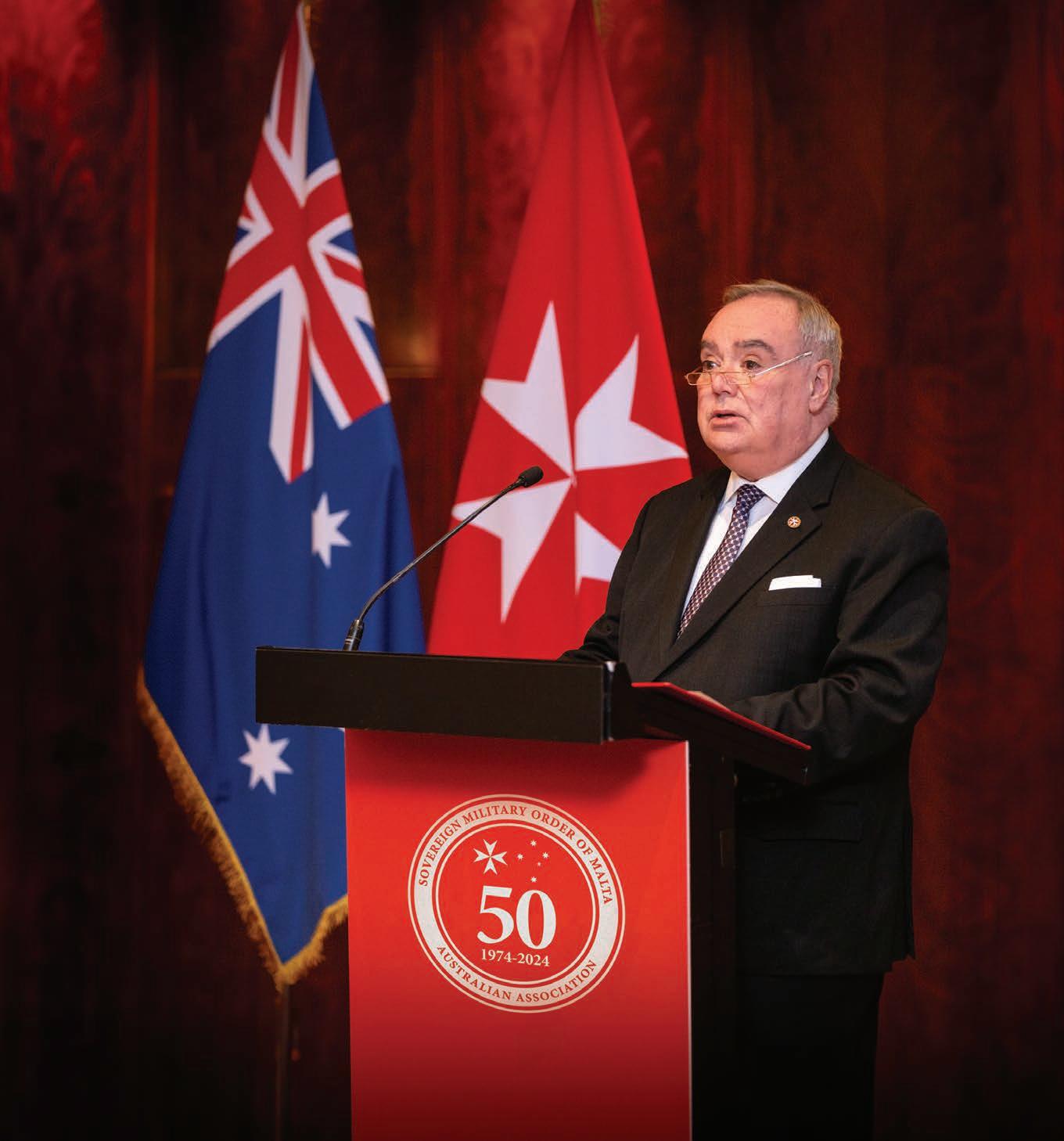

Grand Master in Australia
Mykola Bychok
Monsignor Mykola Bychok C.Ss.R. was admitted into the Sovereign Military of e Order of Malta by Grand Master Fra’ John Dunalp. He was the youngest cardinal to be appointed by Pope Francis in the Consistory on December 8th, 2024.
In 2020, Monsignor Mykola Bychok C.Ss.R. moved to Australia becoming the Bishop of the Ukrainian Emparchy of Saints Peter and Paul in Melbourne and in 2021 was consecrated as third Bishop of the Melbourne Eparchy by His Grace Peter Comensoli, Archbishop of Melbourne.






Welcome 2024 Australian
Welcome to the 2024 Australian Hospitaller magazine, the annual review of the Australian Association of the Order of Malta.
It has been a pleasure to document the important work the Order has been undertaking locally, regionally and globally during 2024.
It has been a very special year for the Australian Association with the 50th Anniversary of the establishment of the Australian entity of the Sovereign Military Hospitaller Order of St John of Jerusalem of Rhodes and of Malta.
We were graced by the visit of His Most Eminent Highness Fra’ John Dunlap, Prince and Grand Master of the Sovereign Order of Malta as well as the Grand Chancellor, His Excellency Riccardo Paterno di Montecupo. e Australian members have only had the opportunity to host the Prince and Grand Master of the Order on one previous opportunity in 2012 when the 79th Prince and Grand Master Fra’ Matthew Festing visited Australian shores.
e Grand Master’s visit was a very special occasion with members having the opportunity to meet him in person during his hectic two week schedule that included stops in Melbourne, Sydney, Canberra, Gold Coast and Brisbane. His speeches were inspiring, his visits to our works upli ing and his humble nature and happy and approachable demeanour was an absolute pleasure to witness.
His hectic schedule included meetings with Government o cials and diplomats, clergy, members and volunteers. e impact it has had and will continue to have into the future is immeasurable.
e Grand Master was delighted with the depth and breadth of our works, and has encouraged us to continue this important work. In one of his presentations he shared the following:
“I encourage new members and volunteers to join in the Order’s works to bring fresh energy and ideas to the Association. e future of the Australian Association will be shaped by the commitment of those who choose to carry forward the mission of the Order.
As we stand on the threshold of the next 50 years, let us do so with hope and resolve… inspired by our faith and by our love for those we serve – Our Lords, the sick and the poor.”
John Murphy KMG Publisher
Publisher: John Murphy KMG
Editor: Monique Gaist
Sub editors: Daniel Kwok KGCMG (Ob) Christine Clancy Design and Production:
Contributors
Dr.

e Australian Association of the Sovereign Military Hospitaller Order of St John of Jerusalem of Rhodes and of Malta
Members of Executive Council:
President:
e Hon James Sholto Douglas KC KHD (Ob)
Vice President: Daniel Kwok KGCMG (Ob)
Chancellor: Frank Zip nger KMG
Treasurer: James Gurry KMG
National Hospitaller: John Murphy KMG
Hospitaller Northern Central Region:
Dr Maria Randazzo DMG (Ob)
Hospitaller North Eastern Region: Danny Higgins KMG (Ob)
Hospitaller Central Eastern Region: Frank Testa KMG (Ob)
Hospitaller South Eastern Region: Paul Hoy AM KSG KGCMG
Hospitaller Central Southern Region: Noel Mifsud KMG
Hospitaller New Zealand: Bevan Killick KMG
Delegate of Communications:
Vice Delegate of Communications:
Anthony Gerada KMG (Ob)
National Communications Manager: Michelle Rees
Communications Associate: Joseph Grogan KMG
Subpriory of the Immaculate Conception
Regent: Professor David Kissane KGCMG (Ob)
H.M.E.H Fra’ John Dunlap Prince & Grand Master visits Australia for the Association’s 50th Anniversary.





06 e Visit of the Prince & Grand Master H.ME.H Fra’ John Dunlap
A personal account of this historical visit, showing all the works e Order of Malta do in Australia.
17 A Piece of History
Baptism of Christ by Giovanni Bellini.
20 A Hospitaller and Pilgrim
A re ection on the role of National Hospitaller, and the people and experiences along the journey.
40 Gerard: Blessed or Saint e endeavour in the Order of St John for the canonisation of its founder.
44 Lourdes Pilgrimage
On the journey to the 66th International Pilgrimage.


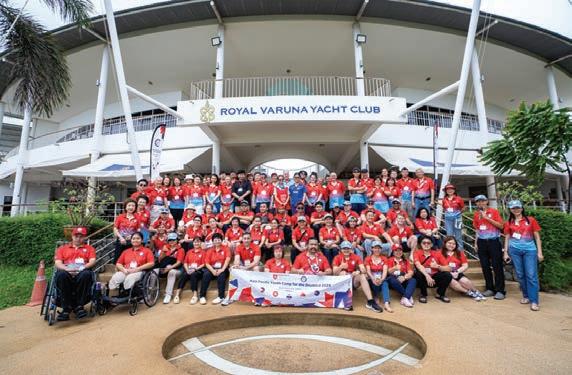

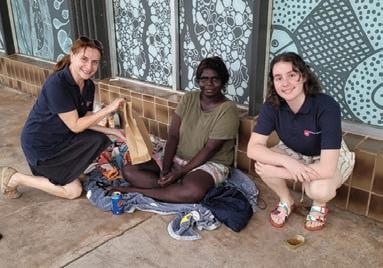
46 e First Knight
e story of Gabriel Jean Du Pac de Bellegarde.
48 Gaza: Historic collaboration
How two of the oldest Christian institutions made it possible to deliver much-needed aid.
52 Did You Know?
e Deed of Donation, a gi that shaped the Order.
54 ailand 2024 Youth Camp
A report from this year’s camp, that took place in Pattaya City, ailand.
56 ACU & e Order of Malta
e Australian Catholic University has been busy in Melbourne with many projects in the Community Hub.
58 e Icon of Our Lady of Philermos
62 Lourdes Day Masses
Reports and photos from this year’s events in Melbourne, Sydney and Brisbane.
64 e Order of Malta in Portugal
A deep dive into the fascinating history of this European Order.
70 Book Review
e 50th Anniversary of e Australian Association 72 Cardinal Merry del Val & e Litany of Humilty 74 Doing God’s Work Not Our Works
76 Obituaries

e visit of
THE PRINCE AND GRAND MASTER FRA’ JOHN DUNLAP
As he toured Australia with the Grand Chancellor, HE Confrère Don Riccardo Paternò di Montecupo and their entourage, H.M.E.H Fra’ John Dunlap was able to experience all the works we do for the Australian Association of the Order of Malta.
A personal account by the Australian Association President James Douglas KC KHD (Ob).
The delegation accompanying the Grand Master included: e Grand Chancellor His Excellency Riccardo Paternò Di Montecupo, Mrs Fabiani Giovanini, Chief of Cabinet, Mr Giovanni Battista Borgiani Chief of Protocol and Mr Fabrizio Timpani Valet to the Grand Master.
Melbourne 23 – 28 October
e Prince and Grand Master, His Most Eminent Highness Fra’ John Dunlap and the Grand Chancellor, His Excellency Riccardo Paternò di Montecupo and their
delegation have travelled to Australia to mark 50 years since the formation of the Australian Association of the Order of Malta.
It commenced on 23 October with their arrival in Melbourne. e rst working session was with the Grand Chancellor during the a ernoon. at meeting was followed by pre-dinner drinks with the Grand Master and the rest of the party followed by a wonderful meal at a local establishment.
Daily Masses were organised for the party during the visit, the rst of which
was held at St Patrick’s Cathedral the next morning. at day was less formal and included a visit to the National Gallery of Victoria and general discussions with our visitors.
On Sunday 27 October we attended Mass at St Patrick’s Cathedral celebrated by His Grace, Archbishop Peter Comensoli, who attended lunch with us nearby – another successful social occasion. e Archbishop expressed interest in the works of the Order. at a ernoon the Grand Chancellor spoke with the Regent and Council

members of the Subpriory. Another meeting later in the day occurred with those who are discerning whether they have a vocation for membership in the First Class. at evening there was a successful meeting with major donors to the Order from the South-Eastern region.
On Monday 28 October our Chaplain, Bishop Terry Curtin, celebrated Mass for us at Caritas Christi Chapel. at was followed by a tour of the facility and conversations with sta and volunteers about the palliative care program. ere was also a meeting with SER Regional Council and members who talked about the works of the Order. We then visited the Royal Botanical Gardens, lunched at South Yarra and had dinner with SER members in our hotel that evening. Awards were presented to three of our members during those proceedings. e successful dinner marked a conclusion to the eventful rst leg of the visit.
Gold Coast And Brisbane
29 – 31 October
We travelled to the Gold Coast and Brisbane on 29 October, visiting Philermos Centre being constructed at Southport as a hub for homeless people, blessing the Centre and lunching with Fr Gerard McMorrow, our chaplain there who has been so actively involved in realising this idea.
When we arrived in Brisbane later that day the Grand Master, Archbishop Mark Coleridge, our chief chaplain, and I had a useful general conversation about the works of the Order and other matters of interest arising out of our shared experiences, particularly with the Grand Master and the Archbishop having spent many years in Rome.
e next day, 30 October, we attended Mass at St Mary’s South Brisbane which the Order uses o en for our liturgies. e parish priest, Fr William Aupito Iuliano, and Fr McMorrow, concelebrated the Mass and the party then visited and had an informal breakfast at Emmanuel City Mission (ECM) adjacent to St Mary’s with the people they assist there. e Order provides extensive volunteer and material support to ECM which is the model the Order will be using for the Southport homelessness project. ECM and the order work very closely together.
We then called on the Queensland Governor, H. E. Dr Jeannette Young. She and her husband were very hospitable and interested in our work. She spoke knowledgeably about the COVID-19 epidemic and her time as Director-General of Health in Queensland. Later that day we had relatively informal meetings with Queensland members at lunch and dinner.
Sydney and Canberra
31 October – 8 November
We ew to Sydney the next day, 31 October, and participated in the vigil Mass at St Mary’s Cathedral and the informal meal nearby a er the Mass when the group had the chance to meet many members in a casual environment
at a nearby pub. It worked well with our visitors commenting how much they enjoyed the evening. On the next day in Sydney there was a casual lunch and an informal meeting between the Grand Chancellor and our Executive Council before dinner that evening.
e centrepiece of the visit occurred on Saturday 2 November with the Investiture Mass at St Anne’s Church Bondi, presided over by Archbishop Anthony Fisher and concelebrated by Archbishop Charles Balvo, the Papal Nuncio, and Archbishop Coleridge who delivered a very e ective homily. e concelebrants included numerous other bishops and priests who are our chaplains. It was a wonderful ceremony thanks in large part to the work of Fr Anthony Robbie, our chaplain and the parish priest, and the local members including Confrère Frank Testa, Neville Zammit and Graham Beal who were rst class organisers. Mass was followed by a morning tea in the parish hall for local members, family and friends. Ten of our members and people who have assisted us over the years were recognised with promotions or decorations within the Order.
A er that the Grand Master, Conf John McCarthy KC and I called on our rst president, e Hon Dennis Mahoney KC, in his apartment. He had been unable to attend the ceremonies but proved excellent company, encouraging us to extend the work of the Australian Association more into the Asia Paci c area. He also showed us many of his mementos of the Order and regaled

Below: H.M.E.H Fra’ John Dunlap centre with Rev Gerard McMorrow and N.E.R Hospitaller Danny Higgins visiting Philermos House Southport, Queensland.
Le : H.M.E.H Fra’ John Dunlap addresses members in Melbourne.

us with stories of his experiences over the years. ankfully the o cial photographer in Sydney, Giovanni Portelli, was there to memorialise the events. e Grand Master presented him with a medal of the Order similar to the one we present to the Holy Father while we presented him with the attractive leather-bound book produced to celebrate our 50th anniversary. Dennis achieved the Centenary of his birth on 26 December 2024!
at evening at the Australian Club we held a very successful commemorative dinner attended by our special guests, Sir Peter and Lady Cosgrove. Sir Peter spoke very well about the Order’s role in preserving civil society as the highlight of a very enjoyable evening.
e next day, Sunday 3 November, we attended solemn Mass at St Mary’s Cathedral, presided over by Archbishop Fisher who later entertained us to lunch at his wonderful residence next to the cathedral. Later that evening we ate with some of the major donors to the Order’s works from the CER.
On Monday 4 December Her Excellency the Honourable Margaret Beasley AC KC, Governor of NSW, entertained us to lunch in the wonderful Government House dining room, another very successful occasion.
e Grand Master delivered a lecture at Australian Catholic University’s North Sydney campus later that a ernoon and received an honorary doctorate from that
University on the same occasion. Later that a ernoon we walked to the tomb of St Mary MacKillop nearby and met the then Cardinal-elect Mykola Bychok, Eparch of the Ukrainian Catholic Rite in Australia, New Zealand and Oceania, with our own chaplain, Bishop Danny Meagher, together with two of the Sisters of St Joseph who live at the convent there and showed us around the Chapel.
e next day, Tuesday 5 November,
we ew to Canberra where we entertained members of the embassies with which the Order has diplomatic relations, together with some members of Parliament, to a reception at the Commonwealth Club. e Grand Chancellor delivered an address at the reception. Many of our visitors from European and South American countries in particular were knowledgeable about the Order and expressed interest in our work here.
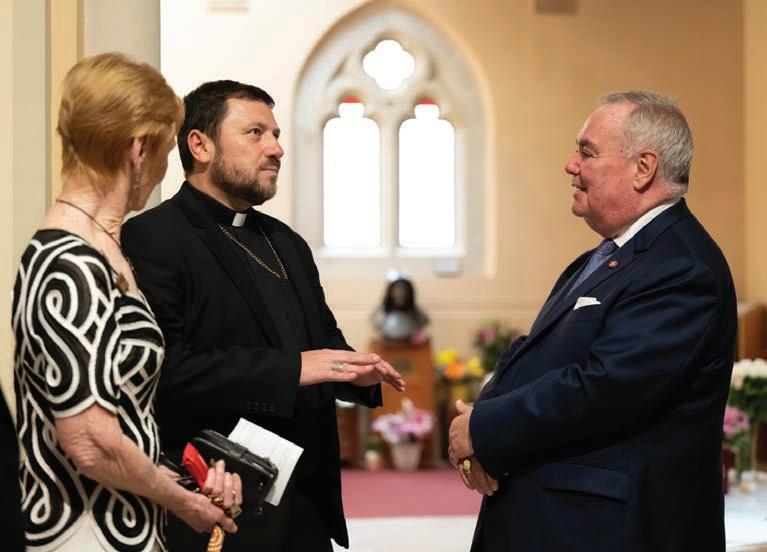


e next morning, we celebrated Mass at the Nunciature where we were also provided with breakfast. Later that morning we had morning tea with the local members, all 13 of whom attended. We then proceeded to Parliament House to call on the Speaker, the Hon Milton Dick, who proved very hospitable. He invited us to sit in the Speaker’s Gallery during question time and acknowledged the Grand Master’s presence while we were there. We also called on the Hon Peter Dutton, Leader of the Opposition, and the Governor-General,
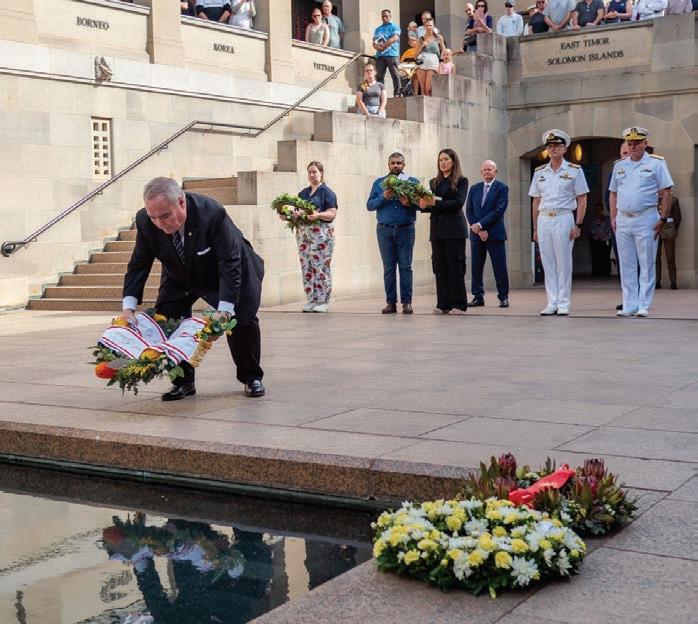
Her Excellency Ms Sam Mostyn AC. ere were another two productive meetings succeeded in the latter case by a tour of Government House’s grounds to show our foreign visitors the resident kangaroos! Again, many photos were taken.
Our last formal occasion was a visit to the War Memorial where we were given a very well conducted tour nishing with the moving Last Post ceremony held each day at 4:30pm at the Pool of Remembrance. It is the second time I have attended that ceremony and, if anything, I was

Le : Mass at St Mary’s Cathedral Sydney.
Far above le : Members and guests at Gala Reception in Sydney.
Above le : Grand Master with the Governor-General of the Commonwealth of Australia Sam Mostyn.
Above right: Presentation at the Australian War Memorial.
Below le : Grand Master with Cardinal Mykola Bychok and Sister at the Tomb of St Mary MacKillop.


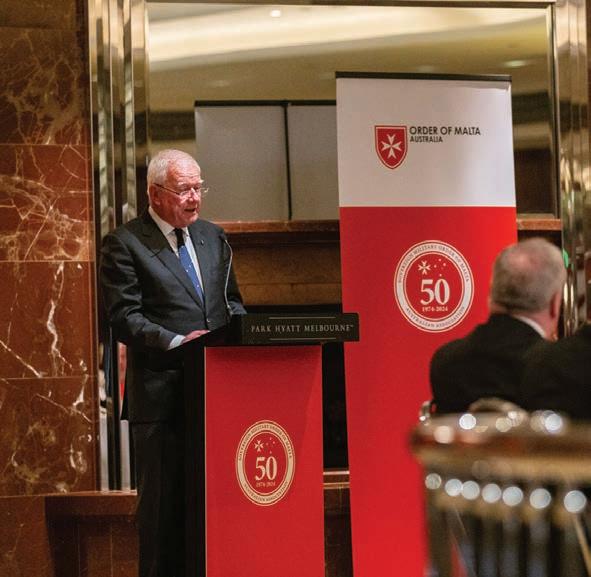
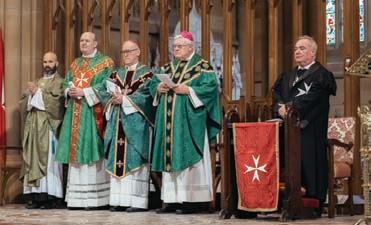

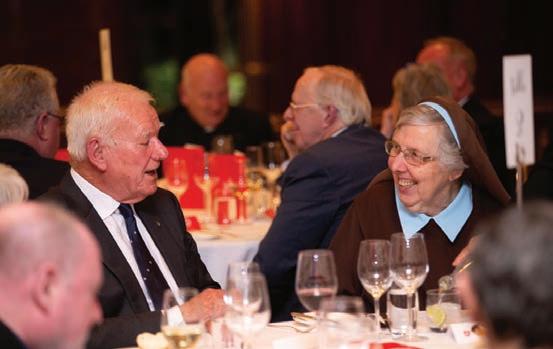
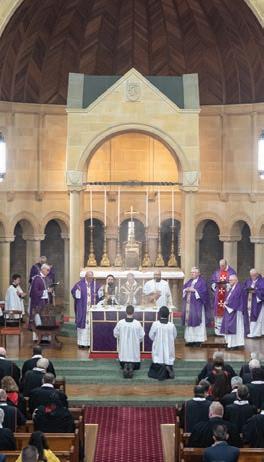









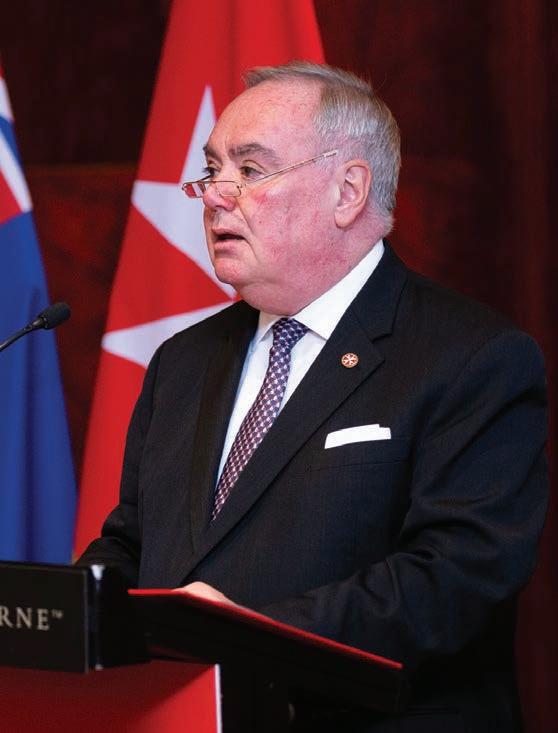





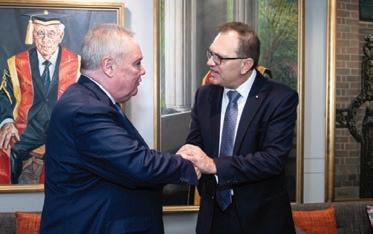



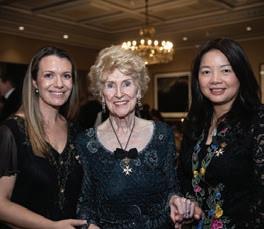

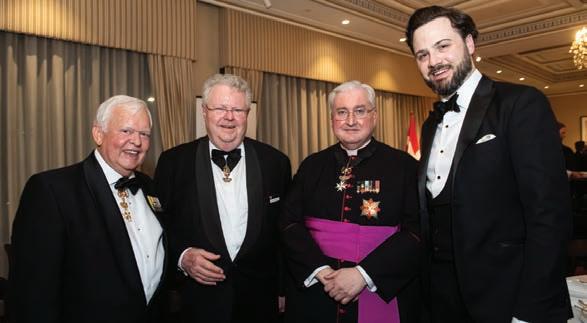
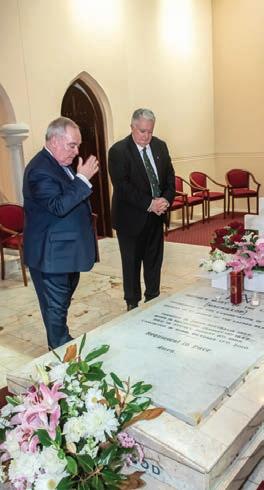


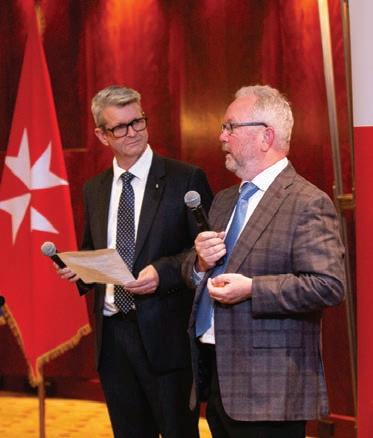

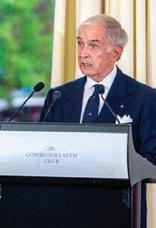








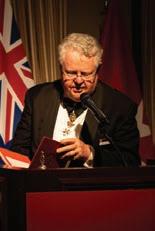
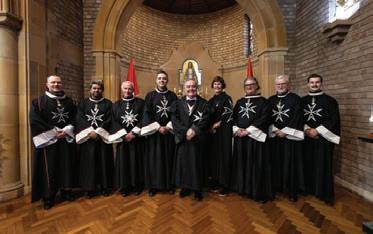





more a ected than the rst occasion last year. e Grand Master was also very impressed with the event and praised it greatly. I urge all members who haven’t seen it to do so next time they visit Canberra.
Our visitors le Canberra the next day for Sydney and le Australian shores on Friday November a er what proved to be a very successful tour.
May I thank Ambassador Michael Mann in particular for his devotion to duty in organising the visit so meticulously and well. He was assisted very ably by our Vice-president, Confrère Daniel Kwok, and so many other members including the Regent, Prof David Kissane, our Hospitaller, Confrère John Murphy, and the Regional Hospitallers, Confrère Paul Hoy, Frank Testa and Danny Higgins together with our Canberra members led by Cons Dr Jennifer Dunlop and Confrère

John Vassallo and Kevin Mann. People such as Confrère Scott Samson and Michael Murphy in Melbourne, Confrère Graham Beal and Neville Zammit in Sydney, Confrère Richard Palk and Brian Kilmartin in Brisbane, Confrère Prof Zlatko Skrbis from ACU and so many of our chaplains, Archbishops Coleridge and Fisher, Bishops Curtin and Meagher and Frs Robbie and McMorrow, also deserve particular thanks. Our indefatigable delegate of communications, Mrs Michelle Rees, was also ever present – o en in the background organising itineraries and smoothing out possible confusion but particularly liaising with the Catholic press in our various cities to publicise the visit so e ectively.
I am sorry if I have le out too many deserving gures.
We should learn from the trip and do our best to maintain and improve the cordial relations I believe we have with the Grand Magistry as a result of our friendship and the hospitality shown to our visitors.
Grand Master urges Australians to keep the faith
e Sovereign for one of the oldest continually existing organisations in the world has warned younger states not to turn their back on religion.
Speaking at Australian Catholic University’s North Sydney Campus, His Most Eminent Highness the Grand Master of the Sovereign Order of Malta Fra’ John Dunlap declared that religion is an integral part of human culture.
“It remains a fundamental component of human development and plays a crucial role in conveying society’s messages, aspirations and desires.”
e Grand Master declared that the longevity of the Order has been due to its faith, tradition and willingness to trust in God and evolve when required.
“With the guidance of the Holy Spirit, the Order has been lucky to discern the sign of the times.”
“Discernment has resulted in certain points of the Order’s history to make minor adjustments to the institution and in other instances, make wholesale changes to meet the challenges of the day and those of tomorrow,” HMEH Fra’ John Dunlap said.
Despite having more than 13,500 knights, dames and chaplains, 80,000 permanent volunteers and 42,000 employees in con ict zones and disaster sites around the globe, the Grand Master echoed calls of the challenges being faced by the needy in a uent nations like Australia.
“ ink of the fate of the homeless and mentally ill living in relatively wealthy countries. ey’re o en neglected and o en le even without strong advocacy groups to call attention to their plight.
“Although these states may have extensive social welfare programs in place, many of the poorest individuals fall through the cracks, and end up living on the extreme margins of society,”

Receiving an Honorary Doctorate at the conclusion of his address, the Grand Master vowed to see the Order continue its mission of God.
“It is a global vehicle to bring Christ to the poor and sick. It is a means by which we give to Christ eyes to see the poor, hands to bless the sick, and bodies to walk the earth”.
His Most Eminent
HMEH Fra’ John Dunlap said.
Highness the Grand Master of the Sovereign Order of Malta Fra’ John Dunlap enjoyed meeting members of the Australian Association.
Association President
e Hon Justice James Sholto Douglas KC KHD (Ob) re ects on a challenging year that tested the Order’s resilience and exibility to assist the poor and the sick, and enabled re ection to strengthen the structure, policies and ongoing work of the Order.
The Order’s experience in 2024 was notable, in particular, for the celebration of our 50th anniversary as an association in Australia. One of our special blessings is that our original president, e Hon Dennis Mahoney AO, KC, is still with us and a continuing source of good advice. He engaged in a stimulating conversation about the Order’s role in the Asia Paci c with the Grand Master on our visit to his apartment a er the investitures at St Anne’s Church at Bondi on 2 November. He celebrated his 100th birthday later in the year on Boxing Day. Let us all keep him in our prayers.
e visit of the Grand Master, Fra’ John Dunlap, and the Grand Chancellor, HE Confrère Don Ricardo Paternó di Montecupo, and their sta , during late October and early November was a particular highlight of the year. I accompanied them on their visits to our operations in Melbourne, the Gold Coast, Brisbane, Sydney and Canberra. It was a rewarding survey of our various operations for the poor, sick, homeless and dying across the country and a powerful display of our devotion to the faith in the liturgies celebrated in those cities as part of our anniversary year.
It was organised particularly well by Ambassador Michael Mann with the assistance of our Regent, Professor David Kissane, and Confères Daniel Kwok, John Murphy, Paul Hoy, Frank Testa, Danny Higgins, Richard Palk, Neville Zammit and so many of our other members and chaplains in the various regions visited along the East Coast. One of the major lessons I think we should learn from the experience for the future is to emulate our forebears in attracting new members to the Order who wish to help expand our work for the poor and sick and in upholding the faith.
It is also appropriate to thank our many supporters during 2024. ey donated more than $962,000 to our works in Australia and overseas. Our previous highest level of donations was $764,000 in 2022. May I congratulate our National Hospitaller and Regional Hospitallers and their helpers for their contribution to these results and also single out Ms Michelle Rees, our communications delegate and long-
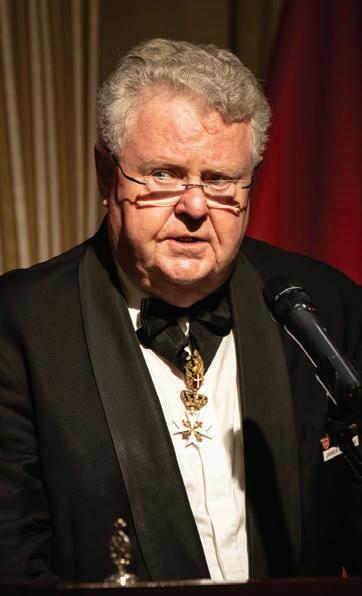
term employee who publicises and helps coordinate our work so e ectively.
Congratulations also and thanks to our chaplains. Cardinal Mykola Bychok was awarded the Dignity and Rank of Baili Grand Cross of Honour and Devotion within the Order in Rome on 25 November. Our Chief Chaplain, Archbishop Coleridge, and Archbishop Fisher were recognised by the Grand Magistry by promotion to the status of Grand Cross Conventual Chaplain ad honorem. Archbishop Comensoli of Melbourne was also appointed as a Grand Cross Conventual Chaplain ad honorem ey were all particularly helpful in introducing the Grand Master and Grand Chancellor to the work of the Order as were Bishop Terry Curtin of Melbourne and Bishop Danny Meagher of Sydney.
e Papal Nuncio, Archbishop Charles Balvo, has also been admitted as a chaplain at the same rank of Grand Cross Conventual Chaplain ad honorem. He was a great supporter of the Order during the visit, helping to concelebrate the Investiture Mass with Archbishop Fisher and Archbishop Coleridge and lending his support to our other events including the celebratory
dinner at which Sir Peter Cosgrove spoke so well.
I wish to mention Frs Anthony Robbie and Gerard McMorrow also for their assistance during the anniversary celebrations. e direction assistance and counsel they gave was invaluable.
We have much to anticipate in 2025. I will represent our association and sub-priory at a conference of Grand Priors, Regents and Presidents of the National Associations in Rome between 28 February and 2 March 2025. I expect to return reinvigorated and full of ideas stemming from our experiences in so many countries and areas of con ict around the world.
We are also examining the position of the Order’s clinic in Dili. Its long-term viability remains an issue for the Order generally, not just in Australia. I visited in September and was impressed by its work. We hope to enter into a joint venture with Malteser International to support the clinic’s work into the foreseeable future. We also hope to encourage more funding from other national associations in the Asia Paci c area in particular and from the Grand Magistry also.
e construction of our hub for the homeless, the Philermos House at Southport on the Gold Coast, should be completed in 2025.
e year 2024 provided many examples of the value of our work here and around the world. One recent example of how it can a ect others was brought home to me in a telephone conversation I had recently with Confrère Marwan Sehnaoui, the Lebanese National Association President. He was very grateful for the funds we had raised to support the work of the Order in that beleaguered country where the Order is so active and e ective throughout the whole community. It is a great tribute to our supporters of that appeal that we can ensure that their generosity is applied directly to those in need.
I look forward to even more e ective work and prayers by us during 2025.
With confraternal best wishes,
e Hon James Douglas KHD (Ob), KC President
BAPTISM OF CHRIST BY GIOVANNI BELLINI A Piece of History:
The large table (216 x 199 centimetres) bearing the inscription IOANNES BELLINUS. P.[lNXIT] in a lea et a xed to the rocky podium on which stands St. John the Baptist, e Baptism of Christ by the artist Giovanni Bellini su ered vicissitudes to which its state of conservation was considerably compromised before the recent restoration.
e work was commissioned in 1500 and delivered in 1504. e altarpiece, which perhaps was originally completed by a lunette, adorned the high altar of the Priory Church as witnessed both by Carlo Ridol in 1648 and Giustiniano Martinioni in 1663.
Forfeited in the warehouses of the Academy at the time of the suppression of the Grand Priory of Venice, the records of 1822 attest to it present in the “deposit of the Commandery of Malta” in poor condition.
It was relocated to the Order of Malta’s Church of St. John the Baptist for which it was originally painted. In 1928 it was placed in a monumental neoRenaissance frame in gilded wood commissioned by the Grand Prior Fra’ Carlo Torrigiani.
In the two-year period from 2013-2014, in the context of the extensive restorations of the Grand Prioral Church that brought to light its splendour, Bellini’s masterpiece was restored by Sandra Pesso, a er extensive preparatory investigations through digital radiography, infrared re ectography and ultraviolet uorescence that brought out the preparatory work.
is intervention has thus made it possible to read the trend of the brush strokes and the signs of the artist’s ngertips and to recover and enhance the high original pictorial quality in which the colours of the landscape of the Jordan Valley stand out.
St. John is depicted in the act of baptising the Saviour in the waters of the Jordan.
e compositional scheme and the gures, with the exception of the client, follow the model used by Bellini in the baptism of Christ painted for the altar in the church of Santa Corona in Vicenza. It is precisely the compositional analogy with the Santa Corona altarpiece that suggests that the panel of St. John the Baptist of Malta was originally completed with an upper panel depicting the Eternal Father.
www.sangiovannidimalta.com/bellini


e
Le : Giovanni Bellini, Baptism of Christ (15001503; oil on canvas, 265 x 410 cm; Venice, Santa Corona), a er restoration. Photo: Musei Civici di Vicenza
Above: Giovanni Bellini, Baptism of Christ 1504. Oil on wooden surface.
Church of San Giovanni Battista dei Cavalieri di Malta in Venice, a er restoration. Grand Priory of Lombardy and Venice.
Subpriory regent
Professor David Kissane, AC KGCMG (Ob) reports on the Subpriory of the Immaculate Conception.

We live through a time of wars, pandemics and tempests where the earth groans with its fractures and violence. is has been called a crisis of non-belonging, an era of individuality, where the Church has been abandoned. Some have termed this the post-Christian era. Our Order of Malta strives to be a counterpoint to all of this; our Subpriory a fraternity of shared prayer and works that unites us with our Creator.
e Holy Father, Pope Francis, has urged renewal upon our Order through its new Constitution and Code, while in parallel he has sought similar for our Church through listening and togetherness, a synodal pathway of pilgrimage with the Holy Spirit. In place of any sense of su ciency, we are challenged to heed the cry of the sick and the poor, the stranger, prisoner, refugee and homeless, healing others through
a brotherhood that Blessed Fra’ Gerard described as rooted in the misery of the world.
In the spirit of this renewal, during the past year, four members of our Subpriory submitted applications to become Aspirant Knights of Justice, which were approved by His Most Eminent Highness, e Prince and Grand Master, together with the Council of the Professed on 4 December 2024. Our prayers accompany these four Confrs, Graham Beal, Dunstan de Souza, Michael Murphy and Sean Parnell, as they pursue this period of discernment. Each is accompanied by a designated Knight of Justice and a Spiritual Director to support, guide and counsel them in the traditions and life of our Order. ey follow a program of formation laid down in the Ratio Formationis and are asked to study Italian, because it is the o cial language of the Order of Malta. During 2024,
they attended spiritual exercises arranged in Rome by H.E. e Grand Commander, Ven. Baili Fra’ Emmanuel Rousseau, and the Cardinalis Patronus, H.E. Gianfranco Cardinal Ghirlanda, S.J. At the conclusion of their Aspirancy, each must apply to the Grand Master for admission to the Novitiate.
Spirituality
During 2024, the Council of the Subpriory moved from the conduct of two to four annual retreats, located in February in Melbourne, June in Brisbane, August at Varroville in NSW and Adelaide in October – a frequency based upon the generosity of our Chaplains and creating the opportunity for members of the ird Class to join with Subpriory members in these three-day programs of spiritual exercises. Members also took part in the annual Pilgrimage to Lourdes with malades and caregivers accompanying, the disabled camp conducted this year in ailand, and the Asia-Paci c Conference conducted in South Korea. While members pray daily with the Church the Divine O ce and attend celebration of the Eucharist, the fraternity of the Subpriory is best felt through attendance at fortnightly recitations of the Rosary in honour of our patron, e Immaculate Conception. is online commitment brings together members from Hong Kong, Singapore, e Philippines, three states of Australia and the Northern Territory to sustain this fraternity that exists across the Asia Paci c.
Membership
Two members were called to heaven during 2024: H.E. Confrère Antony John Macken AM GCM KCOM Poland), (20 January 2024), Knight Grand Cross of Magistral Grace in Obedience and Grand Cross of Merit, a former President of the Australian Association and founding member of our Subpriory; and Rev Fr Professor Gerald O’Collins SJ AC, (28 August 2024), Magistral Chaplain and Past Principal Chaplain of the Subpriory of the Immaculate Conception. Confrère Tony Macken negotiated the creation and initial Statutes of the Subpriory in conjunction with the late Grand Master Fra’ Andrew Bertie and the then Grand Commander (later Grand Master) Fra’ Giacomo Dalla Torre del Tempio di Sanguinetto in 2007. Professor Gerry
O’Collins gave more than 10 retreats for the Subpriory during his tenure as our Principal Chaplain, greatly nurturing the spirituality of its members. We lament the passing of these two Subpriory members.
One of our members, Confrère Jordan Grantham KMG (Ob) had the honour of taking his rst temporary Promise of Obedience in the presence of our current Grand Master, His Most Eminent Highness, Fra’ John Dunlap, at St Anne’s Church, Bondi Beach, on 2 November 2024 during His Highness’s visit to Australia as part of the celebrations of the 50th Anniversary of the Australian Association.
Commencing his year of preparation to take his Promise of Obedience, we have welcomed Confrère John Murphy, KMG and Australian National Hospitaller, as a member of our Subpriory during 2024.
Formation
We have been delighted to have two of our Subpriory members, Confrère Daniel Kwok, KGCMG (Ob) and Consoeur Jennifer Dunlop, DMG (Ob), invited to serve on the Committee for Formation convened by H.E. Confrère Michael K Grace, Coordinator of the Second Class and Member of Sovereign Council, to oversee the creation of the Ratio Formation is for the Second Class. is re ects well on the formation documents used by our Subpriory over the past ve years. It also responds to the change in the CC & C 2022 which altered the Promise of Obedience from a life-long commitment to an initial three-year Temporary Promise of Obedience, which can then be renewed or converted to a life-long promise.
Inherent in taking a Temporary Promise of Obedience is a new program of spiritual development, pursued with the ongoing support of a spiritual director and a Companion from the Second Class. During the rst year of their Temprorary Promise, members are asked to study the Gospel of Mark with their Companion, further develop their understanding of the virtues, the history of the Order, prayer life and engagement with the Sacraments. formation is really a lifelong pursuit!

Papal Knighthood
Alongside Confrère Daniel Kwok’s contribution to the development of formation, we were delighted that he was created a papal knight in the Order of Pope St Sylvester, both in recognition of his work for the Order and his work for the Sisters of St Joseph and local parish. Congratulations Daniel.
Council of the Subpriory Meeting quarterly, the Regent has been greatly supported in the administration of the activities of the Subpriory throughout 2024 by the Council, comprising Vice-Regent Confrère Damian Benson, Chancellor Consoeur Jennifer Dunlop, Hospitaller Confrère Daniel Kwok, Rosary Coordinator Confrère Anthony Gerada, and Consoeur Lilian Santonelli.
e Council was blessed to meet with HMEH the Grand Master, Fra’ John Dunlap, during his visit to Australia and join in the varied celebrations for the blessings that God has bestowed upon the Order during the past 50 years of its activities on this continent and in this region of the world.
My deep gratitude is extended to all of the Councillors and members of the Subpriory for their support and generous activities during this past year.
Le : Most Rev Bishop Terence Curtin Principal Chaplain for the Subpriory o ering spiritual direction and retreat.


Le : Subpriory retreat.
AND PILGRIM A Hospitaller
Association National Hospitaller John Murphy KMG re ects on his role and shares some thoughts from his travels, on the people he has worked with and experiences along the journey.
This year marks the last year in my term as National Hospitaller for the Australian Association. It has been a remarkable experience that has been rewarding on so many levels. I have been able to work with a very talented and united national executive team led by e Hon James Douglas. I have had the opportunity to be involved with the many and varied works of the Order throughout Australia and overseas. e need to be involved with the Order on a daily basis in this role has been a joy and a gi . To be truly immersed gives us the unique opportunity to embrace our charism and develop our faith in ways I had not expected. e experience helps underscore the fact that we are not just an NGO, philanthropic, or charitable organisation, we are a genuine religious Order that helps people develop a stronger relationship with God.
e role of the National Hospitaller is to oversee the works of the Order nationwide and to ensure the proper functioning of the regions. It is the Regional Hospitallers that ensure the execution of the Order’s charitable works at a local level as well as ensuring the spiritual growth of members is supported. Our Regional Hospitallers do the heavy li ing, they have a tremendous workload and carry out their tasks with humility and grace. During the past six years I have seen so many examples of sel ess service to our
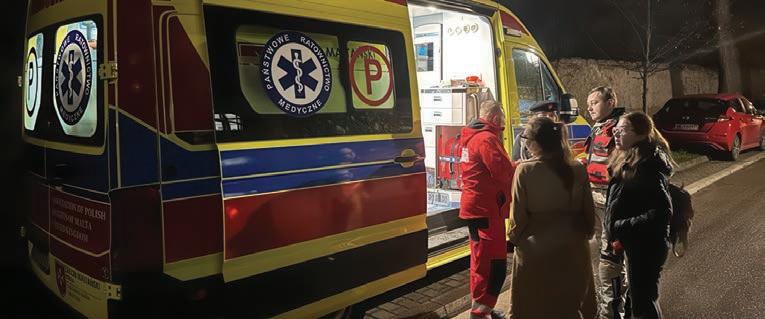
members and those in need that have simply been inspiring. I am so grateful to all of the Regional Hospitallers involved and what they have achieved in the name of the Order.
During my time as National Hospitaller it has also given me the opportunity to develop relationships with Hospitallers around the globe as well as leadership within the Grand Magistry and our worldwide relief agency Malteser International. Requirements to travel abroad to Lourdes, Asia-Paci c Conferences and the International Hospitaller Conferences opened up a whole new world of learning, fellowship and a deeper understanding of our mission and personal spiritual growth. I thought I would take this opportunity to share with you all the international elements of this
role and the journey that has been.
Each year the Grand Hospitaller hosts the International Hospitallers Conference in a di erent European country where he brings together Hospitallers from all over the globe along with OMRO (Order of Malta Relief Organisations) Central and Eastern Europe, Malteser International, Holy Family Hospital Bethlehem and other friends and guests of the Order from around the globe. e Hospitallers Council also come together. is is a working group made up of individuals that are dedicated to our charism and exemplify the life of a Hospitaller in charity and in spirituality. ey are there to assist the Grand Hospitaller ful ll his role and represents our membership from around the globe.


Over the past six years, the conference has been held in Sacrofano just out of Rome in 2022, London, England in 2023, Krakow, Poland in 2024, recently in Vienna, Austria and next year will be held in Hanover Germany and the year a er in Dublin, Ireland. e conference is a chance for Hospitallers to come together and learn directly from each other, sharing successes and challenges. “ e purpose of this International Hospitaller Meeting is clear: to strengthen the Order’s Hospitaller function to better serve our Lords: the Poor and the Sick around the world” said the Grand Master, Fra’ John Dunlap. ere is an incredible level of camaraderie amongst fellow members and just spending time with these like-minded individuals is an incredible ‘shot in the arm’ each time we gather. As you could imagine the relationships continue outside of these meetings. Also as we see each other at Lourdes each year and communicate regularly during the year around project queries and even personal issues.
I have been very fortunate to have a supportive spouse in Tanya who has accompanied me to each of these conferences and shared the experiences together in developing a deeper understanding of the Order and increasing our faith. Tanya was able to develop long lasting relationships with Hospitallers and their spouses. Another unexpected gi from our blessed Order.
e Grand Hospitaller shares the main priorities and the major works we are focusing on around the world, these will change from year to year. Looking back over the journey, COVID-19 was all consuming and the Order was heavily involved in dealing with the sick. en came humanitarian crises in Syria, Lebanon and then wars in Ukraine, Gaza, Lebanon and the Holy Land became major projects for the Order.
Each conference also has a theme, some of them have been safeguarding, dementia and aged care, rst aid and the spirituality of the Hospitaller works. Guest speakers come from all over the globe to share their expertise. We always have strong input and involvement from the Prelate who will speak about the more spiritual elements of our works and then we hear from other members such as the Grand Magistry

Above and below right: National Hospitaller and friends abroad.
Le : Visiting works of the Order in Krakow.
Bottom le : Delegates at International Hospitallers Conference in Vienna.




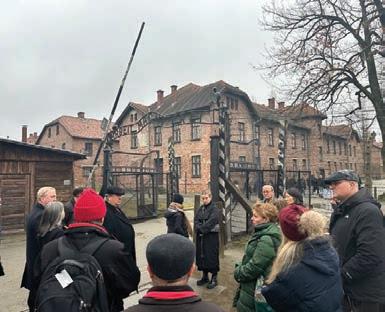
and the Sovereign Council. One of my lasting memories was listening to an Order of Malta member from Ukraine who was one of 3000 rst aid paramedics we had trained to work in the war-torn country. As she explained the Order’s positive impact in the region, she shared that as she was speaking to us her son and husband were at that very moment ghting for their lives and country with guns and grenades. at was a reality check for Hospitallers from Australia.
Malteser International also conduct their Chapter General meeting at the conference where their members come together for the yearly report and vote. Malteser International is the worldwide humanitarian relief agency of the Sovereign Order of Malta. It provides emergency relief and supports recovery e orts in areas a ected by disasters and con icts, focusing on sustainable development. Australia is a member of this organisation and through this we now have a joint venture called MIAP (Malteser International Asia Paci c) which originated from discussions and relationships developed at these meetings. MIAP has the full backing of the Grand Hospitaller and will allow us to have a greater impact in the Asia Paci c region starting with our clinic in Timor Leste as the rst project.
e international conference encourages fellowship between the Hospitallers worldwide. Travelling to these countries is educational in itself, to be able to learn about the culture, history and heritage of the land and how the Order plays a signi cant part in everywhere that we go. I always try to t in tours of the local works to get ideas from outstanding projects. A highlight was a centre for severely handicapped children in Krakow

with world’s best practice and a facility funded and manned by Order personnel and sta .
Another personal highlight was experiencing the liturgies in these di erent places. Participating in a High Mass in a timeless baroque Church and listening to the beautiful music of di erent cultures is an experience in its own right. e New World just doesn’t have anything like it, I can’t begin to describe the magni cence of these experiences. We also have the opportunity to explore the local landmarks of cultural signi cance to Catholics. In the most recent conference, we had the opportunity to visit Mailberg Castle in Austria, the oldest property of the Sovereign Military Order of Malta, having been in our possession since 1146. Also, seeing these traditionally Catholic regions, seeing Church’s open daily for adoration, large groups of people walking the streets reciting the stations of the cross. All these are occasions that warm the heart and grow the soul. We are blessed indeed.
At the Malteser International Chapter General meeting members will talk about the past years performance, work and nance. It is crucial to highlight the works that are done outside of our country so we can make a contribution to everything that is done outside of Australia. is also gives us contacts so we can have an impact through our money which is why fundraising is so essential. is can include funds going toward Ukraine, Gaza or even our Conventual Chaplain in South Africa that has a home speci cally for AIDS e ected children.
We also host the Order of Malta Relief Organisation (OMRO) meetings. OMRO acts as the humanitarian wing of the Order. It provides aid to those who need it particularly in times of crisis. Some of the key projects that OMRO has worked on includes providing support and care for the elderly in Lithuania, providing disaster relief to oods in Romania and working with Malteser International is a key part in OMRO focusing on crisis e ected communities with immediate aid.
Opposite and Le : Travelling to di erent countries is educational in itself, to be able to learn about the culture, history and heritage of the land and how the Order plays a signi cant part in everywhere that we go.

THE NEW GRAND HOSPITALLER
e Sovereign Council appointed H.E. Dr. Josef D. Blotz as Grand Hospitaller of the Sovereign Military Order of Malta.
Dr. Josef D. Blotz (born 22 November 1956 in Hadamar) is a former Major General of the German Army. In his last position, he was Deputy Commanding General of the Eurocorps in Strasbourg (France). Josef Blotz joined the Order of Malta in 1992 as a Knight of Magistral Grace and has been a Member of the Sovereign Council since January 2023.
e Grand Hospitaller’s responsibilities include the o ces of Minister of Health and of Social A airs and Minister for Humanitarian Action and Minister for International Cooperation. He coordinates and supervises the initiatives of the Grand Priories, National Associations and other Order institutions world-wide, all of which are involved in charitable and humanitarian actions and ensures that Christian principles of care and human dignity are respected.
e Grand Hospitaller is assisted by a Council composed of representatives of all the territorial regions in which the Order of Malta operates.
North Eastern Region Hospitaller: Danny Higgins KMG(Ob)
The year 2024 has been full of quiet anticipation for the North Eastern Region of the Order of Malta. A er several years of negotiation, the Order has signed a Memorandum of Understanding with the Archdiocese of Brisbane for establishment and running of the Southport Catholic Care Centre (SCCC).
SCCC will be a ministry of the Southport Catholic Parish with the Order of Malta having management, governance and fundraising responsibilities, assisting Magistral Chaplain and Parish Priest Fr Gerard McMorrow.
e Southport area has for years seen many of the Gold Coast’s most disadvantaged people look to survive on limited government services and groups such as Southport Parish’s Angels Kitchen. e SCCC will bring many of the successful ministries the Order has come to know through our cooperation with Emmanuel City Mission to an area in desperate need of assistance.
e Order and the Parish have been very active leading up to the signing of the MoU with the purchase and initial construction of the Centre at 78 Davenport St, Southport. We anticipate opening the now-named Philermos House mid-2025.
It is anticipated the Centre will provide

meals, clothing, showers and laundry facilities ve day a week initially.
Following the establishment period, it is envisaged to invite third party organisations to operate from the Centre o ering services to improve our guests’ lives on a more permanent basis with better health care, housing and employment opportunities.

Coats for the Homeless e Order of Malta’s Homeless Coats have become a highly anticipated must-have as the colder weather comes upon those with little shelter or comfort. Our members, volunteers and partners have distributed more than 1000 coats, throughout Brisbane, Gold Coast, Toowoomba and the NSW Northern Rivers areas.
Lourdes Healing Mass
Following an extended break precipitated by COVID-19, the Region recommenced a well-attended Lourdes Healing Mass in August at St Mary’s, South Brisbane. Many of those who attended our Healing Masses in past years and many attending for the rst time received blessing and support needed to assist with distress of body, mind and soul.
Inaugural ree Day Regional Retreat
June saw 18 retreatants at Santa Teresa Spirituality Centre in Brisbane for the Region’s inaugural Winter Retreat. Retreat Director Fr John Madden delivered four challenging and engaging sessions that allowed participants the opportunity to consider well-known Scriptural texts in a new and deeper way.
e temptations of Christ, the Garden of Eden, and Jesus providing the Lord’s Prayer, were seen in a new light of revelation with thought-provoking guidance. Fr John had everyone participating in lively discussion.
Liturgies
Regional members have recommenced gathering for the Vigil of the First Friday of each month with celebration of Mass by one of our very supportive Chaplains at St Mary’s, South Brisbane.
October saw a sizeable contingent of members and their families visit St Patrick’s Cathedral and Chaplain Ad Honorem, Bishop Ken Howell in Toowoomba. e contingent was shown wonderful hospitality, with considerable interest shown by parishioners in the Order’s history and ongoing Hospitaller works around the world.
e region had the honour of the Order’s Principal National Chaplain, Archbishop Mark Coleridge celebrating an Advent Mass in early December. is was followed by a dinner for members and guests at the Emmanuel City Mission Complex in South Brisbane. During the evening members and guests were able to congratulate the Honourable Martin Daubney AM KGCMG on his promotion to the rank of Knight Grand Cross of Magistral Grace for his services to the Order within our region and nationally.
Emmanuel City Mission
Members and volunteers continue joyous and diligent service with ECM on the second and fourth Sundays of each month. e Order’s crew prepare and serve a BBQ lunch to ECM’s disadvantaged guests and the Emmanuel Community’s members as the complete their Mass.
roughout the year the leaders of ECM express their thanks for the reliable and dedicated service our groups provide.

NORTH EASTERN REGION

Visit of the Grand Master
e North Eastern Region had the honour of a visit from the Grand Master, Fra’ John Dunlap and some of his group in late October. Fra’ John was especially interested in the Southport Centre project and asked to be kept informed about its progress. His visit included attending a parish Mass at St Mary’s followed by breakfast with ECM sta , volunteers and guests and an informal dinner with members.
e visit was completed with an o cial visit with Her Excellency, Dr Janette Young, Governor of Queensland. During this visit the Grand Master and Her Excellency had extensive discussions, including the need for governments and non-government groups to supply good public health.
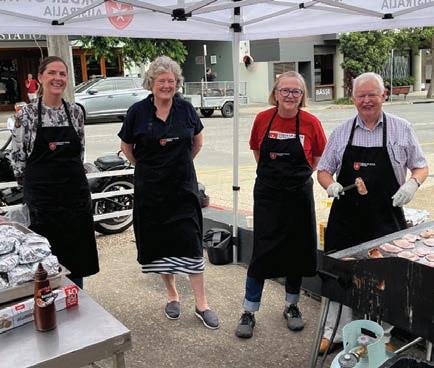
Above: e Grand Master, Fra’ John Dunlap visited the North Eastern Region in late October, seen here with NER members the Pingel family.
Le : e year 2024 has been full of quiet anticipation for the North Eastern Region of the Order of Malta, with ample projects providing food for those less fortunate.
Central Eastern Region Hospitaller:
Frank Testa KMG (Ob)
It has been a very eventful and joy lled year in the Central Eastern Region in 2024, culminating in the celebrations of the 50th Anniversary of the Order in Australia and the visit of our dear Grand Master, Grand Chancellor and their delegation.
ere has been change and an internal operational restructure in the Regional Council which has improved leadership and e ciency in the Central Eastern Region. e Central Eastern Council is looking forward to the new year with the challenges of expanding our membership and volunteer base, growing our established programs, and introducing new programs for member and volunteer engagement with our Lords, the sick and the poor.
It would be remiss for me not to mention the wonderful work and leadership of my predecessor Dr. Stephen Christie as Regional Hospitaller. Stephen has guided our Region through a period of change and opacity, navigating through the challenges that have come with a new constitution and a new national executive structure. We thank Stephen for his leadership and his openness and transparency in addressing members concerns, and we are very grateful that he is continuing as a valued member of the Regional Council in the upcoming term.
Grand Master and Grand Chancellor’s visit to Sydney and Canberra e Central Eastern Region was both honoured and grateful to host both the Grand Master and Grand Chancellor with their delegation in an eventful itinerary over a week in October 2024.
e Grand Master and Grand Chancellor started their visit with attendance at our rst Friday Vigil Mass at St Mary’s Cathedral followed by an informal ‘meet and greet’ session at a local pub for a light meal and drinks. It was wonderful to see the His Most Eminent Highness and the Grand Chancellor engaging with members in a relaxed atmosphere, and really wanting to connect with the membership on a personal level.
Some of the highlights of the delegation’s
visit to Sydney included a visit to the Chapel of our Lady of Philermos and a National Investiture Ceremony at St Anne’s Church in Bondi where a number of new members joined the Order, and one member took his promise of Obedience in the presence of the Grand Master. e Grand Master was then the guest of honour at a reception and awards ceremony immediately a er the event, where several members and volunteers were recognised for their e orts and contribution the works of the Order and the Defence of the Faith.
e Grand Master then paid a personal visit to Confrère Dennis Mahoney at his home to present him with a medal for his e orts in bringing and establishing the Order in Australia and his pioneering work that has ourished into the Australian Association to which we now belong and has taken a lead role in the mentoring and development of the other national associations in the Asia Paci c.
e evening culminated with a National Gala Dinner at the Australian Club, commemorating the 50th Anniversary of the Australian Association.
e following week His Excellency and the Grand Chancellor were guests of honour at Government House, hosted for lunch by the Governor of NSW Her Excellency Margaret Beazley, followed by an a ernoon address at the Australian Catholic University (North Sydney Campus).
e following day the Grand Master and Grand Chancellor travelled to Canberra to meet with members and the Governor General, with a notable visit to the National War Memorial to lay a wreath at the tomb of the unknown soldier.
From all reports Grand Master and Grand Chancellor truly enjoyed their time in Sydney and Canberra, and it was an honour that they made themselves so available to members at a number of spiritual and social events.
Regional Council Visits to Canberra
Members from the Central Regional Council have committed to meeting with Canberran members in Canberra twice a year for a Mass followed by an informal meeting over a meal. is initiative was proposed to ensure that
Canberran members have direct access to their regional council and receive face-to-face contact with their Confrères and Consoeurs in Sydney. It is especially important for those members who have health issues or aged related limitations who have di culty travelling to Sydney to attend events and meetings of the membership. e rst visit occurred in July 2024 and two visits are scheduled for 2025.
Walk with Christ – Corpus Christi Members and volunteers participated in the Archdiocese of Sydney’s Annual “Walk with Christ” processions through the streets of Sydney in early June representing the Order and in a testimony of faith. It was estimated that approximately 15,000 people marched through the streets led by the Blessed Sacrament. e procession commenced at Martin Place and proceeded through the streets to Macquarie Street, making stops at Parliament house, the Sydney Hospital, and the Supreme Court of NSW. e procession concluded at the forecourt of St Mary’s Cathedral where the crowd took part in Benediction and adoration. It was a very moving event, and the order was honoured by being placed at the head of the procession leading the Blessed Sacrament.


Community Care Kitchen
e Community Care Kitchen at Bondi continues to be a leading project for the Order in Sydney. e Kitchen is run by volunteers and members and regularly hosts around 15-25 people for dinner every Wednesday night. is year was the rst occasion that the kitchen opened on Christmas night, and the members and volunteers did not let our regular guests down, feeding them a hearty Christmas dinner and o ering them company and Christmas cheer at this most wonderful time of the year. We thank our regular volunteers and members who keep this wonderful project going.
Order of Malta Care Vans
Our Care Vans continue to service the poor and needy in central Sydney and Parramatta. Members and volunteers are out every week distributing coats and personal care packs to the homeless in the city and showing them with care and friendship in the process. is program has been very successful, and we are hoping to branch out to other cities in NSW in the near future.
Lourdes Day Mass
Our Annual Lourdes Day Mass was held in December and had another wonderful turn out of members and the public who were seeking a blessing and holy water from Lourdes. is year, the mass started a little later in the morning to allow more time for the sick and elderly to arrive, and it proved to be bene cial and will continue to be held
CENTRAL EASTERN REGION

around the middle of the day. We especially thank our members and volunteers who assisted with the distribution of the Lourdes water to the many who attended.
e Feast of the Nativity of the Blessed Virgin Mary - Our Lady of Victories celebration with the Maltese community of NSW
e order was once again invited to celebrate the Nativity of the Blessed Virgin Mary with the Maltese Community of NSW who commemorate the celebration and devotion to Our Lady of Victories at this time. e Order of Malta and the Maltese people have a connection that is not only connected through history, but in spirituality too. It is always an honour for the Order to be invited to participate in this celebration and to, once again, in unison with the people of Malta, honour the Virgin mother for her many blessings and protection.
Dennis Mahony Centenarian
As mentioned previously, our inaugural president Confrère Dennis Mahony reached the age of 100 in December 2024. We thank God for this blessing on Dennis and we congratulate Dennis on this wonderful milestone and for a lifetime dedicated to the Order and establishing the Order in Australia.
e Central Eastern Region has had an exciting year in 2024 and we look forward to extending our current programs of service to the sick and the poor and introducing new programs in 2025.
Above: Commemorating the Investiture Mass with HMEH e Grand Master and HE e Grand Chancellor, Chaplains and Members of the Order. Shrine of St Anne’s Chruch, Bondi.
Top Le : Volunteers working at the Community Care Kitchen.
Above Le : Outreach work serving people sleeping rough in Parramatta.
South Eastern Region Hospitaller: Paul Hoy AM KSG KGCMG
This year, the South Eastern Region (SER) continued to live out the Order’s mission, tuitio dei et obsequium pauperum, through an array of Hospitaller and liturgical works. In 2024 our works would not have been possible without the unwavering commitment of members and volunteers. Your generosity of time and spirit shines through every outreach project, liturgy, and fundraising event, I would like to dedicate this report to all of you.
Palliative care
Palliative care remains a vital focus, with our e orts supporting Eastern Palliative Care (EPC) and expanding volunteer resources at Mercy Palliative Care, enabling endof-life support that upholds dignity and compassion. is year we also concluded our involvement at Calvary Health Care Bethlehem, grateful for the leadership of Anthony Reeves KMG and his volunteers.
Beyond governance, members of the Order remain active in EPC’s volunteer programs, which have garnered industry recognition for their innovative approach. Chief among these is the Biography Program, where volunteers help clients record their life stories, providing both a therapeutic outlet and a treasured legacy for families. is direct engagement exempli es the Order’s mission of serving those at the end of life, not merely through administrative support but through personal witness to the dignity of every individual.
Spiritual Outreach in Melbourne
Since its inception, our Lourdes Masses in aged care homes have aimed to share the grace, comfort, and tangible link to Lourdes with residents. ese special Masses are celebrated by Magistral Chaplains of the Order or invited clergy, who also administer the Blessing of the Sick. Following Mass, our members distribute water from Lourdes to residents, symbolically connecting them to the holy grotto.
In 2024, we were able to celebrate eight out of ten scheduled Masses across various Catholic aged care facilities. Unfortunately, our nal Mass had to be cancelled due to COVID-19-related precautions. Despite this setback, the initiative remained strong and vibrant. Each Mass was supported by Magistral Chaplains Bishop Terry Curtin, Bishop Tony Ireland, Rev. Binh Le, Rev. Kevin Lenehan and Rev. Max Vodola.
Annual Lourdes Day
Mass
is year’s Lourdes Day Mass took place on 10 February, notably the day before the o cial Feast of Our Lady of Lourdes on 11 February and had over 1200 in attendance. Presided over by Archbishop Peter Comensoli, the Mass included the Blessing of the Sick, embodying the Order’s commitment to serving the sick and vulnerable. anks to the splendid work of Sauro Antonelli AM KMG (Ob) and his committee, every aspect, from logistical coordination to welcoming parishioners,

ran seamlessly. e success of this gathering further elevated the Order’s pro le within the Archdiocese and laid a foundation for even deeper collaboration in the years to come.
Grand Master’s Visit
From 23 to 29 October 2024, the SER had the honour of hosting His Most Eminent Highness the Grand Master Fra’ John Dunlap, the Grand Chancellor H.E. Riccardo Paternò di Montecupo, and their accompanying sta in Melbourne. roughout the week, the Region provided comprehensive support, including daily Masses, travel logistics, accommodation arrangements, and various hospitality services. is visit served as a signi cant milestone, allowing our regional leaders and members to engage closely with the Grand Master and highlight the ongoing works of the Order.
During their stay, the Grand Master and his team received a guided tour through the EPC Kew o ces and attended a meeting of the SER Council in the boardroom at Caritas Christi, Kew. Prior to the meeting, Bishop Terry Curtin celebrated Mass in the site’s chapel, bringing a spiritual dimension to the day’s proceedings.
At the meeting, Council members and volunteers presented an overview of the region’s hospitaller and liturgical activities, including:
• Liturgical celebrations supported by members
• Palliative Care Services at EPC, Calvary Bethlehem, and Mercy Health in the western suburbs
• Monthly Lourdes Masses in Catholic aged care facilities
• First Friday Vigil Masses at the Carmelite Monastery in Kew
• Coats for the Homeless winter outreach, supported by student volunteers
• ACU Hub and Read to Learn programs providing community engagement and educational support
A gala dinner provided another forum for engagement. e Grand Master delivered a keynote address, applauding the Order’s

works in Australia, especially in this 50th anniversary year.
A notable part of the evening was a Q&A session led by National Hospitaller John Murphy KMG, featuring our volunteers and program partners. eir shared stories o ered rst hand insights into the impactful service initiatives of the South Eastern Region. Among the esteemed guests were Mother Angela and Sister Rosemary of the Carmelite Monastery, Very Rev. Martin Galea (Superior General of the Missionary Society of St Paul), Ms. Gaylene Coulson (CEO of EPC), as well as Bishop Terry Curtin and Bishop Tony Ireland. In total, 80 guests and members attended, making it a memorable evening of gratitude, celebration, and mutual encouragement.
Community Hub Collaboration
Since its inception in 2022, the Community Hub Collaboration has anchored a fruitful partnership between the Australian Association of the Order of Malta and the Australian Catholic University (ACU).
Guided by a shared commitment to serving vulnerable populations, this innovative initiative operates under a Memorandum of Understanding, bringing volunteers together to upli individuals experiencing disadvantage or marginalisation. Now in its third year, the Community Hub continues to expand its reach and re ne its approach in response to evolving needs within local communities with programs such as the mobile community cafés, Read to Learn and Cooking and Connection.
An exciting addition to the Hub’s portfolio is the Agg Street Gardening Project, funded by a Darebin Council small community grant. is project addresses social isolation, language barriers, and concerns about climate change and food insecurity by installing raised garden beds. e inclusive nature of gardening, coupled with the use of interpreters ensures broad participation and fosters meaningful connections among residents. Also highlighting the Hub’s growing pro le, ACU devoted its annual Vice Chancellor fundraising night on 10 October to showcase the Community Hub’s transformative work.
SOUTH EASTERN REGION
During this event, participants were encouraged to support the initiative nancially, further strengthening its capacity to serve marginalised communities.
Coats for the Homeless Program
During the coldest stretch of the year, our SER teams distributed our specially designed coats and care packs to some of Melbourne’s most vulnerable. In 2024, the program once again exempli ed the Order’s commitment to compassion in action, combining material relief with digni ed, person-to-person engagement.
From April through August, members and volunteers braved Melbourne’s chilly evenings to meet rough sleepers where they gathered. Over the course of each visit, they provided coats tailored to withstand harsh winter conditions, as well as basic necessities such as toiletries and basic clothing items. e e ort aimed not only to protect recipients from the elements but also to remind them that they remain valued members of the wider community.
Central to our 2024 campaign was the community care van, driven each Tuesday and ursday by Michael Murphy KMG and managed by Gerard O’Donnell KMG (Ob), who tirelessly coordinated drop-o s and navigated diverse locations throughout the city.
Working alongside Michael was Jay De Graa , our volunteer coordinator, who ensured every outing was well-sta ed and equipped. Around ten Order members participated regularly, teaming up with enthusiastic students from ACU and Newman College at e University of Melbourne. is combined e ort allowed us to serve upward of a hundred individuals per week.
Even as we celebrated these achievements, we also faced a sorrowful moment with the passing of Rev. Gerald O’Collins AC SJ on 22 August. Fr Gerry, a beloved Magistral Chaplain, Principal Chaplain to the Subpriory of the Immaculate Conception and devoted shepherd to many, embodied the spirit of the Order through his humility, scholarly wisdom, and compassionate service. His funeral brought many of us together in gratitude for his profound impact on the Order and the Church.
roughout the year, our works would not have been possible without the unwavering commitment of members and volunteers. Your generosity of time and spirit shines through every outreach project, liturgy, and fundraising event. As we move forward, may we remain steadfast in service to the sick and poor, inspired by St John the Baptist our Patron, Our Lady of Philermos and the exemplary witness of those members who have gone before us.
Le : Our teams distributed our specially designed coats and care packs to some of Melbourne’s most vulnerable. With the assistance of volunteers from Newman College and ACU.
Far Le : A visit to EPC. e South Eastern Region continues to support Eastern Palliative Care (EPC) enabling end-of-life support that upholds dignity and compassion
Southern Central Region Hospitaller:
Noel Mifsud KMG
On 1 January, 2025, Pope Francis proclaimed a message, emphasizing the importance of seeking true peace granted by God through simple acts of kindness and solidarity. is report re ects on simple acts of kindness and solidarity undertaken by members of the Order in South Australia and Western Australia.
Order of Malta Activities
In 2024, the Order of Malta Southern Central Region engaged in various charitable activities, including the Coats for the Homeless project.
is initiative provided 240 coats to homeless individuals in SA, including clients from organisations including the Sr Janet Mead Adelaide Day Centre, St Vincent De Paul Society, and Catherine House. Coats in Western Australia were distributed across the 2.5 million square kilometres of WA including a special delivery of additional coats to St Pat’s Community Support Centre in Freemantle.
A working bee was organised and
conducted by members and volunteers to pack care hampers (food, sanitary products, and gi s) for Catherine House in support of homeless women a ected by domestic violence. A visit to the Centre was also undertaken in 2024.
Members continued to support the Adelaide Day Centre for the Homeless by preparing and delivering soup, assisting with the evening food van ministry and preparing Christmas treats for distribution.
An a ernoon tea fundraiser was organised in support the Sisters of St Joseph. e Annual Garden Party is a fun lled, high tea that aims to raise funds for the Mary MacKillop Precinct. is laughter lled a ernoon was set in the beautiful Bethany Garden Courtyard. In the spirit of giving, donations of well cared for, but loved, handbags were collected for those in need.
Member News
WA Confrère Dr Michael Shanahan was recognised with the Grand Cross of Magistral Grace for his exemplary service
and deep involvement in the activities of the Sovereign Order of Malta over the past 23 years. Since being received as a Knight of Magistral Grace in 1999, Michael has embodied the Order’s values of Tuitio Fidei et Obsequium Pauperum through his unwavering commitment to nurturing and protecting the faith and serving the poor and the sick.
WA Consoeur, Mrs. Ann Mary Cullity, passed away on 2 June, 2024. Ann was invested into the Order on 21 May, 2002. She served with kindness, solidarity and deep compassion alongside Denis, her husband. Ann and Denis received Papal Honours at St omas More College on September 14, 2008.
Spiritual Activities
Members met monthly to re ect on homilies shared by our SA Chaplain Fr Allan Winter. ese meetings provided an opportunity for members to gather, pray, plan outreach activities and re ect on ways to support the works of the Order nationally and internationally.

SOUTHERN CENTRAL REGION

e 2024 SA members retreat at Sevenhill was attended by our SA and interstate members including our National President Confrère James Douglas and wife Margaret, providing an opportunity for re ection and spiritual growth.
e Annual Morning of Re ection was held at Mary McKillop Centre on June 25 led by Fr Allan Winter.
e Lourdes Mass provided an opportunity for Members to pray for and with the sick, to distribute over 300 bottles of Lourdes water and to speak to the congregation about the works of the Order.
Members participated in the 75th annual SA Marian Procession which was attended by thousands of faithful South Australians. Adelaide Archbishop Patrick O’Regan re ected that the Marian Procession was a wonderful opportunity to gather communities together and provide a prayerful experience with Holy Mary as the focus.
International Engagement
Our National President James Douglas, Confrère Sean Parnell and I were blessed to attend Mass celebrated by Pope Francis in Timor Leste during
his visit from 9-11 September, 2024. e trip provided an opportunity for us to visit the Order’s medical clinic in Timor and to participate in the 25th anniversary of the International Force East Timor (INTERFET) celebrations at the Presidential Palace.
SA Confrère Maurice O’Connell spoke to SA members about his volunteer work in the port city of Odesa in Ukraine. is project supplies an astounding 5,000 packs of food monthly via drones to areas under re. “I have a lot of painful memories,” Maurice told e Southern Cross (SA’s Catholic paper) “Seeing Mariupol orphans at an Odesa orphanage, seeing grown men cry as they tell their stories of loved ones who were killed, some deliberately, villages in which every single house has been destroyed or damaged. Deep pain etched into people’s faces.”
Conclusion
As we re ect on the work of the Order in 2024 I am reminded of the words attributed to St Francis of Assisi “Lord... Love, make me an instrument of your peace. Where there is hatred, let me sow love.”
an astounding 5,000 packs of food monthly via drones to areas under re.
SA Confrère Maurice O’Connell (far le ) spoke to SA members about his volunteer work in the port city of Odesa in Ukraine. is project supplies
Above right: At the 2024 Sisters of Saint Joseph of the Sacred Heart annual garden party at Mary MacKillop Place.
North Central Region Hospitaller: Dr Maria Randazzo DMG (Ob)
Over the two-year period beginning in early 2023, the Region has focused on consolidating and expanding its services in the Northern Territory (NT). e steadfast dedication and commitment of our members and volunteers in providing digni ed service to our Lords the Sick and the Poor deserve high praise.
Outreach service to remote First Nations Communities Visiting Daly River (Daly River) In June 2023, members and volunteers of the Northern-Central Region, led by Father Ched Mloka from St Mary’s Cathedral (Darwin), jointly with St Vincent the Paul Society’s members and a several members of the African Darwin choir, travelled from Darwin to the community of Nauiyu (Daly River) in the Northern Territory to share a time of grace in Christian brotherhood with the Nauiyu First Nations community. Nauiyu is located 230km south of Darwin. e group was warmly welcomed by Fr Rius Baku Salu SVD outside the town’s Church by the Elder community leader, Dr Miriam-Rose Ungunmerr Baumann AM. Dr Miriam-Rose is a Ngan’giwumirri woman and Elder from Nauiyu. A er the Eucharist, celebrated by Fr Rius and Fr Ched and beautifully animated by the Nauiyu choir and the African choir, we shared our gi s (blankets, clothes, food items, hygiene bags and rosary beads) over a morning tea for the community. It was a special opportunity to connect with members of this First Nations Community and with Dr Miriam Rose, who inspired members and volunteers with her way of life and deep understanding of western culture. She said, “We have lived in this country for many thousands of years and 200 years ago we began to interact with white fellas. Since then, we have adapted to a new way of living. We learned to speak your English uently. For years we have walked on a one-way street to learn the white man’s, white people’s way. I’ve learned to walk in two worlds and to live in towns and cities and even worked in them. Now is the time for you to come closer to understand us

and to understand how we live and listen to what the needs are in our communities. When you come to visit or work in our communities and leave your comfort zones, I ask that you bring your knowledge and wisdom, but we ask you also to learn and understand how we live and function in our communities and listen to what our needs are.” Dr Miriam-Rose is a renowned educator, artist, and public speaker, who has dedicated her life to improving educational outcomes for Aboriginal children. In 2013, she established the Miriam Rose Foundation, to bridge the divide between Aboriginal culture and mainstream society –driving reconciliation at a grassroots level. rough her professional and creative life, Dr Miriam-Rose has remained dedicated to maintaining the cultural independence of her people and being a spokesperson for an Aboriginal world view.
Testimony of Chiara, a young volunteer: “I have been fortunate enough to be involved in the Order of Malta community activities in both the Northern Territory
and Victoria. In the Northern Territory we are lucky to be nearby various Indigenous communities such as the Naiuyu community in Daly River. e Naiuyu community are full of life and Dr Miriam-Rose Ungunmerr Baumann AM is a pioneer who has provided an important educational foundation for the Naiuyu community. is has kept the traditions of her people alive whilst allowing integration with external visitors. I thoroughly enjoyed the opportunity of meeting her and the rest of the community, who provided me with valuable insight of their lifestyle and traditions”.
Visiting Emu Point (“Mulyung”)
In October 2023, a small convoy of vehicles loaded with supplies embarked on a journey to Emu Point, traveling through some of the Territory’s most striking landscapes. Emu Point, located in the heart of the Daly River region approximately 220 kilometres southwest of Darwin, is accessible by sealed roads that soon transform into dusty, corrugated dirt tracks as one approaches the community. It was a memorable visit, strengthening the Northern Central Region’s connections of trust and friendship with the Mulyung community. In the words of one of the volunteers, the journey was ‘not just about delivering supplies; it’s about reinforcing our bonds with our brothers and sisters and demonstrating that distance is no barrier to friendship and support. Every kilometre we travel rea rms our commitment to walking alongside them on their journey”. Upon arrival, Fr. Ched Mloka celebrated the Eucharist, a special time of grace with the community members.
Spiritual retreats
e annual retreats were led by Chaplain Emeritus Bishop Eugene Hurley. e theme of the retreat was based on the Beatitudes, the eological Virtues and digni ed service the needy. Members and volunteers were blessed with a profound re ection by Bishop Hurley on how the Church must embody our Lord’s merciful, compassionate, and unconditional love.
Defence of Faith
Two members of the Region have served in the Diocesan Voluntary Assisted Dying Reference Group (ADRG). e ADRG analysed the proposed NT VAD framework and dra ed written submissions to the NT VDA Expert Committee.
Monthly food service
e program aims to provide meals to diverse people experiencing homelessness, typically found camping in bushland on the city’s outskirts or in park areas, choosing locations that make them less visible to authorities or the public and challenging to locate.
As we seek out the homeless, we take the time to ask them about their backgrounds and what brought them to their current situation. eir life stories profoundly touch our hearts. rough serving and listening, we learn about lives marked by courage, resilience, fraternity, simplicity, and faith. Among them are also people with health issues, to whom we have provided rst aid and called for medical assistance as needed.
Distribution of Coats and Blankets to the First Nations People in Alice Springs and Santa Teresa During July and August, several members and volunteers delivered coats and blankets to the local First Nations People in Alice Springs and Santa Teresa. e donations were warmly received.
Hygiene pack distribution for the Day of the Poor On the Day of the Poor, dignity bags containing sanitary products such as sanitary pads, shampoo, toothbrushes, toothpaste, deodorant, soap, as well as small towels and socks, were gratefully received by the most marginalised members of our community in Santa Teresa, Alice Springs, and Darwin.
NORTH CENTRAL REGION

e advocacy service, established in 2014, is dedicated to assisting the most vulnerable and marginalised individuals in the Northern Territory (NT). Its primary focus is to promote social justice and defend the sanctity of life and human dignity.
e service mainly provides administrative assistance with ling and submitting applications, particularly in the elds of migration and minimum age pensions, for elderly, unwell, poorly educated, illiterate individuals, and migrants. Additionally, social support is o ered through referrals to a formalised network of governmental and Catholic agencies, such as Centrelink and CatholicCareNT.
In 2023 and 2024, the Northern Central Region assisted with several cases related to government assistance for aged care, migration, and minimum age pensions. ese issues have been addressed and resolved, and the cases have been successfully closed.
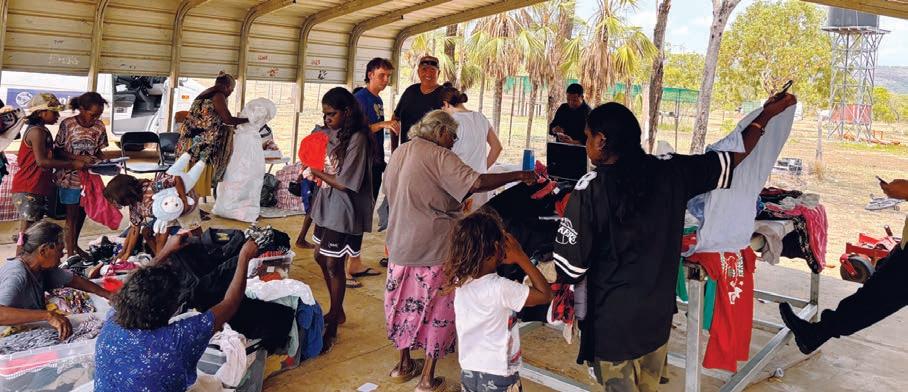
Le : More than providing material assistance, we reach out to understand the inner needs of those we serve.
Advocacy Service
Above: Working with members of the community to serve those in need.

Order of Malta KOREA: Hospitaller Veronica Kim DMG
Following the 12th Asia Paci c Conference in 2023, Order of Malta Korea (OMK) diligently proceeded to adapt to the changes that were introduced during the conference. For clarity and guidance, Confrére Daniel Kwok from the Australian Association visited Seoul, Korea for a workshop in February and helped us better comprehend the Order and reshape our vision for growth, expansion and development.
Based on the knowledge and understanding gained through the workshop sessions, healthy discussions followed throughout the year, which eventually laid out a landscape of where we want to be in a few years of time. As an outcome of such discussions, OMK’s strategy and planning for growth covering directions, structure, spirituality, activities and nances became available in August and the board introduced it to all members and candidates at the Special Assembly in September.
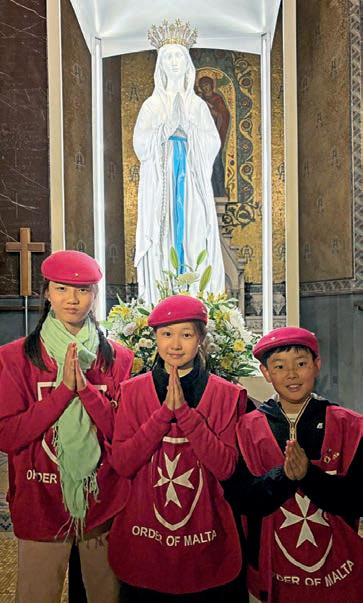
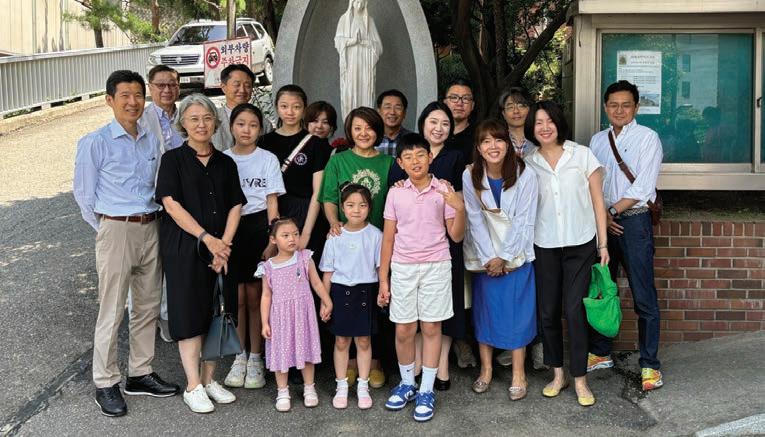
A long-waited Lourdes Pilgrimage took place with the largest number of OMK pilgrims ever. For 2024 Lourdes Pilgrimage, three aspirants participated in the group of total 12 pilgrims from OMK, who formally became candidates shortly a er the pilgrimage. is once again proved that the Lourdes experience presents the core value of the Order that cannot be easily found nor imitated elsewhere.
Inviting our children to join the Lourdes pilgrimage was also bliss, where they got to participate in a number of diverse activities as volunteers, gaining such precious experiences that we feel privileged for.
We were part of an APAC group, which was very well arranged and supported by the Australian Association with such dedicated attention and love. Returning to Lourdes a er the COVID-19 pandemic has been an absolute highlight of the year, which deeply reminded us of the vocation we humbly commit to.
A local pilgrimage also took place on 12 October, 2024 as a way of seeking spiritual growth both personally and mutually. e members, candidates and aspirants of OMK visited Gamgok Maegoe Virgin Mary Catholic Cathedral, which was founded in 1986 by Father Camillus Bouillon and known to have miraculously survived the war in the 1950s.
is also served as a great opportunity to invite those who are interested in joining the Order, as the full-day trip allowed everyone to get to know each other better while experiencing the pilgrimage program.
We are determine to continue our local pilgrimage to further explore the unique history of the Korean Catholicism with the great legacy that our Christian ancestors had le for us to cherish.
e saddest news of OMK’s founding Chaplain Fr. Mathew Jongchan Byun, who passed away on 12 August 2024 at the age of 57, struck everyone. Fr John Ki Sok Pak was appointed as OMK’s new chaplain as approved by the Sovereign Council in November and celebrated his rst OMK Mass on 8 December 2024.
Korea is faced with the worst population collapse in the world and this led to an inevitable increase in the migrant workforce, mostly from the underdeveloped countries. is migrant population already makes up more than 5 per cent of the total population, remarking Korea as a multicultural society. However, the Korean society that is heavily rooted from Confucianism has not transited nor adapted to such change, sadly even within the Church community, as the public tends to prioritise the Korean community with strong fear of cultural and language barriers.
KOREA
e migrant workers who mostly work in factories or farm elds remain invisible, both literally and metaphorically, and the support system provided by the government is nowhere near su cient.
To highlight our mission to serve the very purpose of the Order, and also as an international institution, we decided to focus on the migrant workers and refugees who are undoubtedly one of the most neglected communities in Korea. We spent several months researching the topic and con rmed that this is and will become a bigger issue than it seems now. We also deeply empathised with the idea that humanitarian support should not be preferred based on race, nationality or culture. A er learning the reality that even the Catholic community has trouble nding support, we o ered to step in and help.
As a pilot project, OMK participated in the World Day of Migrants and Refugees 2024 event hosted by Migrant Pastoral Committee of Seoul Archdiocese at Myungdong Cathedral on 29 September 2024 and distributed 1,000 lunch boxes to the migrants and attendees. OMK plans to collaborate further with the committee as a dedicated partner in supporting the migrant community, especially the children and teenagers who are in need of cultural, educational or medical care.
In 2024, our e orts to strengthen spirituality continued through a variety of opportunities to connect with our faith community on a regular basis. Promoting the value of a faithful community that serves the same purpose, the members, candidates and aspirants participated in eight OMK monthly masses at Jeoldusan Martyrs’ Shrine, Seosomun Shrine and St. Francisco Catholic International Parish, and two spiritual formation programs –Easter retreat and Advent retreat–with Fr. Marco Cho.

We closed 2024 with an Advent Mass celebrated by our new Chaplain Fr John Ki Sok Pak with great anticipation that OMK will move forward to a wider community to reach and love those in need. Order of Malta Korea welcomes 2025 as it marks the 10th year since foundation and we pray that our journey remains truthful in God’s name.
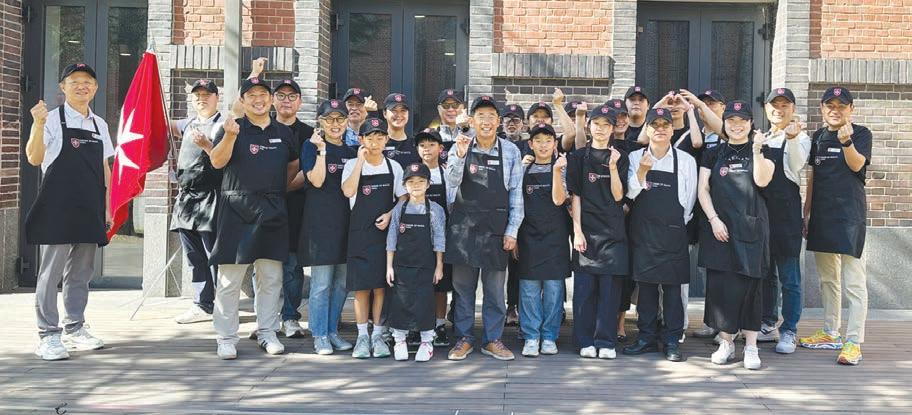
Le to right: Lourdes Pilgrimage with 12 OMK pilgrims including three junior volunteers pictured.
OMK Monthly Mass on every second Sunday where family, friends and aspirants are also invited.
OMK’s pilot project to support migrant workers and refugees at Myungdong Cathedral.
OMK’s Pilgrimage and Spiritual Retreat trip to Gamgok Maegoe Virgin Mary Catholic Cathedral.

Order of Malta ailand Hospitaller: Dr. Anjarat Suthat Na
Ayuthya, Delegate of Communications

Throughout the year 2024, the Order of Malta ailand has carried out numerous activities, including both ongoing initiatives that we have continued over the years and new projects that have been introduced. Additionally, there are various activities and projects that we are working towards implementing in the future, as outlined in the following report.
Continuing Projects 2024
Blanket Donation
At the conclusion of 2024, we successfully donated approximately 3,000 blankets to 10 dioceses, including Chiang Mai, Chiang Rai, Ratchaburi, Archdiocese of Ta RaeNong Saeng, Ubon Ratchathani, Udonthani, Nakhon Ratchasima, Nakhon Sawan, Surat ani, and Chanthaburi.
Wheelchair Donation
We donated 108 wheelchairs to 11 dioceses nationwide. We would like to extend our gratitude to some of our members who personally travelled to deliver the
wheelchairs to patients and various dioceses.
Medical Remedies Donation
We donated medical remedies to seven dioceses i.e. Chiangmai, Chiangrai, Nakhon Sawan, Ratchaburi, Ta Rae-Non Saeng, Udonthani and Ubon Ratchathani.
Signi cant Projects 2024
e day of the Sick @ St. Mark’s Church 13 February and 4 November 2024, marked the 3rd and 4th occasions on which members participated in “ e Day of the Sick” at St. Mark’s Church in Pathum ani Province. Beginning with the Missal and the anointing of the sick, nail cutting and hair trimming. e activities were aimed to support the elderly, the sick, the disabled and the needy members of the community at St. Mark’s Church. More than 100 survival bags, soy milk, diapers, dry food, eggs, rice, children’s toys, and a total of three wheelchairs were distributed.
Moreover, participants engaged in heartfelt conversations, shared

experiences, o ered encouragement, and attended to health and wellness needs. Most importantly, the event emphasised spiritual care.
rough frequent engagement with community leaders, our members have developed close and friendly relationships with them. As a result, many have shown interest in our activities and expressed a desire to become our volunteers.
Asia Paci c Youth Camp for the Disabled 2024 @ Pattaya
On 3-5 September, 2024, the event was beautifully executed and lled with great joy from both the organisers and participants. e Asia Paci c Youth Camp for the Disabled 2024, led by Confrère om Sirisant, Father Carlo Velado, Ajarn Dominic Lim, and the team of Brothers, brought together youth with disabilities from ve countries in the Asia-Paci c region for three full days of enjoyment. Activities included eld games such as archery, balloon popping, and duck walking, as well as the highly enjoyable Christopher Cup Challenge, which this year was won by the Philippines team. All these activities allowed participants to fully showcase their engagement and potential.
In addition, there were simple yet delicious baking skills activities using ingredients readily available in ailand, and traditional ai cra s like making “Pla Ta Pian”. A city tour of Pattaya was arranged, including visits and activities at the Royal
THAILAND
Varuna Yacht Club and Nong Nooch Tropical Garden.
At Nong Nooch Tropical Garden, spectacular performances representing four parts of ailand were performed, an impressive elephant show, and the highlight for many, the elephant rides. Alongside the fun, we dedicated time to spiritual re ection, including daily Missals, praying the Rosary, and participating in the Candle Night Walk in honour of the Virgin Mary.
Ad Hoc Activities 2024
Donation for Flood Victims
e Order of Malta ailand extended support to those a ected by ooding on two occasions. Donations were made through the Diocese of Chiang Rai and through the Catholic Bishops’ Conference of ailand.
Camillian Home for Children Living with Disabilities in Ladkrabang
e Order of Malta ailand extended help to children living with disabilities @ Camillian Home in Ladkrabang District. In this regard, we donated funds and essential supplies to the children.
Sribang-on Learning Centre in Sakhon Nakhon
Order of Malta ailand have extended some support to this centre as it serves as a learning hub that provides meaningful activities for young generation in the community a er school. e centre o ers bene cial programs such as English language classes, Catholic knowledge and encourages the youngsters to develop a sense of volunteerism by engaging in humanitarian e orts, such as visiting the elderly, the sick and bed-ridden patients.


Funding Hospitaller Works
e sources of funding for the Order of Malta ailand to support its various missions come from:
• Self-funding
• e registration from Asia Paci c Youth Camp for the Disabled 2024
Highlighted Project in 2025
Since the launch of the Neighbourhood Care project in 2023, we have initiated e orts at St. Mark’s Church, establishing it as a model community where neighbours care for one another to foster a strong supportive and sustainable environment.
As part of this initiative, we convened discussions and agreed to set up a “Medical Service Unit” at the Church. is facility will serve as an initial care centre initially utilised by community leaders to use for their community members, particularly the sick, the elderly, and bed-ridden patients who face mobility challenges. e Medical Service Unit will be equipped with essential medical remedies, including basic household medicines, wound care materials, saline solution, gauze, antiseptic solutions, and irrigation syringes, among other necessities, to provide primary healthcare support to those registered in this community.
Our Vision for 2025
• We are continuously keen on obtaining better living conditions for the sick and the needy.
• We advocate for fostering mutual support among neighbours within the community.
• We are continuously keen on gaining more volunteers.
• We continuously align our projects with Laudato Si scheme of Pope Francis.
Le : e Asia Paci c Youth Camp for the Disabled brought together youth with disabilities from ve countries in the AsiaPaci c.
Above: e Order of Malta ailand extended support to those a ected by ooding.

New Zealand Hospitaller:
Bevan Killick KMG
Ahakoa he iti, he pounamu (Translates to “Although it is small, it is precious like greenstone.”)
In Aotearoa New Zealand and in Māori culture it is usual to start an address or an article with a Whakataukī (proverb). e Order in Aotearoa New Zealand is certainly small, but continues to thrive despite its size with some great accomplishments to re ect on. e year has seen, what would be deemed in our culture Kua hinga te tōtara i Te Waonui a Tāne. (A tōtara has fallen in the great forest of Tāne.); with the passing of the Honourable Peter Gresham KMG ONZM JP. Peter was considered one of our great founding fathers. Peter will be reunited with his loving and devoted wife and Order member, Margot as they receive their eternal reward in heaven.
We were delighted that two members of the New Zealand whanau (family) were elevated as the oldest and youngest Cardinals.


His Eminence Angelo Cardinal Acerbi New Zealand’s former Apostolic Nuncio (1974-79), then Archbishop Angelo Acerbi, was at the tender age of 99 elevated by His Holiness Pope Francis, to the rank of Cardinal. Cardinal Acerbi was instrumental in establishing the Order of Malta in New Zealand, along with Peter Wood and the late Peter and Margot Gresham. Cardinal Acerbi served as the Prelate of the Order of Malta from 2001 to 2015.
His Eminence Mykola
Cardinal Bychok CSsR
In April we hosted a group of Australian bishops as they decompressed from their ministry on the West Island. ey were led by Order of Malta Chaplain and proud New Zealander Bishop Richard Umbers, Auxiliary Bishop of the Archdiocese of Sydney. Among their number was Melbourne based Bishop Mykola Bychok CSsR. His diocese for the Ukrainian Catholic Church covers Australia, New
Zealand and the Paci c. Bishop Mykola o ered Grace at the Canterbury Club’s Annual Anzac Dinner. Six months later Bishop Mykola Bychok was elevated to be a Cardinal at the same time as Cardinal Acerbi. Cardinal Mykola Bychok was 44 when he was created a cardinal, making him the Church’s youngest cardinal currently. Later in the year a few days before his elevation, we were delighted to see the Grand Master present the then CardinalElect Mykola Bychok with dignity and rank of Baili Grand Cross of Honour and Devotion of our Order.
Peter Wood received the Grand Cross of the Order
We were delighted to see our former National Delegate Confrère Peter Wood recognised with the Grand Cross of the Order. Peter has diligently applied his encyclopaedic knowledge of matters pertaining to the Orders of St John to the protection of the symbols and trademarks of

NEW ZEALAND
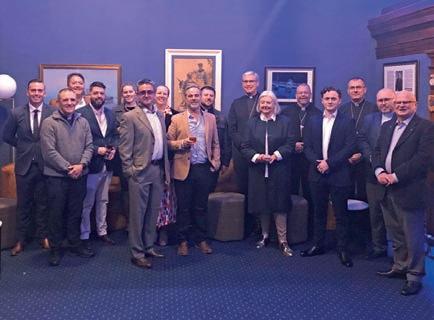
both the Sovereign Military Order of Malta and the Most Venerable Order of St John. Peter is a Knight of both Orders and we continued to have an irritating spurious order attempt to operate on our shores. Groups attempting to pass themselves o as credible by using our names and symbols is unacceptable and are an unwanted distraction. Peter’s thankless work across both mutually recognised Orders is outstanding. Peter is a quiet achiever and has guided the Order in New Zealand throughout its entire existence. He has been instrumental with our work with the Home of Compassion and the Daughters of Our Lady of Compassion and their soup kitchen for the destitute and rough sleepers of Wellington. Peter has had a very distinguished career as a civil servant in Wellington. He served as the Prime Minister’s Principal Private Secretary when the Rt Hon Dame Jenny Shipley DNZM was Prime Minister. Hearty congratulations Peter!
A Convocation of Bishops
As mentioned earlier in April we were delighted to host Order Chaplain Bishop Richard Umbers and a group of bishops having a break from their usual busy routines. We were honoured to host them for dinner at the historic Canterbury Club and join them for Sunday Mass in Christchurch’s Pro Cathedral. We were joined by Bishop Michael Gielen, Bishop of Christchurch. Bishop Mykola o ered Grace at the Canterbury Club’s Annual Anzac Dinner and gave First Holy Communion to two young men from the New Zealand Army who were welcomed into the Church during his visit. One was a Logistics Lieutenant who now has the Hospitaller as his Godfather and Con rmation Sponsor. e other is a previously Baptised Corporal who had recently returned from training Ukrainian soldiers in the United Kingdom. He has the Hospitaller as his Con rmation Sponsor and has recently been back in the United Kingdom training Ukrainian soldiers.

Lent and Easter Observances
Christchurch based members, aspirants and friends attended Ash Wednesday and the annual Chrism Mass at St Mary’s Pro Cathedral. ese occasions and others are regular events in our calendar where we can share our faith.
Feast of the Immaculate Conception
Members and friends gathered for the Choral Mass at Christchurch’s St Mary’s Pro Cathedral on Sunday 8 December. Confrère Peter Wood joined us from Wellington. He was recently back from the Grand Master’s visit to Sydney and his well-deserved investiture as a Grand Cross.
Toward the future
We continue our work for the Order and also have to recognise the good work of members in their own lives. We are challenged by our members being geographically spread out throughout the country. Many of our enquiries are from cities where we don’t yet have an establish presence.
Whāia te iti kahurangi, ki te tūohu koe, me he maunga teitei. (Pursue that which is precious, and if you stumble, let it be upon a lo y mountain.)
Chris
Bevan Killick, Damien Walker, Mindy Gregorini, Bel ore Bologna, Jacqueline Killick, Prof Pablo Gregorini, Bishop Mykola Bychok CSsR, Bishop Richard Umbers, Abina Pope, Bishop Columba MacBeth-Green OSPPE, Nathaniel Farrell, Archbishop Emil Shimoun Nona, Bishop Karol Kulczycki SDS and Fr Brian Fennessy ED.
Le : Anzac Dinner – Abina Pope DMG, Cardinal Mykola, Bevan Killick KMG.
Above:
Walker, Bishop Michael Gielen,

GERARD: Blessed or Saint?
Since 2021 there has been an endeavour in the Order of St John for the canonisation of its founder, Blessed Gerard, thanks to the e orts of Special Delegate to the Order Cardinale Silvano M. Tomasi. Dr Dane Munro KM works through the arguments for the canonisation
The Order of St John found its cradle in a trading post established by Amal tan traders in Jerusalem in 1048, which included a monastery and a hospital. A certain Gerard, from the Amal region, appears in 1070 and becomes a visionary leader of that hospital. at this institution of Blessed Gerard is still going strong a er nearly a millennium, is surely the will of God. However, having Blessed
Gerard recognised as Saint Gerard will be a great recognition of the members and volunteers of the Order. Furthermore, it is a testimony of the faith of millions of people who have been assisted by the Order and the millions who will be assisted, motivated by the Order’s motto: Tuitio Fidei et Obsequium Pauperum, at present interpreted as nurturing the faith and upholding human dignity.

Introduction
Jerusalem was the holiest site of Christianity, the place of the Lord. Over the centuries, there had been various initiatives to build and maintain Christian pilgrims’ hospices in Jerusalem, the very place where the Lord Jesus Christ had lived, died, was buried and was resurrected. Between c. 1070 and 1120 the former Amal tan hospice is then under the new management of a man generally known as Gerard.
Gerard appears in contemporary documents by name, as collated by Perta, and by inference, his deeds have become legendary and his reputation miraculous. It can be gathered from later developments of the Hospital that Gerard was a visionary, who also proved to be a very versatile administrator, endowed with intelligence and entrepreneurial insight. He is perceived as an exemplary Religious leader and became a gurehead of Hospitaller identity. Gerard was a dedicated person who, with a piety-driven resolve, built his hospital on Scriptural values, and, mirroring Jesus Christ, was a revolutionary out-of-the box thinker, applying his belief in God to set up a humanitarian society which exists and thrives today, albeit modi ed but not from its founding principles.
Many historians of the Order have recorded the works and achievements of Blessed Gerard. For example, Giacomo Bosio’s book Dell’Istoria della Sacra Religione et Illustrissima Militia di San Giovanni Gierosolimitano (1598), is considered a primary source for understanding the early history of the Order of St. John. Bosio presents Blessed Gerard as the rst Grand Master of the Order and provides a detailed account of his activities, accomplishments and character. He wrote about Gerard as a great leader, with military and diplomatic skills, and a great dedication to the welfare of the sick and the poor. Bosio describes Gerard’s role in the foundation of the Order and the early years of its existence, with
the emphasis of his Saintly character and his alleged miracles. ese miracles are known through four manuscript copies from the 14th Century. Such miracle stories were continually evolving and the oldest copy is of 1307, reproduced in a translated version from Latin into Anglo-Norman, from a lost Latin original from the 1180s. A Papal Bull of Pope Celestine III, Quot et Quantum, dated 16th July 1191 accepts the miracles as foundation acts. Pope Innocent IV re-a rms the miracles in his own bull.
A er his death, Gerard’s standing as a Saint rapidly spread throughout Europe and was especially popular among the members of the Order. Gerard was considered as one of the patron Saints of the Knights Hospitaller, and many churches were built in his honour. However, he was never o cially canonised by the Roman Catholic Church. Nonetheless, some Christian denominations do hold him as a Saint and the Order considers him as a Saintly man, who has found his way into the liturgy of the Order: e Prayer of the Order is well-known and it is part of the modern Hospitaller self-image and sums up what a modern Knight or Dame stands for or should be standing for. In this manner, Gerard’s memory is incorporated with the Hospital and its continuation, and the Hospitaller self-image is based on his sel ess deeds, sel ess giving rather than sel sh taking, indefatigable determination, foresight, critical thinking, honesty and his resilience in face of adversity, not unlike the characteristics attributed to his Patron Saint, John the Baptist.
e rst signs of Gerard’s Sainthood Nicholson maintains that in the rst 200 years of existence, individual members of the Hospital and the later Order did not have personal sepulchral slabs and monuments. On their graves, a simple cross was engraved, although some commendators had obtained a slab with an engraved image of a deceased brother. A notable exception is the inscribed text from the tomb of the founder, Gerard, which has survived in literary sources and is probably the rst prominent expression of Hospitaller memoria. A er a long service to the Hospital, Gerard passed away on 3 September 1120. e following inscribed text of the sepulchral slab of Girardus Hospitalarius, found at the Hospital, is included in Hagemeyer:
Here lies Gerard, a most humble man among those of the East, a servant of the poor, devoted to pilgrims, of simple appearance but shone forth with his noble heart.
Within these walls, it becomes clear what a virtuous person he was. He was properly foresighted in his many undertakings. He achieved numerous successes of various kinds. He expanded diligently into many countries to supply his own [hospital].
On the seventeenth day of the passage of the sun under the sign of Virgo the angels carried [his soul] into heaven.
In Palestine, in the time of Gerard’s death in 1120, people were still living in the feudal period, and presumably there was a very sharp division between Heaven and Hell, in line with the contemporary understanding of the Gospels of Matthew and John. What can be presumed is that Gerard was buried by means of a Christian ritual and commemorative masses were celebrated to remember him and his work. It is also presumed that his grave was regularly visited, and his inscription read and used as educational material. It is maybe too much to suggest that his grave became a pilgrimage attraction in its own right, as contemporary sources are silent about this. However, I do suggest that Hospitaller culture of memoria started with Gerard.
e last line of Gerard’s epitaph reads that his soul is carried straight into Heaven as if he was considered a Saint. All people who qualify as faithfully departed and who are in Heaven, are Saints. Not all Saints are equal, as Canonised Saints are selected to present the believers with an exemplary person who embodies best the ideals of the Church. In the case of Gerard, he embodied the supreme values of Christ and John the Baptist, externalised in his Hospital and in the later Order, which infers that the Hospitallers in the Latin Kingdom held him as a Canonised Saint. ere are some good reasons why they did so. e research of McCleary and Barro of Vatican documents reveals that ‘the rst path to canonisation is a life lived by practicing virtues in an exemplary manner and with heroism’. ey further argue that: ‘ e second path, not exclusive from the rst, is through devotional cults supported by the “constant and common attestation” of credible historians on the saintly person’s virtues.’ Gerard, in the mind of Riley-Smith, in an era of very original founders of new religious institutions, ought to have ranked very highly, since the ethos of the early Hospital was a clear departure in religious thinking. As servus Ospitali and a Custos Pauperum (still a current title of the Grand Master), Gerard can also be credited both with founding a religious Order and a Hospitaller institution, making the organised care of the sick and the poor a permanent feature in societies worldwide. A very solid example, for the sake of comparison, is the canonisation of the Seven Holy Founders, of the Serviti di Maria, also called the Seven Servite Founders. ey were canonised in 1888. As a group, they had founded this religious Order in 1233. is shared canonisation freed the Papacy of the burden of proof of three post-mortem miracles of each of the seven founders. is argument can be applied to Gerard too, as many founders of religious orders were sancti ed.
His sancti cation has little to do whether one would favour or despise the Order of St John. Contemporaries and later medieval historians may have derided the Order of St John for its wealth and opulence, and, over time had expressed very negative opinions of the Order, such as William of Tyre, who echoes some of the content of canon IX of the III Lateran Council: ‘ e Hospitallers are arrogant and have liberated themselves from episcopal authority’. However, they are in unison when it comes to Gerard, the founder: without exception they sing his praises as


a holy and most pious man. ere are many references to Gerard which can con rm the above. Gerard, according to some of the early sources mentioned, such as William of Tyre, was quidam Geraldus, vir probatae conversationis (a certain Gerard, a man of wise conduct). He also thought that Gerard was ‘a man of venerable life, renowned for his piety’ and as ‘a good man, who rendered devoted service to the poor’ in a hostile environment. Jacques de Vitry, quoted by de Vertot, in his Historia Hierosolymitana, adds that a Gerard was a vir quidam sanctae vitae & probate Religionis nomine Gerardus, a certain man of a pious life and a proper Religious by the name of Gerard. Jonathan Riley-Smith presents a few researched opinions about Gerard, such as that: ‘It was believed in the West that he had died in a holy frame of mind.’
In this context, it a perhaps good to be reminded of the Bull of Pope Urban VIII, issued in 1643, Coelestis Hierusalem Cives Urban VIII wrote that he did ‘not wish to prejudice the case of those servants of God who were the objects of a cultus [cult] arising out of the general consent of the Church, or an immemorial custom, or the writings of the Fathers, or the long and intentional tolerance of the Apostolic See, or the Ordinary’. According to Beltjens, it was around 1613 that Gerard was traditionally called a Saint rather than blessed by the Order. Since this tradition was never contradicted, Gerard may be regarded sancti ed by tradition, as referred to by Pope Urban VIII above mentioned. e di erence between a ‘Saint’ and a ‘Blessed person’ lies then in the scope of the matter: devotion of a ‘blessed person’, is normally localised, such a speci c group or region, while a Saint’s devotion is worldwide. e Order regards itself as globalised as the Christian religion itself, and not a localised cult.
A Heroic Account
Among the miraculous stories of Gerard, one highlights his resilience and strength, while the other is a true miracle. e rst account, found in William of Tyre’s writings, takes place in 1098 when the Egyptians reclaimed Jerusalem from the Seljuk Turks. Facing the imminent arrival of the First Crusade, the Egyptians forti ed the city and sought to secure the loyalty of its inhabitants by exempting them from taxes. To o set this generosity, they imposed a heavy tribute of 14,000 gold pieces on the remaining Christians, collected through forced payments, con scations, and torture. At this time, Gerard, known for his piety, managed the Latin hospital in Jerusalem, caring for the poor and pilgrims. e Egyptians suspected he concealed a treasure and viewed him as a
potential threat once the Crusaders arrived. He was imprisoned, beaten, and tortured so severely that his limbs became nearly useless. eir suspicion was not unfounded –Gerard’s hospital had long received alms and overseas donations. Yet, despite his su ering, he never revealed any secrets. While not inherently miraculous, his steadfast endurance under extreme torture and his continued dedication to his Hospitaller work despite severe physical impairment make a strong case for recognising him as a confessor Saint. Confessores are Christians who underwent su ering for their faith and were maimed, tortured or su ered physical mutilation. Some Confessors died for their faith, becoming martyrs. Kelho er states that those Confessors with permanent injuries, e.g. with missing eyes or maimed ankles, had great authority. As it stands now, Gerard can be classi ed as a Confessor, a living Saint who did not die as a martyr because that kind of death was denied him – God needed him for a higher purpose and therefore had to resist succumbing to torture. is paper argues that Gerard was entitled to become a Confessor Saint, since he was tortured by the Egyptian rulers of Jerusalem. e Egyptian authorities took Gerard to prison, beat him and tortured him so terribly that ‘the joints of both his hands and feet were wrenched apart and his limbs became practically useless.’ Notwithstanding being severely crippled for life, Gerard continued to lead his hospital. It is to his charitable disposition that he kept on serving Muslims in his hospital and did not nd them guilty by association to what was done to him by their fellow-believers. Furthermore, Gerard has been attributed with miracles and has been venerated for more than 900 years a er his death in 1120.
e Miracle of the Bread and Stones Gerard’s miracle unfolds as the Crusaders lay siege to Jerusalem. Despite his injuries, he sought to aid the starving Crusaders and pilgrims. He gathered bread in his mantle and hurled it from the city walls multiple times a day, disguised as if throwing stones. Eventually caught, he was searched, yet the bread had miraculously transformed into stone. e Egyptian authorities, deceived by the miracle, commanded him to continue throwing ‘stones’. Following the Crusaders’ capture of Jerusalem, Gerard was rewarded for his e orts with numerous properties to support his hospital. However, the true miracle was not merely the transformation of bread into stone, but that this seemingly disabled man continued his mission for two more decades. Under his leadership, the hospital ourished, expanding into a network of care that still exists today. His 50
years of service demonstrated remarkable vision and independence, laying the foundation for an enduring institution that continues to serve the sick and needy. Gerard’s miracle of the bread turning into stones suggests that in the 13th Century the Hospitallers already venerated him as a Saint and his memory was externalised through the preservation of his relics. Gerard’s cadaver had been translated to Acre by those Hospitaller brothers allowed to stay in Jerusalem for one year a er Saladin had conquered the city in 1187. In Acre, it is presumed that the whole body, as a relic, would have been placed in reliquary beneath an altar or in a shrine. is presumption is not uncontested, as the detailed research of Beltjens shows. His opinions based mainly on the lacuna of documents which would con rm or deny Gerard’s status of Blessed or Saint. According to Alain Beltjens, the relics of a Gerard were brought over to Manosque by the commandator of Manosque in 1283, Bérenger Monge, possibly to emphasise the Provencal superior ranking within the Order. Gerard’s relics were acknowledged and placed in a shrine in a church in Manosque and venerated, theoretically having become a recognised Saint. However, Beltjens doubts that the Hospitallers believed Gerard to be a Saint before 1283, because there is no convincing documentation, except tradition, to prove otherwise. He claims that there was not one pope in the 12th, 13th and 14th Centuries who had attributed the title beatus, blessed or sanctus, Saint to Gerard, the founder of the Hospital. However, absence of proof is not proof of absence. is stands to reason, as the o cial records of the Vatican started only in 1588. Before 1234, canonisation was usually done by a Bishop. is also means that records were scattered all over the Christian world, and it cannot be imagined that these are fully complete and accounted for at present day. Riley-Smith considers Beltjens arguments to be based on inference, failing convincing arguments why there are no documents or references to this relic before 1283. is date belongs to a period in which the Order brought back to Europe most of their valuables, such as archives and other relics. Documents might have been lost or destroyed during the transfer.
e Canonisation process became formalised, albeit in a very slow fashion. From the end of the 12th Century, it takes o cial approval of the Papacy to elevate someone to Sainthood. Recognised Papal Canonisation rst appears in 993. e canonisation process slowly becomes formalised during the 12th Century, and by 1159 (just 39 years a er Gerard’s death) it is established custom that the Pope consulted
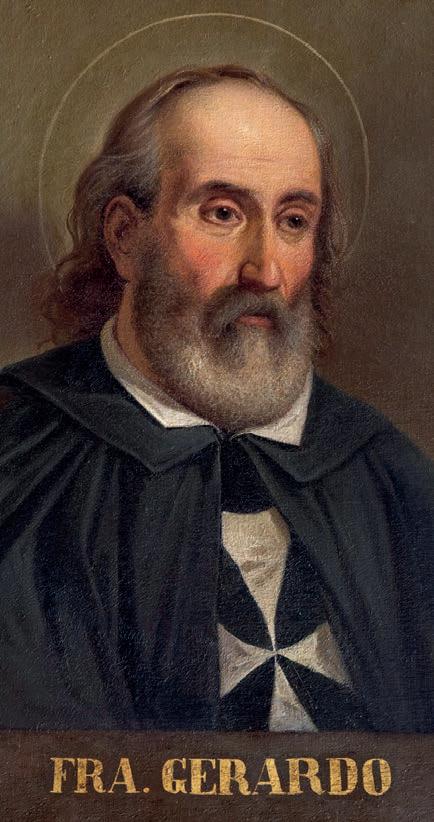
with synods or general councils regarding potential canonisation candidates. Pope Gregory IX decreed in 1234 to have the sole and exclusive authority over bestowing Sainthood. is did not stop Bishops from granting individuals beati cation, making a di erence between Sainthood (worldwide) and beati ed (localised). It could be argued that Gerard’s canonisation e orts were lost in this transition period.
It is argued in this paper that the heart of the matter lies in the time line, whereby Gerard’s canonisation by a Bishop was done in a transition period leading to the act of canonisation to become an exclusive papal prerogative. It is argued in this paper that Gerard was already canonised before the new rules came to be, and therefore, these new rules do not apply, such as the demand for a postbeati cation miracle (two before the 1983 reforms).
Gerard is presumably one of many Saints whose Sainthood fell between the cracks of the transition period and was retrospectively judged to remain Blessed. e easiest way out is to pronounce an administrative error in this case, easily to be recti ed with goodwill, since all the requirements for Sainthood before 1234 had been ful lled.
It is worthy to note that Gerard could have been Blessed while still alive. Perta shows a document written somewhere between 1100-1120, which reads ‘il beato Gerardo…senadoxius e ospitalarius,’ Blessed
Gerard… the xenodochian and Hospitaller.
Over the centuries, a multitude of Saints’ lives have been published, while probably as many remained unpublished. e record remains incomplete, as it concerns literally thousands of Saints, and no one has ever managed to create a comprehensive list of all the Saints. As a result, persons deserving to be canonised have been undeservingly omitted from Sainthood. Probably, Gerard himself is one of those forgotten Saints. Very few researchers have dealt with medieval Sainthood between 1100 and 1500, although this period is the apex of the cult of Saints in the West. At times, even the miracles surrounding a prospect were doubted. In this context it may be remarked that the relationship between the Order and the Papacy was not always as it should have been.
Conclusion on Gerard’s Saintly status Gerard died in 1120 and it is not known if he was processed before the 1234 date. He would at present be counted as a category 2 Saint, who was canonised by a local Bishop, presumably of Jerusalem, Acre or by popular will. However, documentation is lacking. Kleinberg claims the notorious inaccuracy of medieval sources as one reason why the road to Sainthood could falter.
Another reason is that a person’s or Saint’s charisma triggers a Saintly reputation. Living Sainthood is then a quality to which people unquestioningly submit and become faithful disciples to its bearer. When living Sainthood is attributed to a person, others will behave towards this person as is tting to the existing conventions applicable to a particular audience. Acquiring Sainthood is regarded as a slow, accumulative social process, including art, legends and miracles within a historical context. When the Saint becomes a historical Saint, the narratives usually continue to be developed.
is all suggests, notwithstanding the detailed and well researched arguments of Beltjens, that at one point in time, Gerard was considered a Saint, rather than Blessed, because the Order regarded itself as widespread as the Christian religion itself and not a localised cult.
It is argued in this article that the heart of the matter lies in the timeline, whereby Gerard’s canonisation by a bishop was done in a transition period where canonisation became an exclusive papal prerogative. Gerard’s canonisation was then retroactively considered as a beati cation. Furthermore, it is reasoned here that Gerard was already canonised before the new rules came to be, which therefore do not apply, such as the demand for a post-beati cation miracle (two before the 1983 reforms).
His Holiness the Pope has the right to canonise Saints and, as the ultimate authority, can pass the nal judgement and decision on Sainthood. We pray that it will be a swi stroke of the pen to con rm the Sainthood of Gerard, as it will do justice to the millions of people who are and have been served by the Order of St John over the last near-millennium.

Lourdes PIGRIMAGE
ousands of people from around the world have travelled to be a part of the 66th International Pilgrimage to Lourdes to see Grand Master Fra’ John Dunlap lead the pilgrimage for the second time since his election.
Some 7,000 people, from 46 di erent nations, participated in the annual Order of Malta International pilgrimage to Lourdes this year. Amongst them there were 1,200 malades, including 750 young people aged 8 to 35, as well as 230 priests, 12 deacons, 231 doctors and 152 nurses.
Grand Master Fra’ John Dunlap led the pilgrimage for the second time since his election and was joined by members of the Sovereign Council, Monsignor Luis Manuel Cuña Ramos, new Prelate of the Order of Malta, and 23 bishops. e Ponti cal Mass on Sunday was celebrated by Cardinal Gianfranco Ghirlanda, Cardinal Patron of the Order of Malta; Cardinal Silvano Maria Tomasi, former papal delegate.
e Australian contingent comprised of 36 members, malades and friends. ey were joined by 36 pilgrims from Hong Kong, Korea and Singapore and had the privilege of caring for ve malades under the guidance
of three wonderful priests. ey also carried with them 58 Prayer Intentions submitted by members and friends of the Australian Association, which were put into a sealed envelope and placed on the altar at Masses and prayed for during the Prayer of the Faithful and during Rosaries.
In addition to the key events; the Marian Procession, the Eucharistic Procession and the Ponti cal Mass, the Australian Asssociation’s pilgrims attended Masses and Rosaries at the Grotto and the Church of Saint John the Baptist in Bartres. e itinerary also included a visit to the Chapelle des Lumières for prayers and to bless the pilgrimage candles, a visit to the sacred baths, a tour of Cite Saint-Pierre and the Stations of the Cross. ey also ’followed in the footsteps of Bernadette’ by taking a path that passes the key places where she lived, from her birth in 1844 to her departure for Nevers in 1866, which form the setting for the apparitions of 1858.
A Lourdes 2024 Report by Dr Damian Benson KMG (Ob) I have been asked to report on my 2024 trip to Lourdes in the capacity of a malade.
Bernadette and I arrived in Paris early on Monday 29 April, with dinner that night at a restaurant to meet up with the Australian contingent of Knights, Dames, volunteers and malades. It was a cheap and cheerful casual restaurant within walking distance to the Hotel – a good opportunity to stretch the legs a er a long ight from Melbourne and mix with the others. Everyone was a bit jet lagged but looking forward to the Lourdes experience. A er dinner we wandered back to the Hotel for an early night.
On Tuesday 30 April we had a morning Mass at e Chapel of Our Lady of the Miraculous Medal. e chapel was built in 1815 and was dedicated to the Sacred Heart of Jesus. In 1830 it was privileged with the extraordinary events of the apparitions of

the Blessed Virgin to Sister Catherine Labouré.
A er Mass some of the group went to visit Sacré Coeur for rosary and lunch at a restaurant at Montmartre. I was feeling a bit tired so I did not go but went to the hotel to rest. We had dinner that night within walking distance of the hotel.
On Wednesday morning 1 May, we all gathered downstairs of the hotel to walk to the train station. is was my rst experience at being a malade. We all had a job to do and mine was to be looked a er – a very unusual role for me as I was used to looking a er the sick and the poor.
e train trip was pleasant and at the end we had arrived at Lourdes Station on a grey misty a ernoon. at night we had a Mass in the Crypt, Rosary Basilica. is was a beautiful solemn beginning to my Lourdes experience.
ursday was a really busy day beginning with an English Mass at the Grotto in the morning and a er lunch back to the Grotto for Rosary then followed by a washing at the Baths with Lourdes water. is was one of the most moving religious experiences of my life. A very solemn and re ective moment for me to pray and give thanks for my recovering health.
On Friday, the Australian contingent had a trip to attend Mass at Church of Saint John the Baptist, Bartres – the village of Saint Bernadette. A er Mass we had a most enjoyable social lunch. e weather was a pleasant sunny day. A nice change. e village church is very small and simple and well worth the visit to attend Mass where Saint Bernadette attended more than 150 years ago.
Upon our return, we then had to prepare for the evening Marian Procession in the forecourt of the Lourdes Sanctuary. A most emotional event full of hymns, candles and prayers in many languages.
On Saturday morning we departed on a local bus to visit Cite Saint-Pierre in the hills outside Lourdes designed to accommodate those pilgrims who cannot a ord to stay in town but need to visit the Grotto. We had a guided tour, then Mass in their chapel before returning to Lourdes.
e day nished with a Eucharistic Procession in the early evening, complete with hymns and prayers. It was a very busy day.
Sunday was our last full day at Lourdes with a Ponti cal Mass at the Pius X Basilica, followed by a

picnic lunch on the Prairie Lawns. We then retired to our room for a rest with a nal anksgiving Dinner in the evening.
Bernadette and I departed Lourdes early Monday morning to return home.
e above is but just some highlights of my Lourdes Experience.
e impact of the Lourdes experience is di cult to put into words. I have had some time to re ect and I can say that it has had a profound impact on me, my recovery and it made me realise that no matter how sick one feels, there is always someone in a worse situation.
Many thanks to all who made my pilgrimage possible and I will be forever grateful to the love and care provided to me during the trip. Special thanks to my wife Bernadette for all the love and support she has given to me over the last three years since my diagnosis.
Dr Damian Benson
Grand Cross of Magistral Grace in Obedience Vice Regent of the Sub-Priory of the Immaculate Conception

Le : NER Chaplain Rev Fr Gerard McMorrow in the Crypt of the Basilica.
Above: Malades and members sharing a pilgrimage.
Gabriel Jean du Pac de Bellegarde THE FIRST KNIGHT
KMG
The history of the Sovereign Order of Malta in Australia is o en traced to the foundation of the Australian Association 50 years ago this year. Yet the presence of the Order on our great south land reaches further back, beyond the Order’s formal establishment of national associations, beyond the arrival of Catholic clergy to minister to a edgling colonial Church, and even beyond the construction of the rst European settlement. It begins, in fact, with a single young knight.
is article seeks to uncover the remarkable and little-known story of Gabriel Jean du Pac de Bellegarde, a 23-year-old French nobleman and simply professed Knight of the Order, who arrived at Botany Bay on 24 January 1788. He came not as a colonist or missionary, but as a member of a scienti c and exploratory expedition led by Jean-François de Galaup, Comte de La Pérouse. An expedition planned as one of France’s most ambitious maritime endeavours that sadly ended in tragedy and a complete loss of life.
Bellegarde’s brief presence in Australia occurred just days a er the arrival of the British First Fleet on 18 January 1788, placing him at a unique crossroads of history. It was during this eeting yet signi cant visit that Bellegarde attended what is believed to be the rst Catholic Mass ever celebrated on Australian soil, o ered by the chaplains of the French ships.
It was providentially tting that the Order of Malta’s earliest presence in Australia should be marked by Bellegarde’s participation in the sacred liturgy, a moment of solemn prayer and quiet dignity for the young knight, o ered on these distant shores just weeks before tragedy would overtake the French expedition upon its departure from Australian waters.
Gabriel Jean du Pac de Bellegarde’s story weaves together the romance of chivalry, the rigour of naval exploration, and the mysterious fate of one of the Enlightenment’s most ambitious voyages. Born on 19 August 1765 to the noble du Pac de Bellegarde family, Gabriel was admitted as a Knight of Justice in Simple Vows on 26

March 1775, joining as a knight in minority and continuing the chivalric traditions of his forebears. In accordance with the Rule, he was to undertake his caravans (naval campaigns in service to the Order) upon reaching Malta.
Before he could complete his formal service in the Mediterranean, the young knight was drawn into the far-reaching maritime ambitions of the French Crown. Having already served in India and accumulated ve years of campaign experience, Bellegarde found himself in Macao in early 1787, where he joined La Pérouse’s expedition when it came to port as a naval guard aboard L’Astrolabe. One can imagine that his decision to join such a perilous voyage was shaped by youthful ambition and a dual allegiance, to his King and to his Order, guided by the enduring codes of honour that bound them both. As a Knight of the Order serving in the French navy, Bellegarde was by no means exceptional. It was not uncommon for knights to distinguish themselves in the naval forces of European powers, either before or a er ful lling their caravans with the Order’s own eet.
Bellegarde’s status as a professed knight was far more than a formality. In their correspondence with the French Ministry of the Navy, both Fleuriot de Langle, commander of L’Astrolabe, and La Pérouse strongly advocated for his promotion, explicitly acknowledging his obligations to the Order and the importance of facilitating his return to Malta to ful l them. “ e Knight of Pac Bellegarde,” La Pérouse wrote in February 1787, “requests... in favour of the ve years of campaigns he has undertaken in India... the brevet of lieutenant of the ship, and of the department of Toulon... because of the proximity of Malta where he must go to make his caravans upon his arrival.”
A Catholic Mass on Unfamiliar Shores
When the two French ships, La Boussole and L’Astrolabe, arrived in Botany Bay in January 1788, they were met with surprise by the British First Fleet, which had arrived only
A Knight of St John in Early Australia by Scott Samson
days earlier. Philip Gidley King, the rst LieutenantGovernor of Norfolk Island and third Governor of New South Wales, recorded the moment in his journal: “Two strange ships were seen standing in the Bay... we judged them to be the two ships under the orders of Monsieur de la Pérouse.”
Amid this convergence of maritime empires, a moment of quiet but profound signi cance unfolded: the rst recorded Catholic Mass on Australian soil. Celebrated by the chaplains of La Pérouse’s expedition, it was attended by Gabriel du Pac de Bellegarde, whose presence is noted among the congregation. In this act of worship, the young Knight of Malta bore witness to the earliest expression of public Catholic faith in what would one day become modern Australia, a moment both historically and symbolically tting for a man shaped by faith, service, and sacred duty.
Vanished Without a Trace
In March 1788, the French ships departed Botany Bay, setting sail into the Paci c. It was the last con rmed sighting of La Pérouse and his crew by Europeans. Despite extensive search e orts, including a later expedition by d’Entrecasteaux and the publications of the botanist Labillardière, the fate of La Boussole and L’Astrolabe remained a mystery for decades.
It was not until 1826, when Captain Peter Dillon of the British Navy discovered remnants of French shipwrecks on the reefs of Vanikoro in the Santa Cruz Islands (now part of the Solomon Islands), that the truth began to emerge. Anchors, cannons, and swords, all traces of the lost expedition were found con rming the ships’ tragic end. Local oral histories suggested that a few survivors had remained on the island, with some attempting to escape by building a smaller cra . None, however, were ever found. Among the dead was almost certainly Gabriel Jean du Pac de Bellegarde.

A Monument in Memory
e memory of La Pérouse’s expedition was eventually honoured with a monument on Vanikoro, erected by the explorer Dumont d’Urville. And in Sydney, the suburb of La Perouse, situated near the site of the French encampment, continues to bear witness to this extraordinary encounter of cultures, ambitions, and fates.
ough his name may be little known beyond the footnotes of maritime and Melitense history, the presence of Gabriel Jean du Pac de Bellegarde in Australia remains both striking and symbolic. A man of noble birth, deep faith, and committed service, he is remembered not merely as a voyager of the Enlightenment, but as the rst known Knight of Malta to set foot on Australian soil. While his visit le no lasting institution, it quietly foreshadowed the Order’s future presence on this continent, one that would only take formal shape nearly two centuries later with the founding of the Australian Association in 1974. In this light, Bellegarde stands as a distant forerunner, his story a reminder that the seeds of the Order’s mission can sometimes lie dormant until the appointed time.
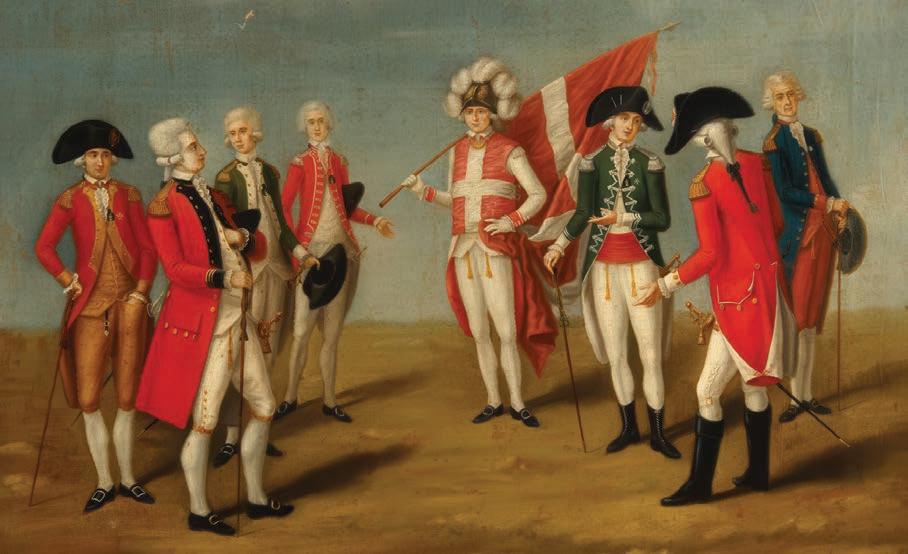
Above and below right: Typical Order of St John uniforms worn in the 18th Century.
Gaza: Historic collaboration
BRINGS HELP TO PEOPLE IN NEED
In 2024, the collaboration between two of the oldest Christian institutions made it possible to deliver aid to the Gaza Strip and give people hope despite major challenges. A personal account
by Clemens Graf von Mirbach-Har , Secretary General of Malteser International

On 24 July 2024, my phone beeped with a short, but very signi cant message: 40 tonnes of relief supplies had reached people in need in Gaza City in the early hours of the morning. is was the culmination of months of joint e orts between the Latin Patriarchate of Jerusalem and the Sovereign Order of Malta.
In possession of the infrastructure, but without the manpower or specialist expertise needed to carry out a humanitarian intervention, H.E. Cardinal Pierbattista Pizzaballa had reached out to the Grand Master of the Sovereign Order of Malta in Rome at the beginning of 2024. With this step, he revived a historic connection that goes back to the founding days of the Order: Around the year 1100, the Latin Patriarch Ghibbelin was, so to speak, the superior of our founding father Blessed Gerard at the historic St. John’s Hospital in Jerusalem.
Joining forces with the emergency relief experts from Malteser International was therefore the logical step to nally bring aid to Gaza. anks to its stance of careful diplomacy and scrupulous neutrality, today’s Patriarchate is one of the few players in the Middle Eastern crisis which can speak to all sides in an atmosphere of trust. Mass continues to be read in Gaza, even as the Christian community and their neighbours shelter from the violence in and around parish buildings.
During video calls with the priest in the Patriarchates parish in northern Gaza, bombs and rockets can be heard passing overhead. e humanitarian situation on the ground is appalling. Sickness is rife due to the disruption of sanitation and the poor food supply. Daily necessities are scarce


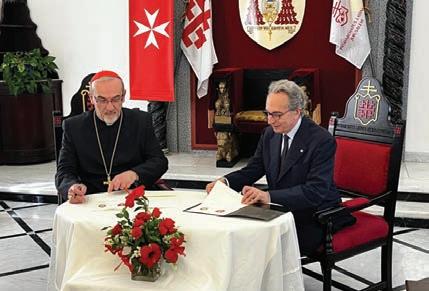
or simply not available. Medical care is nowhere to be found. For more than a year, people in most of the embattled areas have been on the brink of catastrophic famine. Our rst goal was therefore to get relief supplies to the Patriarchate community in northern Gaza as quickly as possible and distribute them from there.
In May 2024, a small delegation consisting of representatives of the Patriarchate, the Sovereign Order of Malta and Malteser International managed to enter the Gaza Strip. e people who had been hermetically sealed o here for months now received two vital things: food and spiritual comfort. e next step was to expand this rst delivery into a steady ow of aid that would reach as many men, women, and children as possible in the area around the community. e health and lives of these families, as well as those of our employees, had to be protected. And the mission had to be nanced. e risk of failure was high.
A er weeks of planning, overcoming setbacks, waiting, and praying, that extraordinary message nally reached me on 24 July, despite all the obstacles. e relief and joy of the helpers from both organisations were overwhelming: 5,000 Christians and Muslims had received supplies for several weeks. And this was only the start:

Further deliveries have since been made at intervals of a few weeks.
anks to the active support of the Latin Patriarchate and local partner organisations in Israel and the Gaza Strip, which brought with them a deep understanding of the region, our team was able to accomplish this enormous feat despite incredible di culties. In the meantime, we have placed the food distribution in the capable hands of the Patriarchate’s sta . We at Malteser International have returned instead to our founding principle of serving the poor and sick, and are focusing all our e orts on providing medical care to those in need as quickly as possible.
is is how Malteser International provided aid in the Occupied Palestinian Territories in 2024 Since July 2024, MI supported the war a ected population in the northern part of the Gaza Strip with food distributions in collaboration with the Latin Patriarchate of Jerusalem.
• one distribution centre built in Gaza
• more than 200 tonnes of goods delivered to Gaza
• 139,500 people reached directly with support (aid recipients di ered due to displacement movements) in Gaza
• one clinic supported nancially in the Westbank
Clockwise from top: A truck is bringing relief supplies to the distribution centre that was set up in the summer in the Holy Family Parish in the north of Gaza City the early summer of 2024. (Photo: lpj.org/Omar Ishak Al K).
anks to these e orts, food was delivered to thousands of Christians and Muslims (Photo: lpj.org/Omar Ishak Al K).
H. E. Cardinal Pierbattista Pizzaballa, Latin Patriarch of Jerusalem (right), and Fra Alessandro de Franciscis, then Grand Hospitaller of the Order of Malta (le ), sign the agreement that would bring much-needed food to thousands of people. (Photo: Malteser International).
e works must CONTINUE
e Situation in Lebanon took a catastrophic turn during the fall of 2024: e escalation of the war between Israel and the Hezbollah led to a mass population displacement in September. e situation in Lebanon is “devastating,” said Oumayma Farah, a sta member of the Order of Malta Lebanon (OML), in October 2024. By then, over a million people had ed their homes and several hospitals and almost 100 primary health care centres had already been forced to close (source: UN).
With the support of Malteser International (MI), OML immediately expanded its medical aid in particular. “Our colleagues from the Order of Malta Lebanon risked their lives to continue providing medical care to the people a ected by the war in Lebanon,” said Nayla El-Khoury, MI’s Country Representative for Lebanon. Health care is a core focus of MI’s work with OML. United through the shared vision and mission of the Order of Malta, MI supports OML in running seven mobile medical units and eleven health centres across the country. Four additional mobile units specialised in dental care, pediatrics, gynaecology, and
cardiology started work in April 2025.
A er the hostilities increased in September 2024, health centres and their sta were temporarily relocated from embattled regions to more secure parts of the country, where many people had ed to. ere, the medical teams provided medical assistance in emergency shelters. In addition, volunteers distributed blankets, hygiene, and sanitary products. And the mobile kitchens provided the many internally displaced people with hot meals. e German Federal Ministry for Economic Cooperation and Development (BMZ) and the German Federal Foreign O ce (AA) provided nancial support
for the expansion of emergency aid. On 4 November 2024, German Development Minister Svenja Schulze visited several MI projects in Beirut. Clemens Graf von Mirbach-Har , Secretary General of MI, accompanied the visit: “ e Federal Minister was able to see for herself that we Maltesers were able to provide rapid assistance to people in Lebanon in the shortest possible time.”
Cease re in Gaza and Lebanon Since the cease re between Israel and Hezbollah came into e ect on 27 November 2024, the mobile medical units were able to resume their work in the south of Lebanon.

e situation remains tense. However, other than in Gaza, where the people currently have little hope that their catastrophic humanitarian situation may improve, there is great hope for a lasting end to the ghting in Lebanon.
is is how Malteser International provided aid in Lebanon in 2024
In total, 114,042 women, men, and children were reached directly in 2024 with all support activities from four projects. In the core sector health, OML, with the support of MI, provided mobile medical assistance in Akkar, Baalbek-Hermel, Nabatieh, South Lebanon, and Chouf. is support reached Syrian refugees in vulnerable living situations as well as the Lebanese community, including internally displaced people, who stayed at emergency shelters. ese emergency relief measures were carried out through mobile medical units and community health centres in the vicinity. MI further supported the continued strengthening of health care services and local agriculture for crisis-a ected populations across the country. To improve the health and social well-being of marginalised populations in vulnerable living conditions, MI also supported OML in the provision of hygiene and awareness campaigns.
In the area of Food and Nutrition Security, Agri-humanitarian Centres (AHCs) were established, providing opportunities for small-scale farmers to grow their seeds into seedlings and increasing their knowledge about climate-smart agriculture. A fourth project aims at strengthening the resilience of the population in rural regions a ected by poverty and food insecurity by promoting agricultural production through the provision of technical know-how and vocational training in the agricultural sectors as well as the equipment to start and build small-scale agricultural businesses.

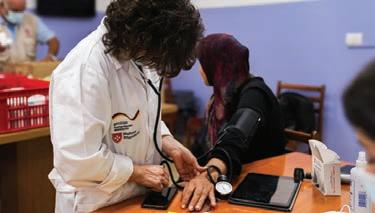

Within the MI supported projects, the following number of people could be reached by OML in
Lebanon:
Health sector:
• 89,325 people reached directly through all MI supported health activities
• 21 health facilities supported
• 203,308 consultations carried out by OML medical sta in health centres and mobile units
• 898 persons participated in individual or group mental health and psychosocial support (MHPSS) session
• 1,066 women received maternal health services
Food and Nutrition Security (FNS) sector:
• 19,629 people reached directly through all MI supported FNS activities
• 13,884 hot meals and snacks distributed by the OML Mobile Community Kitchens
• 425 food parcels distributed
• 607 farmers and business owners received cash grants (439) or in-kind grants like equipment (168)
Emergency Relief (ER) sector:
• 13,505 people reached directly through all MI supported ER activities
• 10,104 ER kits distributed (e.g. hygiene kits, food kits)
Far le : MI and OML support seven mobile medical units that bring health care to people even in remote locations. Many patients have visited the mobile units for many years. Four additional units specialised in dental care, paediatrics, gynaecology, and cardiology started work in April 2025. Photo: Lama Chidiac/Malteser International, Order of Malta Lebanon.
Le and top of red box: Some of the mobile medical units had to relocate or adjust their routes daily to continue to bring urgently needed health care to their patients safely. Photos: Lama Chidiac/ Malteser International, Order of Malta Lebanon.
Bottom red box: In 2024, employees of the mobile community kitchens “ e Sharing Wheel” distributed more than 137,000 meals to locals and refugees directly where they were needed. Photo: Order of Malta Lebanon.
Did You Know?
Written by Scott Samson KMG


The year 2024 marks the 500th anniversary of the political deliberations that led to one of the most signi cant moments in the history of the Sovereign Order of Malta: the Deed of Donation, which granted the Maltese islands of Malta and Gozo, as well as the North African port city of Tripoli, to the Order.
In 1524, just a year a er their loss of Rhodes to the Ottoman Empire, the Order sent a delegation to the Spanish city of Vitoria, where the Holy Roman Emperor Charles V was engaged in military operations. eir purpose was to petition the Emperor – then recognised as the temporal protector of Christendom – for a new territorial base from which the Order could rebuild and continue its mission.

Providentially, the Order’s request did not fall on deaf ears. Negotiations, papal correspondence, and local inspections followed, but it was not until 1530 that the arrangement was formalised in a document now known as the Deed of Donation.
It was a recently discovered collection of 16th Century diplomatic papers written by Martin Salinas, Ambassador of King Ferdinand of Hungary to Charles V, that shed light on the details of the Emperor’s reply to the Grand Master of the Order, Fra’ Philippe Villiers de L’Isle-Adam.
According to Salinas’ report to King Ferdinand, Malta and Gozo, together with Tripoli, were to be granted to the Order “for the service of God,” on the condition that a falcon be delivered to the Emperor each year: thus initiating the famed tradition of the annual Tribute of the Falcon.
rough this charter, the islands and territories were formally entrusted to the Order, marking the beginning of a new chapter not only in the history of the Order but also in that of Malta itself.
Until then, Malta’s destiny had been closely tied to Sicily and the Crown of Aragon, within the broader Spanish Empire. e arrival of the Order laid the foundations for Malta’s emergence as a distinct political and cultural entity, and a rmed the Order’s enduring claim to sovereignty. e original deed, written in re ned Latin on ne parchment and bearing the great wax seal of Emperor Charles V, remains one of the most treasured historical documents of both the Order and the Maltese people, and is preserved today in the National Library of Malta.
is quincentenary invites us to re ect not only on the Order’s resilience in the face of adversity, but also on the providential unfolding of Malta’s history,
Le : e Deed of Donation, which became a formalised document in 1530.
Images: supplied by National Library of Malta


ailand 2024
YOUTH CAMP
e Asia Paci c Youth Camp for the Disabled 2024 in Pattaya City took place from 3 to 5 September. It was beautifully executed and lled with joy, fun, and big smiles from both the organisers and participants.
A report by camp leader Anna Sammut
The Order of Malta Asia Paci c Youth Camp was a transformative experience designed to support young adults with disabilities in their spiritual, emotional, and personal growth.
Upon our arrival we were welcomed by our ai delegates who greeted us with beautiful singing and handmade lays. It was at this point we knew this camp would be special.
On our rst day we were taken to the Royal Varuna Yacht Club where we participated in a variety of icebreaker games, as well as played the famous Christopher’s Cup. is day really allowed us to bond with the other guests and to build friendships. We ended the night with karaoke and a disco, which had us all dancing and singing into the late hours of the night.
On our second day we got to experience and participate in ai traditional games and cra , such as Shishika Ball and Dern Kala. is day we tested our patience and creativity through the form of cra .
On our third day we made our way to Nong Nooch Botanical Garden. is botanical garden was unlike any that we had seen before from mechanical life sizes animals from all over the world, to professional cultural performances to elephant shows – it

had it all. We were lucky enough to get front row seats to the elephant show where many of our guests got up close and personal with the elephants. We were also treated to elephant rides where we helped participants get out of their comfort zones and climb on an elephant for an experience they will never forget.
On our last night we got to see everyone dressed up in their national costumes and
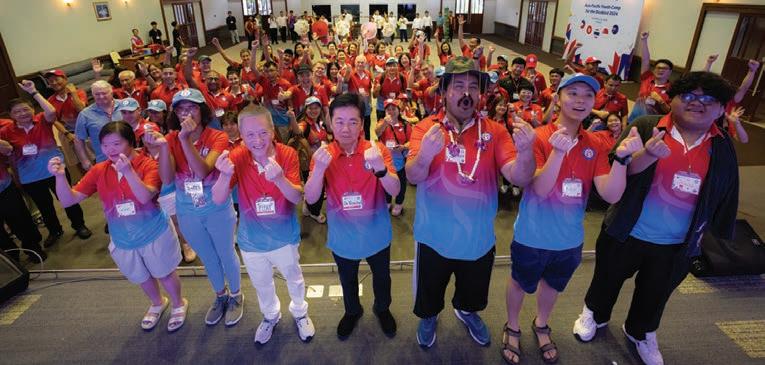
perform something from their homeland. I am proud to say that team Australia sung I am Australian by the Seekers and ended up winning best performance of the night. We had all brought Australian souvenirs to share with our Asia Paci c friends to remind them of their new Australian besties. is night was de nitely one to remember, the atmosphere and emotions in the room that night were



high and unforgettable.
What made this camp extremely special was the facility where we stayed. We stayed at the Redemptorist Centre, in Pattaya, which was located in a compound which housed, educated and provided individuals with disabilities with the skills and resources to nd work and become independent.
Our days were lled with laughter, joy, happiness, re ection and lots of yummy food. e 2024 camp helped create a safe, inclusive space where participants regardless of their physical or intellectual challenges were encouraged to engage with others, test their strengths and weaknesses. rough the activities and shared experiences, our young adults with disabilities came together with their peers, caregivers, and volunteers to form lasting connections.
For many young adults with disabilities, the Asia Paci c Youth Camp is a once-in-a-lifetime opportunity to be recognised for their abilities, not their limitations. Past participants have o en shared with me how the camp has been a source of inspiration, allowing them to experience personal and spiritual growth in ways they had not imagined.
We are all looking forward to having another great experience at the 2025 camp


Above: Forty-one participants attended the Asia Paci c Youth Camp for the Disabled 2024, including 26 from abroad and 15 from ailand, representing ve countries in the Asia-Paci c.
Le and below: participants represented Australia, Hong Kong, e Philippines, Singapore and ailand. ey played traditional ai games, made new friendships, and enjoyed delicious foods in a camp environment.
ACU & e Order of Malta:

COMMUNITY HUB
It has been a busy year for the Australian Catholic University (ACU) Hub in Melbourne with many projects on the go. ere have been new initiative programs put in place, as well as expanding on the current ones such as the Mobile Community Café, Read to Learn, and Cooking and Connection.

Firstly, we would like to congratulate Anna Vandierendonck, Dr Matthew Pink and Jennifer Tredinnick, who were recognised in the ACU 2024 ViceChancellor’s Sta Excellence Awards for their work with the Order of Malta and ACU Community Hub.
e hub has pioneered a mobile outreach model to connect with Darebin LGA communities, promote social inclusion and meet local needs. e Hub operates community-driven projects such as food literacy programs, community gardens and reading support for children who come from diverse backgrounds. is assetbased approach builds capacity, co-creates knowledge, strengthens community ties and re ects a shared commitment to human dignity and the common good.
Agg St Community Garden
A er months of planning, the Agg Street Community Garden program is now open and in action. We have a number of residents that are keen gardeners, and this common interest was identi ed as a way to bring the multi-cultural Agg Street community together, as gardens have no language barriers. Out of the 55 senior residents (aged 55+), many live on their own and experience varying degrees of loneliness and isolation (based on qualitative feedback).
e aim of the garden is to provide a safe place where people can come together to grow food. It’s a great way for residents to get to know each other on a personal level and build their community. is can help reduce feelings of isolation and loneliness
and support positive mental health. In addition, the project aims to address place-based socio-economic disadvantage and health inequity through building the capacity of the residents to improve their food security.
Mobile Community Café
Community Cafés have been pivotal in providing an informal and safe space for isolated or disadvantaged people to meet, share food and engage in casual conversation to help prevent loneliness. Participants can attend for some of the time or stay for the two-hour duration of each café. Community cafés are great for participants who need assistance completing some life tasks such as forms and IT assistance, or connecting community members with other services and supports available to them. e tasks include preparing morning tea snacks, serving the community members a hot drink, and engaging in conversation with the attendees.
Read to Learn Program
Another Semester Complete
We wrapped up our third Read to Learn program at Preston North East Primary School.
e school community continues to appreciate our support with Annie Neville, Acting Assistant Principal, sharing this message: “I was so impressed with the tutors’ generosity, commitment and professionalism. Most of the students participating in the program don’t have support for reading at home (for all kinds of reasons), so the extra practise you provide is invaluable.”
e Read to Learn program assists the school in building the reading capacities and good study habits of primary school children who may not have the opportunity to read at home with their
parents and/or whose parents speak English as an additional language.
Cooking for Connection
In early August of 2024, the Order of Malta and ACU Community Hub in partnership with Your Community Health, launched a four-week Cooking and Connection program at Preston North East Primary School. is program is designed through an opportunity that was brought in conversations with the community to help build parents’ capacity around food security and nutrition. ACU students studying Masters of Dietetic Practice have been so valuable in the planning and delivery of this program. It is also part of their professional practice.
A group of eight parents from diverse backgrounds and communities joined the inaugural program. ey completed a short survey in the rst session which provided feedback regarding the topics they were keen to learn more about. Topics included the Australian dietary guidelines, learning how to interpret the nutrition labels and the health star rating system, and exploring lunchbox options. During the second part of each session, the group assisted with the preparation of a nutritious and low-budget meal or snack which the participants took home.
A post-program survey highlighted that the program was well received and included comments such as “Excellent information conveyed in a professional and friendly environment”. All parents reported that their food choices had changed in a positive way, with many participants reporting that they are using the information that they have learnt to make nutritious meals. Furthermore, all parents found that they had made some signi cant connections through the program and enjoyed the interactions they had.

Community Care Vans e Melbourne Community Care Van program is an initiative where ACU Student Volunteers and Members from the Order of Malta go and visit people sleeping rough on the streets and o er their time, a care pack and a coat to keep them warm and protected from the harsh winter months. ank you to Michael Murphy who has a big role play in the redesign of this program.
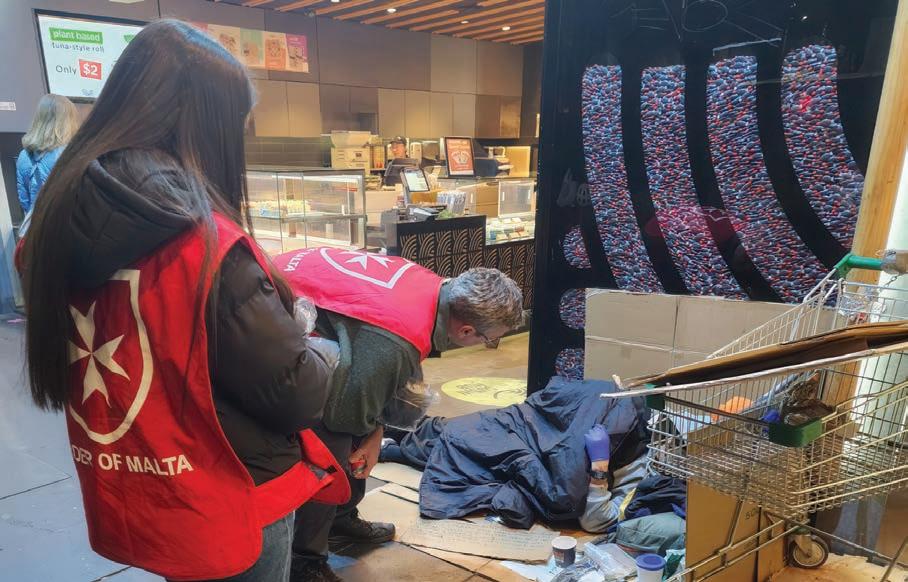
Far le : e Agg Street Community Garden program helps residents reduce feelings of isolation and loneliness.
Top: Participants in the Read to Learn program at Preston North East Primary School.
Melbourne

e icon of
OUR LADY OF PHILERMOS


The icon of Our Lady of Philermos is, more than any other, the most sacred representation to which, for centuries, the Knights of the Order of Malta have been devoted. It is the symbol par excellence of the Marian spirituality of the ancient Order of the Hospitallers of St. John. However, Our Lady of Philermos could also be worthy of the name of patron saint of travellers, without wishing in any way to detract from the o cial holder of this title, St Christopher. Few religious pictures have travelled as much and as adventurously as this small but precious portrait.
Everything about her speaks of Pilgrimage Even just to admire this face, which releases a deeply holy sense, one has to travel, taking a long journey to the National Museum of Art of Montenegro in Cetinje, where it has been kept since the Second World War. And when the icon reappeared, at the end of the 20th century, having thought to be lost, it was welcomed like a long lost friend or, better yet, a much-loved mother from whom you’ve heard nothing for years and who suddenly shows hope when all hope had been lost.
However, the dimension of the journey/pilgrimage is just one of the fascinating aspects of this little masterpiece. What is even more extraordinary is the story eotokos Phileremou, the Mother of God of Philermo. Starting from the mystery of its origins. Could it really be the work of Luke the Evangelist as tradition says?
Its history according to tradition e rst account, reported in the Complete calendar of Russian saints and brief miraculous news on the Mother of God, leaves no room for doubt: “According to tradition, the Hodigitria (she who leads) Filermskaia was painted by St Luke and consecrated with the blessing of the Mother of God. In around the year 46, it was taken to Antioch, the birthplace of St. Luke, and then to Jerusalem. Towards the year 430, it was taken to the church of Blacherne in Constantinople. In 626, it saved Constantinople from the Persians (…) In 1204 it was taken by the Latin army, transferred to Palestine and from there to the island of Malta”.
Another description, reported in a text dating back to the 17th century, also makes reference to the same presumed artist: “Said to have been painted by the Evangelist, Luke”. en it makes less precise historical references. e icon, according to what is written, is supposed to have been taken to Rhodes from Jerusalem “when the island was still under the rule of the Eastern Emperors”. e timing is less certain because, apart from the invasions by the Persians in 620 and the Arabs (633-665), Rhodes was ruled, at least in name, by the Eastern Emperors until the island was occupied by the Hospitallers in 1306.
A third version appears in a Magistral Bull of the Hospitallers Order dated 1497. It states that, according to local tradition, the icon is said to have arrived in Rhodes by way of a miracle: oating on the sea, at the time of Emperor Leon the Heretic (717-741).
A Long Pilgrimage
Stories aside, more precise information indicates that the portrait was housed on Mount Phileremos in
Rhodes between 1306 and 1310. Even on the small Mediterranean island, its pilgrimages were constant. As written in 1594 by Giacomo Bosio, author of texts on the saints and blessed of the Order, “the highlight devout picture” was moved within the walls every time danger arose: an example of such movement occurred when the Turkish army was about to lay siege to the island of Rhodes in 1480. en, a er having spent time in St. Catherine’s Church, it returned to the mountain, taking a journey of about 10 miles.
From Rhodes to Malta
e invasion by the troops of the Sultan Suleiman between 1522 and 1523, led to the loss of the island by the Knights. e exiled Grand Master, Fra’ Philipe Villiers de l’Isle Adam, was allowed to take the Order’s most venerated and previous reliquaries with him: the right hand of St. John the Baptist, a fragment of the authentic Cross and, of course, the icon of Our Lady of Philermos, which set out on this new pilgrimage accompanied by a standard bearing the words: «A ictis tu spes unica rebus», “You are the only hope in all a iction”. ese travels brought the religious picture to Italy. First to Messina then to Naples, where it was carried in

Below: e original Our Lady of Philermos icon, Museum of Art and History in Cetinje, Montenegro.
a procession during the plague of 1523. en it was the turn of Civitavecchia and Viterbo, where it remained three years, from 1524 to 1527, in the Church of Saints Faustino and Giovita, which houses a painting of the Virgin, donated by the Knights and still venerated under the name of Madonna of Constantinople.
But this was by no means the end of the journey. A er spending time in Nice and Villefranche, the icon was taken to Malta in 1530, housed in the Church of San Lorenzo in Birgu, the “victorious city” not far from Fort St. Angelo. And here there’s another legend, also recounted by Giacomo Bosio. During the Great Siege of 1565, which ended with the victory of the Knights “a pure white dove was seen to rest on the miraculous icon of Our Lady of Philermos; it stayed there for hours; hence the people were given a sign that they would soon be freed from the siege”. A er a short stay in Our Lady of Victories Church in Valletta (1571-1578), the icon was housed in the St John co-cathedral of the Maltese capital. Here it stayed for more than two centuries, enhanced with jewels, clothes and furnishings. Other movements were on their way though.
From Malta to Saint Petersburg In 1798 General Bonaparte occupied the island of Malta. He forced the Knights to abandon the island and ordered that all churches and palaces to be stripped of everything valuable, including the rich ornaments of Our Lady of Philermos. However, the icon was saved by the Grand Master Fra’ Ferdinand von Hompesch, along with two other reliquaries. It then arrived in Trieste, Italy, staying just a year. In 1799 it was consigned to Tsar Paul I, the Order’s new Grand Master, through Balì Giulio Litta. It was welcomed to Gàtchina, near St. Petersburg, and, by express order of the Tsar, covered with a riza, the characteristic metal covering of icons, made entirely of gold and decorated with jewels: only the face remained visible. e pilgrimages, however, continued. From Gàtchina, the icon was transported to the Imperial Winter Palace in St. Petersburg, where it remained until 1917. From here –destiny of the tireless traveller – it was taken regularly to Gàtchina for a few days, for celebrations and ceremonies.
travelling initially to Reval, in Estonia, and then to Copenhagen, where it was given to Maria Feodorovna, the mother of the Tsar, who had taken refuge in Denmark and who, in 1928, shortly before her death, entrusted it to her daughters. ey consigned it to the Synod of the Bishops of the RussianOrthodox Church outside of Russia. For safekeeping, the Bishops kept it in Berlin rst of all, and then gave it to King Alexander I of Yugoslavia, who took it to Belgrade, to the Royal Palace of Dedinje. During the German bombings of 1941, it was to mysteriously disappear from this location.
e Order of Malta went to work. In 1942, Grand Master Fra’ Ludovico Chigi Albani received word that the icon was

possibly in the monastery of Ostrog in Montenegro. However, a special inspection ordered by the Italian governor, Pirzio Biroli, had a negative outcome: the portrait was probably hidden elsewhere.
Its reproductions
From Russia to Yugoslavia
When the Bolshevik revolution exploded, in 1917, the Icon, along with other reliquaries, arrived at the Kremlin in Moscow. en it returned to Gàtchina. It didn’t stay there long,
During the Italian occupation of Rhodes, the government in Rome had asked Russia to return the icon in order to restore the ancient worship on Mount Phileremos. But Moscow could not trace the original and, in 1925, sent a copy, probably commissioned by Tsar Nicolas I in around 1852. is was welcomed into the reconstructed sanctuary on Mount Phileremos, entrusted to the Franciscan monks of Assisi. Another copy, made in 1931 by the Italian artist Carlo Cane and modelled on the Russian copy, set in a
frame bearing the inscription “Ave Maria”, went to St. John’s Cathedral, also in Rhodes. e copies too, however, were destined to travel like the original. e “Italian” copy was transferred at a later date to the chapter house on Mount Phileremos, where it can still be found today. e “Russian” version however, when Rhodes was annexed to Greece in 1948, was brought to the Basilica of Santa Maria degli Angeli in Assisi (Italy). Here at the beginning of September, members of the Order meet in pilgrimage.
Its rediscovery
But what had happened to the original? It was found thanks to the insistence of an Italian scholar Giovannella Berté Ferraris di Celle. She had written a book on the icon in 1988, but her interest didn’t stop there: she continued with her search. She had heard rumours in the religious and monastic environments, particularly those of the Orthodox Church, according to which the great reliquaries of Malta and the icon had not been destroyed, but were located in a monastery in the south of what was then Yugoslavia. A er writing numerous letters and continuing to insist, she nally received a reply from the Metropolitan of Belgrade: yes, the icon was in Cetinje in Montenegro. And so it was that, in May 1997, the tenacious researcher completed her work: “I was moved by being able to worship this holy icon”. Several years later, between 12 and 15 of March 2004, the Grand Master of the Order of Malta, Fra’ Andrew Bertie led the pilgrimage to the icon. Followed by a delegation of the Order, he paid devout homage also to the other two holy reliquaries of the Order: the authentic Cross and the hand of St. John the Baptist, kept in the Orthodox monastery of the Nativity.
An icon with an extraordinary history, still today a symbol of the Order of Malta’s Marian spirituality and emblem of its history. e members of the Order of Malta – as their predecessors have done over the centuries – continue to pray and to invoke her as their protector and to refer to her in the most di cult moments. On 8 September they celebrate her feast all over the world.
Top: Our Lady of Philermos, 1852, housed in the Museo Della Porziuncola in Santa Maria degli Angeli, Assisi.
Right: A blessed portrait of Our Lady of Philermos is carried in procession by the Slovenian Association at the annual Lourdes Day Mass in France.

By Michelle Rees
In 2024, e Australian Association hosted the annual Lourdes Day Masses taking place in Melbourne, Sydney and Queensland. Melbourne was the rst for the year, taking place on Saturday 10 February at St Patrick’s Cathedral. We had 16 Order of Malta volunteers help assemble 2,100 gi packs that contained Lourdes water, rosary beads and prayer material for those attending the masses throughout the year. ank you to everyone involved for your help.
In addition to the annual Mass held each February at St Patrick’s Cathedral, members of the Order in the region also organise Masses throughout the year at aged care facilities to ‘bring Lourdes’ to the residents.
MASSES Lourdes Day Melbourne
e next Lourdes Day Mass was held in Queensland on Saturday 3 August at St Mary’s Church, South Brisbane for the North Eastern Region Lourdes Healing Mass. is Mass was conducted by Order Chaplain, Fr Gerard McMorrow and he spoke to those in attendance about the concept of miracles by referencing St John’s Gospel and its deliberate use of the word “signs” instead of “miracles”. Fr Gerard acknowledged everyone’s desire for miracles during di cult times in our lives but reminded us that God will provide us with what we most need. is may be the gi of acceptance, strength, perseverance, understanding or hope. e one thing God continues to promise is that he is with us

always, in all things.
A er Mass everyone adjourned to Emmanuel City Mission next door for a morning tea provided by our members and volunteers. Many of our guests were keen to learn more about our Order and its works.
Sydney was the last Mass to take place for the year, on Saturday 7 December. A large attendance of more than 600 people made their way to St Mary’s Cathedral. For those who could not attend the event in person were able to watch the live stream, and even that was viewed by hundreds more. We would like to say a special thank you to Fr James McCarthy for running the Sydney Lourdes Day Mass.




Sydney Brisbane




IN PORTUGAL e Order of Malta
A deep dive into the fascinating history of the Order of Malta in Portugal.
By Portugese Hospitaller José Manuel S.N. Correia Alves KMG (Ob)

The Order of the Hospital of Jerusalem was introduced in Portugal during the reign of King Afonso Henriques (the rst King of Portugal). In Portugal, the head of the branch of the Order held the title of Prior do Hospital (Prior of the Hospital), and the rst to hold this title was Dom Fr. Ayres, to whom the rst King granted various privileges in 1157.
During the reign of King Afonso IV, the convent headquarters was moved from Leça da Palmeira (north of Portugal) to the town of Crato (south of Portugal). e rst person to hold the title of Prior there was Dom Fr. Álvaro Gonçalves Pereira (father of the Constable Dom Nuno Álvares Pereira, later canonised as Saint Nuno of Saint Mary).
e relationship between the Portuguese Crown and the Order was turbulent over time, with the Crown continuously attempting to exert control, such as in the appointment of the Prior of Crato. is was o en against the wishes of the Grand Master and only the implicit support of the Papacy.
Such interference began early, during the reign of King Afonso V, when Prince Dom Pedro, acting as regent due to the King’s minority, seized the Castle of Crato and other commanderies of the Order, appointing Dom João de Castro as Prior of Crato. is occurred because the acting Prior, Dom Fr. Nuno Gonçalves de Goyos, had sided with and provided refuge on Order lands to Queen Dona Leonor, widow of King Duarte. Members of the Order protested to the Pope, especially as Dom João de Castro was not even a Knight of the Order at the time. e Pope ultimately ruled in favour of the regent, and Dom João de Castro was installed as Prior and knighted.
Similarly, during the reign of King Manuel I, the King bypassed the Grand Prior and requested directly from Pope Julius II the appointment of the Count of Tarouca (Comman-der of Sesimbra in the Order of Santiago) following the death of the Prior of Crato. e Pope agreed.
Later, a er the death of the Count of

Tarouca, King João III also requested the priorate for his brother, Prince Dom Luís. However, the Council of the Order had already appointed Fr. Gonçalo Pimenta. Eventually, this request was granted, and Dom Luís became the rst to assume the title of Grand Prior of Crato.
King João III and the new Prior later negotiated with the Holy See so that succession would fall to the latter’s natural son, Dom António, which indeed occurred.
During the Spanish occupation of Portugal, the position of Grand Prior of Crato was lled three times by royal appointment, and all those appointed were foreigners. A er the restoration of independence, the Portuguese Crown continued to directly appoint Grand Priors, even when the Grand Master appointed others who never took o ce. For instance, when King João IV died, the Grand Prior was the prince who would become King Pedro II.
Prince Dom Pedro declared the Grand Priory vacant and appointed Fr. Dom João de Sousa, a former professed Knight, whose nomination was con rmed by a papal brief and a bull from the Grand Master, Clement X, recognising from that point forward the prerogative of the Kings of Portugal to directly appoint the Grand Priors of Crato.
e Portuguese branch of the Order gradually
became more independent, with Rome increasingly granting greater prerogatives to the Portuguese monarchy. Hence came the slow and progressive “nationalisation” of the Grand Priory of Crato.
By decree of 28 May 1834, all religious orders were extinguished in Portugal. Even though the Order of Malta was not monastic and its members did not live in common, it was included in the list of abolished institutions due to being classi ed as a “regular religious order”. With the extinction of the Order, their assets were incorporated into the National Treasury and sold at public auction.
Although dissolved in Portugal, the Sovereign Military Order of Malta continued to exist abroad and did not forget the Portuguese Knights. roughout the 19th Century, other Portuguese citizens were also admitted.
It should be noted that 65 years a er the aforementioned decree, the Order reorganised itself, though in a di erent form, re-emerging as the “Assembly of Portuguese Knights of the Sovereign Order of St. John of Jerusalem or of Malta.” Its statutes were published in the Government Gazette No. 122 on 31 May 1899. Its rst President was the sixth Marquis of Pombal.
Its current President is His Excellency Dr. António Luís Calheiros de Noronha de Almeida Ferraz, Knight
e relationship between the Portuguese Crown and the Order of Malta has been turbulent over time, with the Crown continuously attempting to exert control through leadership appointments.


Grand Cross of Honour and Devotion in Obedience.
Admission required candidates to be of noble lineage, with proofs of nobility going back four generations on both paternal and maternal sides.
Despite its establishment and o cial recognition by the Order, the Assembly did not achieve a very broad scope. It remained a body composed of a few aristocrats and men of letters. Women were only admitted later and with honorary status.
A er the death of the Marquis of Pombal in 1911, the Assembly gradually became inactive. e implantation of the Republic in 1910 and the accompanying secularisation of society further reduced its relevance and activities.
Nevertheless, the Order of Malta never disappeared completely from Portugal. It maintained a discrete presence through the individual action of some Knights and later regained institutional activity in the 20th Century with the restoration of a Portuguese association recognised by the Order.
e Order of Malta has an appointed ambassador to Portugal: His Excellency Engineer Giuseppe-Maria Nigra, Count of Nigra.
Lastly, it should be noted that throughout
history, four Grand Masters of Portuguese nationality have led the Order of Malta: Dom Afonso of Portugal, Dom Luís Mendes de Vasconcelos, Dom António Manoel de Vilhena, and Dom Manuel Pinto da Fonseca.
Brief history of the Portuguese Assembly Within the Portuguese Association, a Volunteer Corps was created in 1976.
e assistance to pilgrims has always been a part of the nearly 1000-year-old tradition of service of the Order of St. John of Jerusalem, and it was from this charitable action that the Order was born and grew in the Holy Land.
e need to provide aid to fellow humans – symbolised by the brother travelling to the holy places – also gave rise to the motto Tuitio Fidei et Obsequium Pauperum, meaning “defense of the faith and assistance to the poor”.
It was during the commemoration of the 900th anniversary of the granting of the Papal Bull that this record and contribution to the history of the Order’s assistance activities in Portugal was initiated through its Volunteer Corps.
is entirely voluntary movement, which over the past 38 years has provided care to many thousands of pilgrims to Our Lady of Fátima and Santiago, represents

the “modernity through tradition” of the Assembly of Portuguese Knights of the Sovereign and Military Order of Malta.
Other small milestones during the commemorative year included:
• Medical Mission at Dili Hospital (East Timor)
• Medical Mission in St. Peter Square
• the start of CVOM’s participation in the Order’s International Pilgrimage to Lourdes,
• the reappearance of the Order in the former Magistral Commandery of Vila Cova à Coelheira, and in the south of Portugal
• the beginning of assistance to Santiago pilgrims at the shelter in São Pedro de Rates, and support for pilgrims of Our Lady of Lapa in Beira Alta, where the Order historically held an important presence through its Commanderies.
• Beginning of tracking and oral health work throughout the territory with a fully equipped van for dental treatment
Overcoming all obstacles, they simply go to meet those walking toward the Mother who are in need of help – themselves pilgrims in the metanoia of encountering Her Son in each pilgrim. It was in 1976, during a turbulent period following the 25 April 1974 revolution,


that – due to the vision of Dr. João Rebello de Carvalho – the Portuguese Knights of the Order of Malta decided to create a movement to support pilgrims of Our Lady of Fátima.
In the wake of the revolutionary shi , the country was split between extremism and libertinism, characteristic of a “decompressed” society, resulting in the rejection of traditions, especially religious ones, seen as outdated and oppressive, and therefore targeted for destruction.
Pilgrimage to Fátima became a target for those aiming to suppress all expressions of faith. e people, whose faith was suddenly mocked and even persecuted, were perhaps unaware of the manipulation they were being subjected to. Numerous attempts were made to discredit the pilgrimage through various forms and actions.
e media, controlled by the new regime, discouraged pilgrimage. Meanwhile, roads be-came more dangerous – with reports of attacks and robberies against pilgrims. Basic necessities like food and water became more expensive, and even in ltrators with questionable behaviour joined pilgrimage groups to destabilise and tarnish the image of the pilgrimage.
It was in response to this situation that the Knights of the Order of Malta rekindled the desire to ght, as they did in the early days, for the Faith.
Since then, around 250,000 pilgrims have been assisted, with an average of over 5,000 pilgrims every year on the May pilgrimage. Also on the Camino de
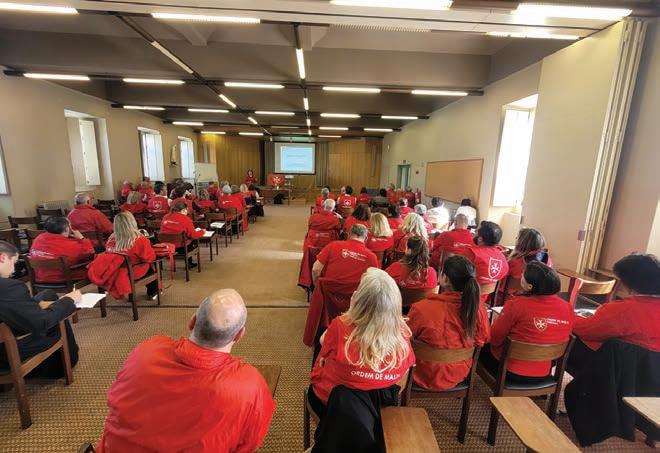

Santiago and in Santiago de Compostela in cooperation with the Spanish Association.
Since 1998, the Portuguese Association has been a Private Institution of Social Solidarity (IPSS), a status granted by the Portuguese State and published in the Diário da República (see annex).
As the name suggests, IPSSs develop social solidarity activities in areas such as social security, health, and education. rough a close relationship with the population and cooperation with the State, IPSSs aim to respond to social emergencies and support the most vulnerable citizens.
Legally, IPSSs are “non-pro t entities, established solely by private initiative, with the purpose of giving organised expression to the moral duty of justice and solidarity, contributing to the realisation of citizens’ social rights, as long as they are not managed by the State or other public entities”. eir activities include the provision of goods, services, and other initiatives that promote the well-being and quality of life of individuals, families, and communities.
Among the various activities developed by IPSSs are those carried out by the Portuguese Association, including:
• Support for children and youth, including those at risk
• Support for families
• Support for the elderly
• Support for people with disabilities and impairments
All the activities carried out by the Order of Malta in Portugal are in keeping with the charisms of our Order, which adds a spiritual dimension and Catholic faith
Photo credits: José Manuel S.N. Correia Alves
• Support for social and community integration
• Social protection for citizens in cases of illness, old age, disability, and death, as well as in all situations of lack or reduction of means of subsistence or work capacity
• Prevention, promotion, and protection of health.
In 2024, continuing in 2025, the Hospitaller activities carried out were:
Support for pilgrimages to Fátima and Santiago of Compostela
For the 48th year, the Order of Malta has been present on di erent routes that pilgrims take to reach the Sanctuary of Fátima. In May 2024, 14 xed service points were installed with teams of volunteers with training and knowledge in areas such as rehabilitation and providing treatments to pilgrims. e type of assistance provided ranges from treatment of the feet, legs or back, or the provision of a simple bottle of water or shade to rest. In areas with fewer pilgrims, the Order of Malta also has mobile teams of volunteers who go to the places where pilgrims rest and provide the necessary treatment. In addition to health care, the Order of Malta also provides spiritual assistance at xed posts whenever possible, with a Chaplain of the Order or a Priest celebrating daily Mass and being available for confessions. In May 2024, a total of 5,396 treatments were carried out in a campaign that involved around 148 volunteers.
Between the end of July and the beginning of August, a team of volunteers from the Order of Malta provided support to pilgrims arriving in Santiago de Compostela. is project materialises the protocol established between the Portuguese Assembly and the Association of the Order of Malta of Spain.
Support for the homeless
A team of volunteers from the Order of Malta, during 2024, provided support to homeless people in Porto. is assistance work carried out in collaboration with the Anjos Amigos group consisted of street actions, every Tuesday going through some streets in Porto, where people in that situation of need have been identi ed, and providing health care and identifying situations that require monitoring at the level of administrative processes.
On ursdays, the support provided consists of distributing food and clothing. In total, the Order of Malta accompanies around 150 people on each visit it makes. is number has been growing, both due to the worsening economic situation and due to a greater number of refugees arriving in Porto.
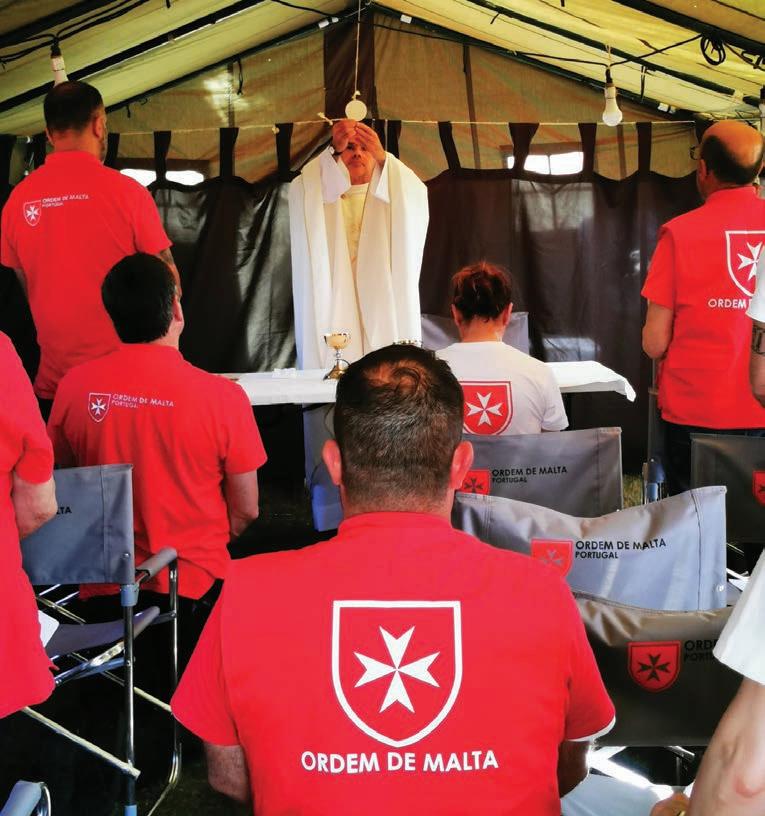
Collaboration with the Food Bank
e Order of Malta has supported the Food Bank against hunger in Lisbon, Porto, Coimbra and Braga. e Order of Malta participated in two Food Bank campaigns, in May and November. In these campaigns, teams of volunteers from the Order were deployed in supermarkets in these locations to collect food. Several dozen volunteers were involved. In addition to being present in supermarkets, there were also teams of volunteers present at the central warehouse in Lisbon, supporting the sorting and storage of collected food and other teams involved in transporting food between supermarkets and the central warehouse.
Support for needy families
e Order of Malta maintains constant work throughout the year to support needy families directly or through parishes that in turn support needy families. Support is given through the delivery of basic food baskets twice a month and, when necessary, support also includes the delivery of medicines, clothes and other necessary goods. At other special times
such as Christmas, Easter and the Day of the Poor, the Order of Malta supported dozens of families across the country, helping them to have slightly better celebrations.
Support for the Menino Deus Social Centre
During the year 2024, the support of the Order of Malta to the Menino Deus Social Center in Lisbon was provided in three components: food, health and education. In the food component, the Order of Malta provides supplies food products every week to ensure that the Social Centre canteen is able to provide meals to all the children who attend the Centre.
In terms of health, the Order of Malta’s support includes providing medication in identi ed situations and carrying out pediatric health screening for all children attending the centre. At an educational level, the Order of Malta has been present with the children of Menino Deus regularly, holding themed workshops to promote entertainment activities. At the beginning of the school year, the Order of Malta also provided all the school materials for the Centre’s educational activities.
Support for the elderly and sick
Several actions were carried out to deliver food, hygiene products and others, the highlights being: Support for the Little Sisters of the Poor, Porto through delivery of Christmas presents; and monthly nancial support to pay for electricity.
At the Home in Alhais (Viseu) the Order provides support through a Celebration of the Word and Extraordinary Minister of Communion, weekly on Sundays; daily visit to chat and interact; and Christmas gi with delivery of slippers for winter;
Also at Vila Cova a Coelheira Nursing Home we provide support through Viseu On Christmas Day, the volunteers of the Order of Malta and the Hospitallers promoted a moment of prayer with the distribution of Communion and took the image of the Baby Jesus to visit the elderly.
World Day of the Sick
On World Day of the Sick, some members and volunteers of the Order of Malta were present in some health establishments, namely the S. João Hospital Centre, the Hospital da Ordem Terceira de S. Francisco and the University Hospital of Coimbra, to help patients admitted to these establishments to attend the Eucharist.
Support and assistance to prisoners Penitentiary Pastoral During 2024, the Order of Malta provided assistance to prisoners in three prison establishments: Caxias, Belas and Viseu and Campo. Assistance to the prisoners consisted of periodic meetings with some prisoners to read spiritual texts and evangelisation. Whenever possible, help with the Eucharist or Celebration of the Word; o ers of hygiene items and some clothes; distribution of small Christmas gi s to prisoners, as well as Christmas cards to allow prisoners to communicate with their families.
Oral
Health Project
During 2024, the oral health project was continued through direct collaboration with the Faculty of Dental Medicine of the Catholic University of Portugal. e screening process was continued and, in some locations, oral health treatments have already begun. By the end of 2024, more than 120 children and adolescents were treated in locations in the northern interior of Portugal, where the Order of Malta was present with the old Commanderies, and where there are economic de ciencies and di culties in accessing clinics or health establishments to receive the necessary care. e next step will be to nish screening in this region and start oral medical treatments for the identi ed cases.
Medical assistance
e National Scout Corps (CNE), brought together around 1700 scouts in a regional camp, from 3-7 August. e Order of Malta set up an aid post to provide medical and nursing care to the Scouts attending the camp. Order of Malta volunteers were instrumental in resolving digestive issues and evacuating one participant to the local hospital.
MaltaCamp 2024
is year Portugal was present with a delegation with a young “visitor” and three young volunteers, two of whom were members of the Order of Malta. is presence of a Portuguese delegation at Malta Camp opened the doors for future presence of the Portuguese Assembly in new editions of MaltaCamp, as well as other types of youth initiatives within the Order of Malta at an international level.
Emergency Techniques and BLS Training
During 2024 two training courses in Basic Emergency Techniques were held by National Emergency Agency (INEM) under the protocol established with the Order of Malta.
At the same time, an internal training group was formed, made up of volunteer nurses from the Order of Malta, which is already developing training activities for the Order’s volunteers. During 2024, two training courses were carried out, one in Basic Life Support (BLS) and one in Pediatric Emergencies.
MaltaYouth Week 2024
e 1st edition of Malta Youth Week, which took place at Sintra, was a week organised by young people for young volunteers and members of the Order of Malta, with spiritual formation, prayer, history of the Order of Malta, a visit to the Sanctuary of Fátima, lots of fun and socialising and a Master Class on the experience of the Order’s charisms, led by the Grand Hospitaller of the Order of Malta, Fra’ Alessandro de Fraciscis.
During this rst edition of Malta Youth Week, young people from eight countries in Europe and North America were present. e experiences lived and the bonds created will be a foundation for these young people to be able to participate with greater commitment in the various functions and activities within the Order of Malta.
All these activities are carried out by the Portuguese Association in keeping with the charisms of our Order, which adds a spiritual dimension and Catholic faith.
Since 1998, the Portuguese Association has been a Private Institution of Social Solidarity (IPSS), a status granted by the Portuguese State and published in the Diário da República

BOOK REVIEW
e First 50 Years. A historical account of the Australian Association of the Order of Malta.
In the early 1970s, it is reputed that Grand Master de Mojana di Cologna said:
“Australia was one of the last continents where the Order did not already ourish”. More than 50 years later our current Grand master Fra’ John Dunlap would have a di erent story to share.
An exploration of the documents in the Grand Magistry’s archives shows an abstract of the Minutes of the Sovereign Council meeting of 18 October 1974 regarding the establishment of the Australian Association containing the names of the founding members. Further investigation into this initial list shows that Daniel Patrick O’Connell was the rst of these members admitted as a Knight of Magistral Grace on 8 October 1957 in Gremio Religionis (i.e. personally attached to the Grand Master). He

was then transferred to the category of Knight of Grace and Devotion by Decree Motu Proprio (Papal decree) on 8 November 1969.
In 1972 Ernest Kirby, a young Sydney solicitor born in Austria was received into the Hungarian Association as there was no Australian Association at this time. Ernest Kirby commenced the process of registering the Association in Australia but did not have the prerequisite of 15 eligible members.


ere was also opposition from several groups at the time including the St John’s ambulance.
On 25 April 1973, Victorian based Ambrose Galvin, the youngest of seven children, was invested into the Irish Association thanks to his brother Sir John Galvin’s membership of this association. Tasmanian-born Sir John Galvin, Baili Knight Grand Cross of Honour and Devotion





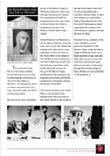




in Obedience was, during the 1970s, Grand Hospitaller of the Order.
One year later, in July 1974, two further members of the Galvin family, Mary Moore and Very Rev. Fr Peter Galvin OP were admitted into the Order. Mary became the rst Australian-born Dame of the Order, as a Dame of Honour and Devotion; Fr Peter as a Magistral Chaplain.
On 28 September 1974 in Sydney, a
provisional meeting was held of the members of the Order then living in Australia who were in Gremio religionis. As a result of that meeting the Australian Association was established by a decree enacted by the Prince and Grand Master and the Sovereign Council on 18 October 1974. In a later decree, of 15 March 1979, the Australian Association was extended to include New Zealand and Related Territories of Australia.
THE LOURDES EXPERIENCE
A minimum of 15 member is required by the Statutes of the Order for the formation of a National Association. e following were the foundation members of the Australian Association:
Dr Halley Charles Beckett
William Deane QC
Mgr. James Francis Delaney
Paul Desmond Fitzgerald AM
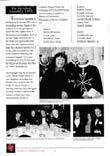




Fr. Peter Galvin OP
Ambrose omas Galvin
James Augustine Gobbo AC, CVO, QC
Dr. Ernest Joseph Kirby AM
Anne Kirby
Dr. Lionel Lockwood CBE
Dennis Leslie Mahoney QC AO
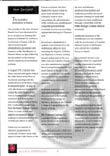

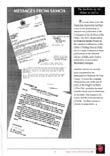

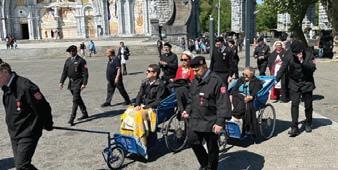
Reginald Joseph Marr DFC OAM QC
Mary Elizabeth Anne Moore
Prof. Daniel Patrick O’Connell RD QC
Dr. Nicolai Savoy-Soubotian
Seven members were from Sydney, six from Melbourne and two from Adelaide.
Cardinal Merry del Val &
THE LITANY OF HUMILITY
e Litany of Humility may not have been written by His Eminence Cardinal Merry del Val, but he would become renowned for embodying its spirit in both word and deed, living a life marked by self-denial, quiet service, and deep spiritual humility.
Cardinal Merry del Val, a recipient of the Baili Grand Cross of Honour and Devotion of the Sovereign Military Order of Malta, and a Servant of God, was born in London on 10 October 1865 and baptised the same year at the Church of St. James’s, Spanish Place.
He descended from an illustrious European lineage that included Irish, Spanish, English, Scottish, and Dutch roots. His father served as Secretary to the Spanish Embassy at the time of his birth. From an early age, Cardinal Merry del Val felt a strong call to the priesthood – an interior summons answered with astonishing speed and delity.
At just 22, Cardinal Merry del Val held responsibility for Papal Missions and was titled Monsignor before his priest ordination. By 34, he was President of the Ponti cal Ecclesiastical Academy. By 35, he became an Archbishop, and by 38, he was appointed Cardinal Secretary of State under Pope Saint Pius X, whom he stood alongside for 11 pivotal years. Notably, this period was during the Church’s confrontation with Modernism, a de ning theological and cultural battle of the early 20th Century.
Despite the grandeur of Cardinal Merry del Val’s o ce, his heart remained drawn to simple pastoral care. His motto, inspired by St. John Bosco was a plea for spiritual fruit over worldly recognition: Da mihi animas, caetera tolle (Give me souls, take everything else).
Cardinal Merry del Val’s obedience to the Church led him down a path of great responsibility. His personal piety went far beyond ritual. He wore a cilice beneath his robes as an act of penance and self-denial.
Cardinal Merry del Val died suddenly of appendicitis on 26 February 1930, in Rome, and was buried in the Vatican with St. John Bosco’s motto inscribed on his tombstone, as per his request. On the 23rd anniversary of his death, 26 February
1953, the Church opened his cause for beati cation, honouring a life marked by humility, devotion, and service – both to the Holy See and to the ideals of the Order of Malta.
One of the most enduring spiritual legacies associated with Cardinal Merry del Val and his family is the Litany of Humility, a powerful prayer attributed to him. ough its authorship is not con rmed, many believe he composed it, re ecting the spirit of profound humility that marked his life. Cardinal Merry del Val was known to pray the Litany of Humility daily a er Mass, which pleads for freedom from pride, vanity, and the desire for recognition – virtues he consistently lived out in public and private.
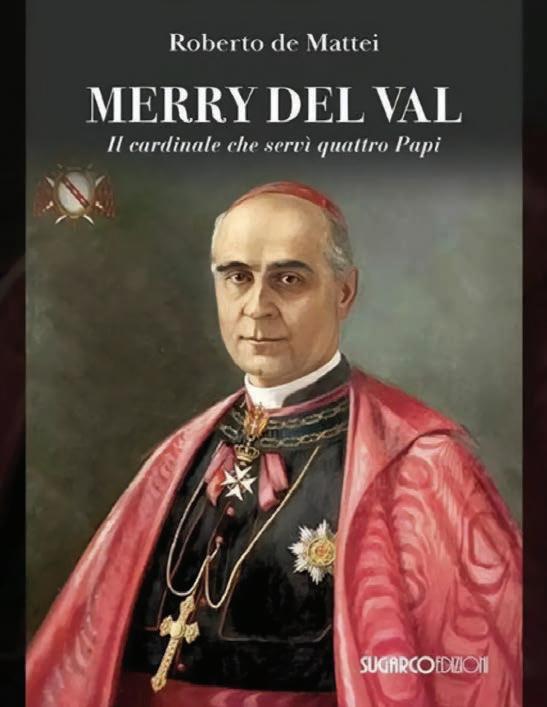
Today, the same historic church in which Cardinal Merry del Val was baptised, the Church of St. James, serves as a key venue for Companions of the Order, whom actively participate in the Order of Malta’s charitable outreach across Great Britain, including running evening cafés for the homeless and hungry. Cardinal Merry del Val’s distinguished a liation with the Order re ects both his noble heritage and his deep commitment to a life of Christian service.
Above: Professor Roberto de Mattei published his book: Merry del Val: e Cardinal Who Served Four Popes, to commemorate a benchmark gure in Church history at the beginning of the 20th Century.

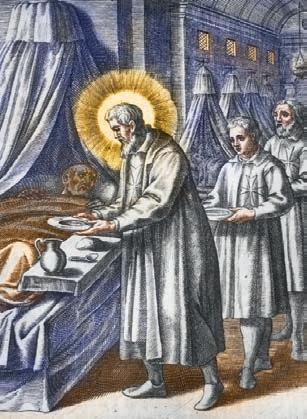
LITANY OF
HUMILITY
O Jesus, meek and humble of heart, hear me.
From the desire of being esteemed, From the desire of being loved, From the desire of being extolled, From the desire of being honored, From the desire of being praised, From the desire of being preferred to others, From the desire of being consulted, From the desire of being approved, From the fear of being humiliated, From the fear of being despised, From the fear of suffering rebukes, From the fear of being calumniated, From the fear of being forgotten, From the fear of being ridiculed, From the fear of being wronged, From the fear of being suspected,
That others may be loved more than I, That others may be esteemed more than I, That, in the opinion of the world, others may increase and I may decrease, That others may be chosen and I set aside, That others may be praised and I go unnoticed, That others may be preferred to me in everything, That others may become holier than I, provided that I may become as holy as I should,
Jesus, grant me the grace to desire it.
orderofmalta.org.au
GOD’S WORK Doing
Not Our Works
Written by Daniel Kwok KGCMG (Ob), Vice President and National Coordinator for Formation.
We are fortunate. In the Order of Malta, appointed members organise charitable projects for other members to engage in. ese are convenient opportunities for us to serve the poor and the sick, a commitment we make at our investiture. In Australia, members choose from a wide range of Hospitaller works – feed the homeless, distribute winter jackets to people sleeping rough, accompany the dying, sip tea with the lonely, coach reading skills, and comfort the domestically abused. Members even take on enormous responsibilities like managing a clinic in Timor-Leste, and later in 2025, serving in a 600-square-metre-facility in Southport, Queensland for the homeless and disadvantaged. Many also practice the virtue of charity in opportunities outside the Order, such as in parishes and in the ordinary events of daily life.
Naturally, there are members who nd constraints in their state of life to meet this commitment, even if they strongly desire to do so. ere is o en not much time and energy le a er meeting family, work, business, and other duties God has given them in their vocation. It seems genuinely impossible to engage in any of the Order’s works, or any other work of mercy for that matter. Self-exemption from our commitment then becomes justi able. For those in this position, a closer look at Scriptures may bring about a re-think.
Serving the needy is an act of obedience to God’s commandments Serving the needy should not be regarded as generous personal projects, even if we execute them, contributing time, e ort, and money. When thought of as “our work” there is tendency to be do-gooders paying back to the community or just to feel good about
ourselves. ese shallow approaches to charity are in fact self-serving.
All works of charity in the Christian sense are acts of obedience to what Jesus tells us are the greatest commandments:
“You must love the Lord your God with all your heart, all your soul, all your mind and all your strength…You must love your neighbour as yourself.”
(Mark 12:29-31)
e love for neighbour is intertwined with the love for God, making it a supernatural love that we give to fellow children of God in whom we see and meet God, and to whom the presence of God in us is seen.
“In truth I tell you, in so far as you did this to one of the least of these brothers of mine, you did it to me.”(Mt 25:40)
Jesus warns us to not neglect serving the least amongst us, which is the same as neglecting Him. Neglecting has eternal consequences. A scary proposition, as to those
who neglect, He will say:
“Go away from me, with your curse upon you, to the eternal re prepared for the devil and his angels.”
(Mt 25:41)
It would be foolish then to risk substituting the Order’s black robe with the rich man’s purple robe. (ref. Lk 16:19:19-21) It is of course di erent if one is unable to do anything at all for the needy. Such might be the case of one who is frail or sick, and in need. What is it that Jesus says we must do? He says,
“For I was hungry and you gave me food, I was thirsty and you gave me drink, I was a stranger and you made me welcome, lacking clothes and you clothed me, sick and you visited me, in prison and you came to see me.” (Mt 25:35-36)
One might argue that He did not mean doing administrative work, although that is necessary to enable the Order’s projects. We are to see the poor face to face, and in that, see Jesus face to face. We read that when James in his second letter says:


“How does it help, my brothers, when someone who has never done a single good act claims to have faith? Will that faith bring salvation? If one of the brothers or one of the sisters is in need of clothes and has not enough food to live on, and one of you says to them, ‘I wish you well; keep yourself warm and eat plenty,’ without giving them these bare necessities of life, then what good is that? In the same way faith, if good deeds do not go with it, is quite dead.” (Jm 2:14-17)
Do God’s work – be like the Good Samaritan Many members are graced by God with a generous measure of temporal gi s, and earthly priorities can dominate and consume attention and energy, or they may just be more attractive than spiritual priorities. What God gives to us are to accomplish His Will, not ours. Serving the needy is not something we do with residual resources or as a tick-of-the-box. It is best xed onto the fabric of our state of life. Duties to family and work need not be crowded out, although sacri ces will be asked of us and those close to us.
As you know, the Good Samaritan (Lk 10:25-37) disrupted his travel plans, applied First Aid to the half dead victim of banditry, carried him to safety and paid for a room at the inn with the promise to return to check on the man. Note that for every Good Samaritan, two passers-by passed by. ey had pressing priorities. Jesus ends this parable by asking the lawyer who sparked the conversation which of the three proved himself a neighbour to the seriously injured man. e lawyer replied, “ e one who took pity on him.” Jesus then says, “Go and do likewise.” He says that to us as well, whether we are members of the Order of Malta or not.
It is a matter of free choice that we respond to God’s commandments and do His work. And choosing yes when we don’t understand the how,

as Our Lady did, what is impossible, with God, becomes possible.
e Order of Malta, through projects for the needy and a rich program of liturgical activities, o ers a structure to assist us to ourish spiritually. When we partake of it, our lives as member will bear fruit.
Prayer: Lord, grant us the grace to do your work as your instruments for your glory.

Order of Malta members engage in charitable projects including preparing and serving food in kitchens, and connecting with the homeless and disadvantaged.
OBITUARIES
Over 2024, the Australian Association mourned the loss of six members. We record the life stories of those members: Ann Cullity, Fr Gerald Glynn O’Collins AC, Fr Matthew Jongchan Byeon, Hon Peter Gresham ONZM, Hon Kevin Andrews, AC, and Monsignor Vincent Redden.
FR GERALD GLYNN O’COLLINS SJ AC (1931 - 2024)
I rst met Gerald O’Collins in 1971 when I was a seminarian at Corpus Christi College Glen Waverley in what was then called First Year eology. He was a young and rather glamorous teacher of theology who seemed to know everything and everyone. ose were the days when he was teaching half the year in Boston and half the year in Melbourne; and that added to the sense of glamour and excitement.
Fr O’Collins taught one of the three most in uential courses in my seminary training, Fundamental eology or, as it became under Gerry, the Foundations of eology, which was really the theology of revelation. He opened to us the great vision of the Second Vatican Council’s teaching on Revelation. He taught us that Jesus was the revelation; and that for me was…well, revelatory. Gerry made theology seem not only relevant but exciting; and he also gave us a sense of the Church universal, which was itself exciting and even liberating.
Gerry was a great encourager. It was he who suggested that I submit an essay I’d done for him for publication in Compass is seemed a bridge too far for me, but I followed his advice. e piece was published and thus began my modest publishing career. rough the years Gerry not only taught his students: he befriended them. at’s why many of those he taught and mentored became his lifelong friends. Beyond the academic setting, his gi for friendship was one of the reasons why he was such a remarkable networker. at was why Rome, still one of the great global crossroads, suited him so well.
I crossed paths with Gerry again when I went to study in Rome at the Biblicum in 1980. He had already been teaching for some years at the Gregorian University, just across the piazza from the Biblical Institute. I met him o en enough in the piazza or at various celebrations, and he was an unfailing source of encouragement in those early years when adjustment to Roman life wasn’t always easy.
At the Gregorian, Gerry was known for

various things, a part from his teaching of theology and the ow of his publications. He was known for his celebrated Australian accent when he spoke Italian. He knew the language as well as anyone; it’s just that the sound was pure Chips Ra erty. But more importantly he was known as a teacher who had a genuinely pastoral concern for his students, which was unusual in the Roman universities at that time. is was another aspect of Gerry’s gi of friendship.
Later in life when I was asked to work in the Holy See’s Secretariat of State, I crossed paths with Gerry once again. He was as much a man of the Church as he had always been, but his dealings with the Holy See had grown more complex, especially a er the sanctioning of Fr Jacques Dupuis SJ to whom Gerry was close. It was always puzzling to me that Gerry was never appointed to the International eological Commission where he would have contributed so well.
In those years I met him mainly at the table of Desmond O’Grady, the Australian writer and journalist who had long lived in
Rome. Des was a friend to us both who was deeply interested in the Church but very much a man of the wider world. at was also true of Gerry who was always a Church man but never an ecclesiastical apparatchik. He was given to theology but not to ideology. A son of St Ignatius, he believed in the dialogue with culture and was at home in any company.
Gerry’s ceaseless writing, like his teaching, rose from a lifelong encounter with Jesus Christ cruci ed and risen. He seemed almost haunted not just by the question of Jesus but by the presence of Jesus. He also seemed one who needed a manuscript under way in order to give shape and direction to his life, both intellectually and spiritually. He had the training of a systematic theologian but the instincts of a New Testament scholar; and he also had the journalist’s ability to write accessibly and attractively. at was an unusual and potent combination which gave Gerry a voice that will be heard beyond his death.
Above all, however, Gerald O’Collins was a Jesuit priest who understood what it was to give his life “for the greater glory of God”. Pope St Paul VI said that people these days “listen more willingly to witnesses than to teachers, and if they listen to teachers it is because they are witnesses” (Evangelii Nuntiandi, 41). In bidding farewell to Fr Gerald O’Collins SJ, we give thanks for one to whom people listened because he was both teacher and witness, priest and friend. May he rest in peace and rise in glory.
Much loved Fr Gerry served the Order of Malta as Chaplain from 17 October 2009. He was appointed the Principal Chaplain of the Subpriory of the Immaculate Conception and directed its Melbourne retreat annually for more than 10 years. He was an avid presenter on the Order’s “Hour of Re ection with a Chaplain Series” even as his health was declining.
Written by e Most Reverend Mark Coleridge, Archbishop of Brisbane and chief chaplain of the Order of Malta Australia.
ANN CULLITY DMG (1929 - 2024)
WA Order Member Confrère Michael Shanahan advised the Australian Association of much-loved WA Consouer, Mrs Ann Mary Cullity, passing on June 2, 2024.
Ann Cullity went to Our Lord on 2 June 2024. She entered the Order of Malta on 21 May 2002. She served the Order with gentleness and deep commitment with Denis, her husband, who was admitted as a Member of the Order on 17 June 1997.
Ann and Denis, whose passing preceded Ann on 4 September 2022, received Papal Honours at St omas More College on 14 September 2008. In a presentation speech by His Grace Archbishop Hickey, he beautifully encapsulated Ann’s deep commitment to the Catholic Church, including the
Order of Malta.
“I could read out a long list of causes, charities and education projects they have supported, but I know I would never have a complete list. e spirit of the call to mission is made clear in Vatican II”s Gaudium et Spes – the Church in the Modern World. e Church’s voice has been heard by Denis and Ann in their sense of mission.”
In Ann’s death and now in God’s gentle care, Michael is reminded of the Scriptures, Philippians 1:3-5: Every time I think of you, I give thanks to my God. Whenever I pray, I make my requests for all of you with joy, for you have been my partners in spreading the Good News about Christ from the time you rst heard it until now.
FR MATTHEW JONGCHAN BYEON (1967 - 2024)
Fr Matthew Jongchan Byeon passed into Eternal Rest on 12 August 2024 at the age of 57 a er a long period of illness, parts of which were quietly borne while continuing to serve the Church and members of the Order of Malta in Korea.
Even though they were aware of Fr Matthew’s illness, members were struck with deep grief as they had grown close to him from the many times, he assisted them with their spiritual development and liturgical services.
Fr Matthew was born on 11 August 1967 in Janghang,Chungcheongnam-do, South Korea. He was ordained a priest on 16 July 1993, and soon a er appointed as Vicar of the Wolgok-dong Parish. At the end of 1995 he furthered his studies in Italy.
He was appointed Vicar of Sindang Parish in 2006 and later in the same year,
Professor at Catholic University.
In October 2016, the Order was blessed to have Fr Matthew appointed the rst Magistral Chaplain in South Korea. He served ably with great dedication, running annual retreats and saying Mass regularly. He accompanied members to the annual Lourdes pilgrimage in 2019 and said Mass at the Grotto of our Lady.
He conversed uently in Italian with the High Charges who attended the Asia Paci c Conference held in Seoul in 2015. In the same conference in 2023, his health limited his activity. While he was able to MC the Investiture Mass, he was unfortunately too weak to be at the conference and was missed by those who knew him.
Matthew’s Funeral Mass was held on 14 August 2024 at Myeongdong Cathedral.


e Sovereign Military Hospitaller Order of Saint John of Jerusalem, of Rhodes and of Malta mourns the loss of the Hon. Peter John Gresham, KMG, ONZM, JP, FCA, a distinguished Knight of the Order of Malta, who passed away peacefully on 31 August 2024 at the age of 91, in Whanganui, New Zealand.
Peter John Gresham was a remarkable man. His arrival in this world was quite remarkable and that is how he continued throughout his earthly life. Born on 7 July 1933 in Geraldine, South Canterbury, New Zealand. e 10th child of Captain
James Gresham and Harriett Gresham (nee Mitchell). When baby Peter was born, James was in his 62nd year and Harriett was in her 47th year.
Peter was a rst day pupil of All Hallows Convent School, Geraldine, becoming the school’s rst Dux. Peter attended high school as a boarder at St Kevin’s College (Christian Brothers), Oamaru. A er school, Peter joined the ANZ bank in Timaru, eventually moving to Wellington as an auditor. During 1956 to 1958 he was transferred to the ANZ Bank in Fiji. He returned to Hastings with the ANZ Bank and in 1961 married Margot
Read in Whanganui. While in Hastings, Peter passed his Accountancy Examinations. In 1964, the family moved to Waverley where he joined the accountancy rm, A.R. Glen. e following year he became a partner and the rm was then known as Glen and Gresham, Accountants. e rm continues today as Moore Markhams. Along with his Chartered Accountancy career, Peter was considered a pioneer in the forestry industry. He also served on the board of the Petroleum Corporation of New Zealand Limited (Petrocorp) as a director and company secretary. He was also a Vice
THE HONOURABLE PETER GRESHAM KMG ONZM JP FCA (1933 - 2024)

President of the New Zealand National Party, the major centre right political party in New Zealand.
His commitment to serving others led him to a notable political career as a Member of Parliament for the New Zealand National Party. Peter entered Parliament at the age of 57, representing the electorate of Waitōtara from 1990 to 1996. He continued to serve as a list member from 1996 to 1999. Such was Peter’s reputation that immediately upon being elected to Parliament he was appointed to Chair of the Finance and Expenditure Committee, Parliament’s most powerful committee. During his tenure, he held the positions of Minister of Social
MONSIGNOR VINCENT
Welfare and Minister for Senior Citizens, advocating tirelessly for the wellbeing of the community.
A er leaving Parliament, Peter continued to serve, elected as the President of the Association of Former Members of the New Zealand Parliament.
Peter and Margot Gresham were among the rst members of the Order of Malta in New Zealand. e pro le, relationships and service given to the Order in New Zealand by both Peter and Margot provided a standard by which to attract new applicants to the Order and examples of patronage for other members to follow. No doubt their hands-on work with the poor and the sick inspired many. Peter and Margot were very generous supporters of the Order’s Clinic in Dili, Timor Leste.
In recognition of his extensive public service, Peter was appointed an O cer of the New Zealand Order of Merit in 2002.
Peter was predeceased by his beloved wife, Margot, a Dame of the Order, in 2022, a er 61 years of marriage. ey are survived by their six children, 16 grandchildren, and two great-grandchildren, all of whom were a source of immense pride and joy for them.
A Requiem Mass celebrating Peter’s life was held on 5 September 2024 at St Mary’s Catholic Church in Whanganui, attended by family, friends, and members of the Order
REDDEN (1937 - 2024)
Monsignor Vincent Redden, Magistral Chaplain to our Order and a friend and spiritual advisor to many passed into eternal life with our Lord on 9 October 2024. Monsignor Vince had been living with serious health challenges for some time.
A er a recent admission to St Vincent’s Hospital and despite some improvement in his condition, he deteriorated suddenly on the 9 October at the age of 87. Monsignor Redden’s life is a testament to our Faith and the importance of family and relationship within our broader community.
Monsignor Vince was born in 1937 to Margaret and omas Redden, the youngest son in a farming family of seven. He was educated at St Ignatius College, Riverview. He completed studies at Springwood and Manly and was ordained a priest on 15 July 1961 by Cardinal Gilroy.
He was a leader and mentor among the priests of the Sydney Archdiocese over many decades. He served as Assistant Priest in numerous parishes, then as Parish Priest of Ryde, Dean of the Cathedral, and Parish Priest of Drummoyne until his retirement in 2018. He held many leadership positions,
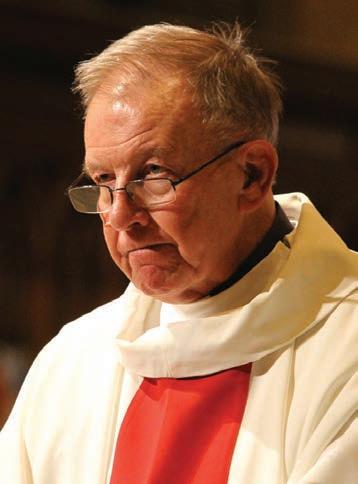
including Chair of the Committee for Ongoing Formation of Clergy, Chair of the Archdiocesan Schools Advisory Board and, for many years, he was the Episcopal Vicar for Clergy from 2002 to
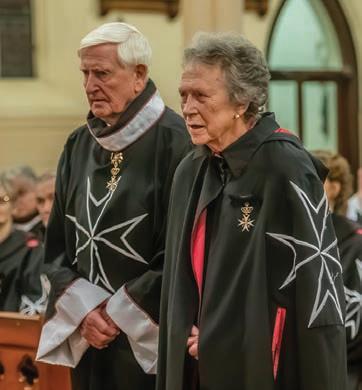
of Malta and the community he served so faithfully. e celebrant was Rev Fr John Roberts OStJ, District and Area Chaplain for the Venerable Order of St John. e Order of Malta extends its deepest condolences to the Gresham family and acknowledges both Peter and Margot’s unwavering commitment to the Order’s mission. eir legacy of service, faith, and compassion will continue to inspire all who had the privilege of knowing him.
Written by Bevan Killick KMG, NZ Hospitaller and Great Nephew.
his retirement. Monsignor Vince’s service included extended time as the Army Reserve Chaplain attached to the Commando Unit at Middle Head (inclusive during various signi cant manoeuvres and involving many parachute jumps).
As Dean of St Mary’s Cathedral for a time, he was responsible for St Pope John Paul II’s comfort and care during his stay at Cathedral House in 1995 for the beati cation of Mary Mackillop.
Even during the last few years, when Monsignor Vince’s breathing was severely compromised, he was always present at clergy conferences, retreats, and said Masses for the Order. He was accepting of his physical limitations and always remained at peace and thoughtful of others. His positive attitude and support for clergy and others was evident to us all.
May he now share fully in the Life of the Resurrection promised by his Lord whom he served so faithfully. We extend our condolences to his family and close friends. May he rest in peace.
Written by A/Professor Maria Cigolini DMG.
THE
HONOURABLE KEVIN ANDREWS AC KMG (1955 - 2024)

Kevin Andrews passed away peacefully on 14 December a er a year-long battle with cancer, with his wife of 45 years Margaret, by his side.
Former Prime Minister Tony Abbott, who announced Kevin’s death on behalf of his family, made his own statement commending him as a “ ne Australian, a highly e ective minister, a loyal colleague, and a great friend”.
Kevin is remembered as a man of character, conviction and courage. MPs across the political spectrum o ered their condolences to the Andrews’ family.
A federal member of Parliament for 31 years representing the seat of Menzies in Victoria, he was honoured with a State Funeral held at St Patricks Cathedral Melbourne, with a liturgy concelebrated by Archbishops Comensoli and Fisher on 23 December.
Tony Abbott delivered the eulogy to a full St Patrick’s Cathedral, describing his former colleague as “a gentleman who never stooped to the dark arts of politics”. Opposition Leader Peter Dutton came to pay tribute, along with former Prime Minister John Howard. Prime Minister Albanese noted that both sides of the bench would agree Kevin was a “man of conviction; with outgoing Labor minister Bill Shorten representing the Prime Minister at the funeral. “Kevin Andrews dedicated his life to the things he cared for most – family, faith, community and nation,” Albanese said in a statement.
John Howard paid tribute to Kevin, saying he was a “devout practicing Catholic, guided and sustained throughout his life by his strong Christian faith”.
In parliament, Kevin served at various times as minister for defence, social services, immigration, ageing and workplace relations. He introduced the Andrews Bill in 1996, preventing euthanasia being practiced across Australia for the next 20 years, and advocated strongly for family values and opposed abortion, same-sex marriage and stem cell research. Predating his time as a minister, the Andrews Bill was “one of his nest achievements”, Abbott said.
“Kevin was honourably and consistently committed to the sanctity of human life. He understood the critical di erence between declining to keep alive someone who would otherwise be dead and deliberately killing someone who would otherwise be alive. He was also a strong supporter of the palliative care services that, at their best, mean that no one need die in severe pain.”
Before entering parliament in 1991, and a er studying law at Monash and Melbourne University, he was an associate to Sir James Gobbo at the Supreme Court of Victoria and then spent six years as a barrister.
However, while much of the accolades for Kevin re ected his extensive contributions to public life, Kevin had a parallel and equally active parallel life working tirelessly in the Catholic Church with his main focus in the area of Marriage and Family life; a mission he shared with
his wife Margie of 45 years. Together they provided leadership in Catholic marriage education in Melbourne. He was a consulter to the Ponti cal Council for the Family between 2007 and 2014, a member of the Catholic Ponti cal Council for the Laity, an Adjunct Lecturer in Politics and in Marriage Education in the John Paul II Institute for Marriage and Family in Melbourne and an advisor to the Board of Life Decisions International (LDI). At the time of his passing into eternal life he was serving on the council of Newman Catholic College at the University of Melbourne and as a director of Villa Maria Catholic Homes.
Melbourne Catholic Archbishop Peter Comensoli posted on social media that it was with “deep sadness” he received news of Kevin’s death.
“Among so many gi s he shared, there were three dimensions to Kevin’s life that were quite extraordinary: he was a man of deep and remarkable faith; a man committed wholeheartedly to marriage and family; and a man of dedicated public service. May the saints and angels go out to welcome Kevin, this good and faithful servant, to eternal life,” he wrote.
Kevin was devoted to wife Margaret and their ve children. In his eulogy, Mr Abbott noted that “I can’t think of any MP who surpassed Kevin as a husband and a father. And Margie has been a great partner, not just in Kevin’s parliamentary and electorate work, but also in the marriage guidance service that they both provided together to other couples over many years”.
Notwithstanding the heartachingly early loss of her husband of 45 years, Margaret said: “My beautiful husband was courageous and uncomplaining to the end…He leaves a proud legacy of service to his family, his country and his faith, which has sustained him always, but particularly in recent times. We are deeply proud of his service to our country, our local community and his party, although shattered by his death a er a year-long battle with cancer”.
Kevin will be remembered as a sel ess worker for others. In his valedictory speech given in March 2022, he said he had given up a law career to pursue his vocation in public life: “A career is about the individual; a vocation is about a cause. My cause has been the peace, the welfare, and the happiness of the people of Australia.”
For the many of us who knew Kevin well, let us both celebrate the example of ‘a life well spent’, and pray for the repose of his soul and the wellbeing of his family.

The Malteser International website: www.malteser-international.org SOVRANO
The Order’s website in Australia: www.orderofmalta.org.au /orderofmalta.org.au /orderofmaltaau


The Order’s international website: www.orderofmalta.int
Giorgio Vasari, Natività, 1538, Chiesa Del Monastero Di Camaldoli (AR)
